
Editorial
Notebook
Darcy
at Her Days’ End
By VERLYN KLINKENBORG
December
18, 2009
Not
quite 15 years ago, my wife adopted a mixed-breed puppy she
found tied to a storage tank behind  a
gas station in Great Barrington, Mass. I say she adopted it
because I wasn’t quite sold on the idea. We had a new
pup already — a border terrier named Tavish —
and this gangly new addition looked, in comparison, like a
badly made dog. Darcy’s feet were too small for her
body, her hind knees were weak, and her coat made her look
like a wire-haired golden retriever. a
gas station in Great Barrington, Mass. I say she adopted it
because I wasn’t quite sold on the idea. We had a new
pup already — a border terrier named Tavish —
and this gangly new addition looked, in comparison, like a
badly made dog. Darcy’s feet were too small for her
body, her hind knees were weak, and her coat made her look
like a wire-haired golden retriever.
But who ever loved a dog less because it was ugly?
And now, suddenly, it’s all these years later. Darcy
still lies on the lawn, basking like a lioness, and barks
at the pickups going up the road. Much of the day she still
has the look of an indomitably gratified mutt. But there are
hours now when her eyes, a little misty with cataracts, seem
worried, hollow. And she has stopped eating, or rather, she
eats with deliberation and reluctance, a spoonful of this,
a forkful of that.
Which means that now is the time for a hard decision. According
to the vet, there are no signs of disease, other than the
disease of age — nothing to force our hand. When Tavish
died, four years ago, his liver was failing, and there was
no choice but to sit on the floor and hold him while the vet
inserted the final needle. It’s somehow not surprising
that Darcy raises the matter of our responsibility in its
purest form.
I’ve known too many owners who waited far too long to
put their dogs to sleep, and I’ve always hated the sentimentality
and the selfishness in their hesitation. Last week, watching
Darcy out in the sun, it felt as though I was trying to decide
just when most of the life — the good life, that is
— inside her has been used up. Is it conscionable to
wait until it’s plainly gone? Or is it better to err
on the side of saying goodbye while she’s still discernibly
Darcy, while she seems, as she nearly always does, to be without
pain?
It comes down, in the end, to the pleasure she shows, the
interest she takes in the world around her — and not
to anything her humans feel. She has not had the life she
might once have expected — a far better one instead.
My job is to make sure she gets the death she deserves —
in her human’s arms.
And so she has. She died quietly last Friday while I sat on
the floor beside her at the vet’s.
The
world is a poorer place without her.
|
EUTHANASIA
IS SCARY
Your
BEST FRIEND has
always been there for you.
BE
THERE!
|
|


The
Wisdom of Otto, a Four-Legged Elder
By MICHELLE SLATALLA
December
24, 2009
Friday
is Otto's birthday. He was a Christmas puppy, and when we
met him a few weeks later at the 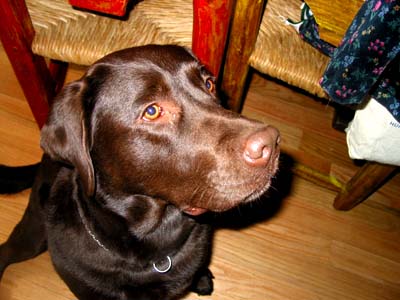 breeder's
house, he was leaping into the air like a tiny porpoise to
catch liver snacks. This was in 1999, and his commitment to
food had not waned ... until one day last week. breeder's
house, he was leaping into the air like a tiny porpoise to
catch liver snacks. This was in 1999, and his commitment to
food had not waned ... until one day last week.
"He
actually slept through a meal?" I asked my husband in
disbelief.
"And snack," my husband confirmed grimly.
We were standing in the doorway of the living room, where
we could see one large brown Labrador retriever sprawled across
his favorite love seat, a particularly filthy, dog-hair-covered
couch that not so long ago had been a very expensive piece
of furniture upholstered in a light-colored fabric.
That was before it became more of a hospital bed for Otto,
who in his dotage suffers from a long list of maladies including
but not limited to arthritis, recurring ear infections, fatty
tumors, failing eyesight and a possible thyroid deficiency.
He gets up only when called upon to fulfill his contractual
duties, which include greeting anyone who comes to the front
door as if they had been presumed dead. Also, he investigates
anything that sounds like the opening of the refrigerator,
shopping bags or cans.
But now, he was snoring. Sort of. It was actually more of
a strangled rattle. And he was drooling in his sleep. "Maybe
he's dreaming about eating," I said hopefully.
My husband was dubious. "What's going on with his head?"
he asked. "It looks dented."
It is really hard when your dog gets old. Maybe not for the
dog - Otto seems more stoic and dignified than ever - but
definitely for the humans who live with him. We remember the
glory days when he slobbered on tennis balls, knocked over
wineglasses with his tail and rolled on the carcasses of dead
field mice to perfume himself for us, his pack. And we only
wish that era had lasted a lot longer. Like, say, 80 years.
Human
lives follow a certain trajectory; you come full circle. You
move from infancy to become a child, then make your parents'
lives a living hell during your teenage years, then achieve
adulthood (when your aging parents get to make your life a
living hell) until finally, if you live long enough, you get
to make your children's lives a living hell.
With dogs, it's different. After you watch them grow from
puppies - your babies, your children - into adults, you start
to notice something miraculous. Because they age much faster
than humans, dogs attain wisdom much more quickly. They outpace
you on that front until suddenly it's 11 years later, and
as you are still running around, fretting about the children,
your job and where you left your car keys, you notice that
your dog is looking at you with such forgiving, patient eyes.
You almost feel like he's gone from being your baby to becoming
your grandparent.
"His skull does look kind of dented, now that you mention
it," I said. My husband Googled "dented dog skull"
and came up with prognoses that ran the gamut from parasites
to brain cancer.
"Maybe we should take him to the vet," I said, which
was code for, "You should take him to the vet."
My husband went to search for Otto's truss, a complicated
black girdle that makes him look like an apartment superintendent,
with its many straps that cinch under his chest and around
his legs. It has a handle so you can lift him like a suitcase
and put him into the back of the station wagon. If you can
lift an 85-pound suitcase. An hour later, I heard the car
pull into the driveway. My husband came into the kitchen.
"How bad?" I asked.
He said with a sigh that it was $280 so far.
"No, I mean what's wrong with the dog?"
"He
was just so amazing to watch," my husband said. "They
prodded him, they poked him, they took his temperature, they
took blood, they biopsied some of his fatty tumors. And the
whole time, he just kept thumping his tail. You know this
stuff must have been really uncomfortable, but he acted like
he was getting a massage."
My husband stopped; he was choked up. "It actually gave
me hope," he said.
"What do you mean?"
He coughed, delicately, tentatively. "I have a terrible
head cold," he said. "But now, watching Otto's incredible
bravery, I suddenly have the courage to get through this thing."
That night, we fussed over Otto, hoping he didn't have a malignant
tumor, permanent facial paralysis, scary nerve-system degeneration
or any of the other possibilities the vet mentioned. Being
the center of attention lifted Otto to a higher place. He
thumped his tail on the floor. And he beamed at us, thrilled,
as if he were a slightly stinky emissary from the planet Love.
This attitude, too, is different from that of most humans
as they get old.
"I will never put Otto in a nursing home," I vowed
to my husband.
He asked what in the world was I talking about.
The next day, the vet called with the test results. "We
can't find anything wrong with him," she said. "How
does he seem to you?"
"Old," I said.
"Well, can he still do the things he loves?" she
asked.
I glanced at the stains on the rug, at the hair balls skittering
across the floor, and I looked through the living room doorway,
where I caught Otto's (good) eye. He lifted his head, expectantly,
slithered off the sofa and limped over to me. I immediately
understood the look.
"Yes,
actually, I think he's feeling better," I said.
I
opened the refrigerator, found a dry hunk of salami and pitched
it in the air. With hardly any effort at all, Otto rose up
and snatched it, like Namu the Killer Whale. Then he settled
down for a nap on what used to be my best sofa.

Illustration:
Hadley Hooper


Cindy
Adams
December 18, 2009

Besides
Yankee striped uniforms, rubber rain booties and hoodie pajamas,
the newest holiday gigt for Park Avenue Puppies? Leg warmers.


Vermont Court Eyes Value of Love of Man's Best Friend
By DAVE GRAM
Dec
17, 2009
MONTPELIER, Vt. — Vermont's highest court is being asked
to decide what a dog's love is worth.
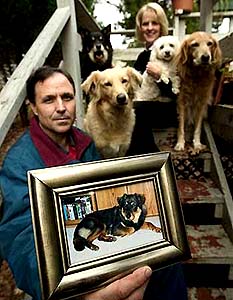 The
state Supreme Court on Thursday was to hear a case that began
in July 2003, when Denis and Sarah Scheele (left
with photo of Shadow), who were visiting
relatives, let their mixed-breed dog wander into Lewis Dustin's
yard and he fatally shot it. Now the Scheeles are asking the
court to carve out a new legal doctrine that a dog's owners
can sue for emotional distress and loss of companionship,
just like parents can when they lose children. The
state Supreme Court on Thursday was to hear a case that began
in July 2003, when Denis and Sarah Scheele (left
with photo of Shadow), who were visiting
relatives, let their mixed-breed dog wander into Lewis Dustin's
yard and he fatally shot it. Now the Scheeles are asking the
court to carve out a new legal doctrine that a dog's owners
can sue for emotional distress and loss of companionship,
just like parents can when they lose children.
"We're still working toward having the courts recognizing
the true value of companion animals. They're members of the
family, not mere property," Sarah Scheele, 58, said from
her home in Annapolis, Md., on Wednesday before flying north
for the court hearing.
Dustin's lawyer, David Blythe, said Dustin never intended
to kill the Scheeles' dog, Shadow, and "has always regretted
that it happened." He said Dustin fired an air pellet
rifle at the dog in hopes of scaring it off the lawn of his
home in Northfield, a community of about 6,000 residents just
south of Montpelier in the heart of the state's Green Mountains.
The shot Dustin fired penetrated the dog's chest and severed
an aorta, and the dog died on the way to a veterinarian's
office.
Dustin, 76, has said he was aiming at the dog's rear end.
He did not immediately return a telephone call seeking comment
Wednesday. He pleaded guilty to a misdemeanor charge of animal
cruelty and was given a year probation. He also was ordered
to perform 100 hours of community service and pay $4,000 in
restitution to the Scheeles.
But the Scheeles weren't done. Sarah Scheele gave up her work
as a meeting planner and has devoted her time since the dog's
death to advocating for animal welfare and caring for the
six special-needs dogs — most of them abused in the
past — the couple has adopted in recent years. Denis
Scheele, 50, continues to work as a plumber.
The Scheeles filed a civil suit against Dustin, pressing their
claim that Shadow was more than a piece of property and that
they could not be compensated just with reimbursement of what
they paid to adopt him from an animal shelter, the veterinary
bill that resulted from the shooting and the cost of his cremation.
Blythe, who owns a poodle and a maltipoo, said he would be
very angry if someone shot one of his dogs. But he argued
that the Scheeles aren't entitled to the legal remedy they're
seeking. Historically, laws across the country have limited
sharply the ability of plaintiffs to collect damages for emotional
loss. A parent can sue for emotional damage from the loss
of a child, but a grandparent cannot for the loss of a grandchild
under Vermont law, Blythe said. "If the court carved
out this exception in the common law, it would put pet owners
in a position that grandparents are not in terms of recovering
emotional-distress damages," he added.
The court earlier this year ruled against a plaintiff seeking
to collect for emotional distress when a cat's death resulted
from a veterinarian's medication error.
One of the Scheeles' lawyers, Heidi Groff, said this case
is different because Dustin acted with intent and malice when
he shot Shadow. "All previous (Vermont) cases that have
presented this issue have involved negligence," Groff
said, "and we have something that we think is a great
deal more serious than that."
The Scheeles are particularly devoted pet owners. They feed
their dogs human food, brush the dogs' teeth and dress them
in raincoats when it's wet outside. On a Web site devoted
to Shadow's memory, they wrote, "Every day without you
running and playing and cuddling with us is more difficult
than the day before. The loss of your presence in our every
moment is unbelievably painful. Not a moment passes that you
are not in our thoughts, our hearts and our prayers."


ASPCA
Shined First Light on Abuse of Children
By HOWARD MARKEL, M.D.
December
15, 2009
“Mamma
has been in the habit of whipping and beating me almost every
day,” the little girl testified. 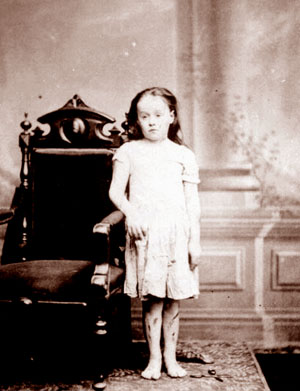 “She
used to whip me with a twisted whip — a rawhide. I have
now on my head two black-and-blue marks which were made by
Mamma with the whip, and a cut on the left side of my forehead
which was made by a pair of scissors in Mamma’s hand;
she struck me with the scissors and cut me. ... I never dared
speak to anybody, because if I did I would get whipped.” “She
used to whip me with a twisted whip — a rawhide. I have
now on my head two black-and-blue marks which were made by
Mamma with the whip, and a cut on the left side of my forehead
which was made by a pair of scissors in Mamma’s hand;
she struck me with the scissors and cut me. ... I never dared
speak to anybody, because if I did I would get whipped.”
The quotation is from the 1874 case of Mary Ellen McCormack,
below, a self-possessed 10-year-old who lived on West 41st
Street, in the Hell’s Kitchen section of Manhattan.
It was Mary Ellen who finally put a human face on child abuse
— and prompted a reformers’ crusade to prevent
it and to protect its victims, an effort that continues to
this day.
Tellingly, the case was brought by the American
Society
for the Prevention
of Cruelty
to Animals
. In 1874, there were no laws protecting children from physical
abuse from their parents. It was an era of “spare the
rod and spoil the child,” and parents routinely meted
out painful and damaging punishment without comment or penalty.
Mary Ellen had been orphaned as a baby. Her father, Thomas
Wilson, was a Union soldier who died in the Second Battle
of Cold Harbor, in Virginia. Her mother, Frances, boarded
the baby with a woman living on Mulberry Bend, on the Lower
East Side, while working double shifts as a laundress at the
St. Nicholas Hotel.
This arrangement cost $2 a week, consuming her entire widow’s
pension. When she lost her job, she could no longer afford
to care for her daughter and was forced to send her to the
city orphanage on Blackwells Island.
A few years later, Mary Ellen was adopted by a Manhattan couple,
Thomas and Mary McCormack. But Thomas died soon after the
adoption, and his widow married Francis Connolly. Unhappy
and overburdened, the adoptive mother took to physically abusing
Mary Ellen.
Sometime in late 1873, the severely battered and neglected
child attracted the attention of her neighbors. They complained
to the Department of Public Charities and Correction, which
administered the city’s almshouse, workhouse, insane
asylums, orphanages, jails and public hospitals . Even the
hard-boiled investigator assigned to Mary Ellen’s case,
Etta Angell Wheeler, was shocked and became inspired to do
something.
Frustrated by the lack of child-protection laws, Wheeler approached
the ASPCA
It proved to be a shrewd move. Mary Ellen’s plight captured
the imagination of the society’s founder, Henry Bergh,
who saw the girl — like the horses he routinely saved
from violent stable owners — as a vulnerable member
of the animal kingdom needing the protection of the state.
Bergh recruited a prominent lawyer, Elbridge Gerry (grandson
of the politician who gave his name to gerrymandering), who
took the case to the New York State Supreme Court. Applying
a novel use of habeas corpus , Gerry argued there was good
reason to believe that Mary Ellen would be subjected to irreparable
harm unless she was removed from her home.
Judge Abraham R. Lawrence ordered the child brought into the
courtroom. Her heart-wrenching testimony was featured in The
New York Times the next day, April 10, 1874, under the subheading
“Inhuman Treatment of a Little Waif.”
“She is a bright little girl,” the article said,
“with features indicating unusual mental capacity, but
with a careworn, stunted and prematurely old look. Her apparent
condition of health, as well as her scanty wardrobe, indicated
that no change of custody or condition could be much for the
worse.”
Ms. Connolly was charged and found guilty of several counts
of assault and battery. Mary Ellen never returned to her adoptive
home, but her temporary placement in a home for delinquent
teenagers was not much of an improvement. In a lifesaving
act of kindness, Etta Wheeler, her mother and her sister volunteered
to raise Mary Ellen in bucolic North Chili, N.Y., outside
Rochester.
At 24, Mary Ellen married Louis Schutt. The couple had two
children of their own, along with three children of Schutt’s
from a previous marriage, and Mary Ellen passed on her good
fortune by adopting an orphan girl. By all accounts, she was
a superb and caring mother. She died in 1956, at 92.
Mary Ellen’s case led Bergh, Gerry and the philanthropist
John D. Wright to found the New York Society for the Prevention
of Cruelty to Children in December 1874. It was believed to
be the first child protective agency in the world.
In the years since, the society has helped rescue thousands
of battered children, created shelters to care for them and,
working with similar groups and agencies in cities across
the nation, instituted laws that punish abusive parents.
Gone are the days when beasts of burden enjoyed more legal
protection than children. In recent years, a broad spectrum
of programs, diagnostic and reporting protocols, safe houses
and legal protections have been developed to protect physically
or sexually abused children.
But every day, at least three children die in the United States
as a result of parental mistreatment. Many more remain out
of sight and in harm’s way. Mary Ellen’s story
reminds us of a simple equation: How much our society values
its children can be measured by how well they are treated
and protected.
Dr.
Howard Markel is a professor of pediatrics, psychiatry and
the history of medicine at the University of Michigan.


Editorial
Chihuahua
Tale
December
14, 2009
Animal
shelters across California are juggling chihuahuas. A rising
tide of abandonment has led the  little
dogs to now rival pit bulls for the unhappy title of most
popular, most unwanted breed. little
dogs to now rival pit bulls for the unhappy title of most
popular, most unwanted breed.
In Oakland, half the dogs at one shelter are chihuahuas. In
San Francisco’s municipal shelter, the proportion of
full- or part-chihuahuas is one-third and rising. Officials
in Los Angeles have taken to airlifting them to the Northeast,
which has many more chihuahua lovers than shelters here can
supply.
Shelter officials say breeders and puppy mills have been saturating
a market that has been artificially stoked by pop culture.
Add a deep recession, and it’s easy to understand the
flood of plaintive stories and photos of unwanted dogs on
shelter Web sites and on Craigslist, so far from the sunny
worlds of “Legally Blonde” and “Beverly
Hills Chihuahua.”
But let’s leave Elle Wood out of this. Too many people
learn too late that their little handbag companions can be
nervous, yappy, fragile — they are prone to chronic
problems with their teeth, skulls and bones — and expensive
to maintain.
As shelters try to solve what is essentially a distribution
problem, states need to discourage reckless breeders and pass
laws requiring spaying and neutering. People also need to
realize the responsibility they are taking on before they
buy or adopt any dog. The dogs deserve a safe, caring and
permanent home. (And, if it’s a shorthaired chihuahua
going to the Northeast in winter, a sweater.)


Too
bad, cats! Pups are better
By RITA DELFINER
December 11, 2009
The
cat's out of the bag. Dogs are superior to felines as pets
-- by a whisker.

New Scientist magazine pitted the pets against each other
in 11 categories, including brain size, bonding, understanding,
eco-friendliness and problem solving, and found that man's
best friend beat cats in six categories.
They were tied 5-5 in the "great pet showdown" until
dogs clinched the 11th category -- utility--and were declared
the winners.
Pooches' talents in the utility department included hunting,
herding, guarding, sniffing out drugs, acting as guide dogs,
pulling sleds and finding someone buried by an avalanche.
"Cats are good if you have an infestation of rodents,"
the magazine said.
Meow!
|

OREO IS DEAD
By
A. G. SULZBERGER
November
13, 2009
OREO,
a dog that was nursed back to health after
surviving being thrown off the roof of a six-story building,
was killed Friday by lethal injection.
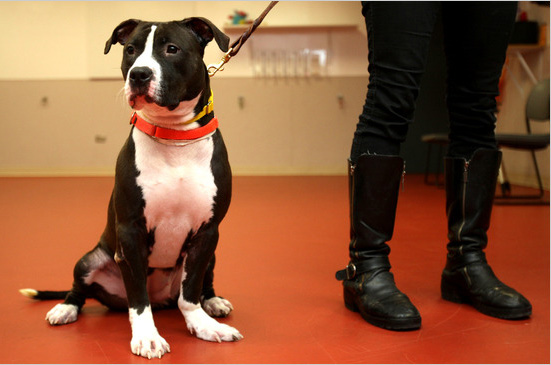
A two-year-old pit bull, Oreo was euthanized inside the New
York City headquarters of the American Society for the Prevention
of Cruelty to Animals, after the organization rebuffed last-minute
pleas to spare her life. The organization called the dog a
danger to the public.
On Friday morning, Oreo received a last meal of “premium
quality” kibble and canned dog food. She was then given
a sedative to keep calm during the procedure and brought into
a small room used inside the headquarters for behavioral analysis.
Oreo was then injected in the leg with an overdose of sodium
pentobarbital and was pronounced dead shortly after 3 p.m.
The organization has euthanized 107 dogs this year, through
October.
Oreo’s case came to public attention in June when her
owner, Fabian Henderson, threw her off the roof of his apartment
building in the Red Hook Houses in Brooklyn. Mr. Henderson
was convicted of animal cruelty and is scheduled to be sentenced
in December.
Oreo broke two legs in the fall. News reports of the incident,
accompanied by photos of the brown and white dog with her
front legs in casts, triggered a flood of adoption offers
and financial donations to help pay for the medical care.
However, as Oreo recuperated from those physical injuries
under the care of the A.S.P.C.A., she was increasingly viewed
as a danger — difficult to control and “unpredictably
aggressive,” according to an organization spokesman.
News of Oreo’s death provoked angry reactions among
supporters who had been frantically lobbying the A.S.P.C.A.
to delay the euthanization and allow time to negotiate a deal
to transfer Oreo to an animal sanctuary in the Hudson Valley.
In one appeal, Camille Hankins, the director of Win Animal
Rights, sent an e-mail message to the A.S.P.C.A. begging for
clemency and accusing the organization of completing “what
the animal abuser who threw her off that Brooklyn roof top
set out to do.” Protesters also gathered briefly at
the headquarters Friday morning.
The A.S.P.C.A. rejected those pleas, citing the evaluation
of staff members and an outside veterinary behaviorist who
said that Oreo could not be rehabilitated. “Animal cruelty
isn’t pretty and doesn’t always have a happy ending,”
said the society’s president and chief executive, Ed
Sayres, “It is ugly and sad and, ultimately, tragic.”

NY
Dog Oreo Put Down Despite Pleas From Dog Lovers
November
13, 2009
NEW
YORK (AP) -- A young pit bull mix that survived being thrown
off the sixth-floor roof of a Brooklyn building still was
not fit to live because of her aggressive behavior, her caretakers
said, and she was euthanized Friday, despite pleas from animal
activists to spare her life.
Oreo suffered two broken legs and a fractured rib when she
was beaten and thrown off a roof June 18. After months of
working to rehabilitate her, the American Society for the
Prevention of Cruelty to Animals determined that she was unpredictably
aggressive, and could never live among humans or other dogs.
The plight of the 1-year-old Oreo stirred emotions among animal
lovers, and the ASPCA decision to euthanize her led many to
flood the organization with hundreds of calls, e-mails and
Twitter messages.
''We're saddened by the outcome,'' said ASPCA spokesman Andy
Izquierdo on Friday afternoon after the organization announced
Oreo's death. ''But we truly feel it's the most humane decision
for Oreo.'' Earlier, Izquierdo said the agency had received
well over 200 calls and e-mail messages, as well as at least
two death threats.
''People don't know the behavioral piece,'' Izquierdo said.
''We could fix her physically, but we couldn't do anything
with her psychologically.''
Protesters rallied outside the building Friday morning. And
at least one pet sanctuary offered to take in the dog.
''The aggression thing is a dumb excuse because all dogs can
be worked with,'' said Emily Danks, a self-described animal
rescuer who said she was escorted out of the ASPCA's building
on the Upper East Side after trying to convince staff members
to let her take Oreo. She said she had planned to take the
dog to Pets Alive, a sanctuary in Middletown.
Matt DeAngelis, executive director of Pets Alive, said his
organization had left phone messages for the ASPCA  with
an offer to take in Oreo. But he said they had not heard anything,
and he was perplexed at why the ASPCA didn't accept the group's
offer. with
an offer to take in Oreo. But he said they had not heard anything,
and he was perplexed at why the ASPCA didn't accept the group's
offer.
In an e-mail, Stephen Zawistowski, one of the ASPCA's lead
animal behavior experts who had worked with Oreo, said the
organization didn't believe that sanctuary placement was ''good
for her welfare.''
''We made this decision having the experience of working with
a number of well-known sanctuaries and rescue groups,'' he
said, adding that the ASPCA was unfamiliar with Pets Alive.
Fabian Henderson (left),
a 19-year-old who lived at the housing complex in Brooklyn's
Red Hook section, where officers found Oreo badly injured,
was arrested on felony charges. He has pleaded guilty to aggravated
cruelty to animals, and is to be sentenced Dec. 1.
There was no phone listing for Henderson at the Brooklyn building.
His lawyer could not immediately be reached for comment.
EUTHANASIA
|

Vet sues over Big Mac attack
By JULIA DAHL
November
22, 2009
A decorated disabled Iraqi War veteran is slapping McDonald's
with a $10 million lawsuit -- claiming he 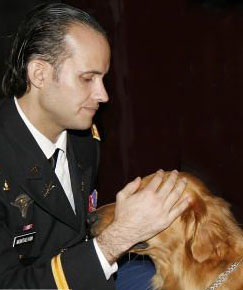 was
pummeled by employees at a Brooklyn franchise when he tried
to bring his service dog into the restaurant. Retired Army
Capt. Luis Montalvan, 36, charges that workers at the eatery
on 52nd Street and Fifth Avenue in Sunset Park pounded him
with plastic garbage can lids, leaving him with neck and back
injuries. was
pummeled by employees at a Brooklyn franchise when he tried
to bring his service dog into the restaurant. Retired Army
Capt. Luis Montalvan, 36, charges that workers at the eatery
on 52nd Street and Fifth Avenue in Sunset Park pounded him
with plastic garbage can lids, leaving him with neck and back
injuries.
Montalvan, who suffers from post-traumatic stress disorder
and traumatic brain injury, uses his golden retriever, Tuesday,
to keep him calm.
In December, the ex-soldier who walks with a cane, went to
the fast-food restaurant with his dog, and the workers allegedly
began berating him.
"Employees started yelling, 'No dogs!' and 'Get out!'
" he told The Post.
An angered Montalvan, who earned two Bronze Stars, wrote a
complaint letter to the corporation, resulting in stickers
being placed on the restaurant's doors stating service dogs
were allowed.
But when he went back a month later, he was tossed out.
Finally, on Jan. 30, he returned one last time to take photos
of the sticker when two men wearing McDonald's uniforms approached
him carrying plastic garbage can lids, he claims. The men
allegedly beat him for two minutes.
The Sunset Park McDonald's management had no comment.

A Kid’s Idea, for Dogs to Savor
By SUSAN DOMINUS
November
21, 2009
Dog ice cream. You get it right away,
right? Just because it’s so obvious doesn’t mean
it’s not a  good
idea. People love dogs. Dogs love ice cream. But people don’t
like what ice cream does to their dogs, specifically, their
dogs’ stomachs. Neither do the dogs. Neither do the
carpets. So why not make ice cream dogs can tolerate? good
idea. People love dogs. Dogs love ice cream. But people don’t
like what ice cream does to their dogs, specifically, their
dogs’ stomachs. Neither do the dogs. Neither do the
carpets. So why not make ice cream dogs can tolerate?
This was the idea Christian Liendo stumbled on at the tender
age of 16. Christian, a bright-eyed science buff from Flushing,
Queens, who is the son of a cabdriver, has lots of great ideas
— he’s just been waiting for someone to ask him
to do something with them. Last summer, he enrolled in an
entrepreneurial program and competition sponsored by Goldman
Sachs and Prep for Prep, a nonprofit that identifies minority
students and prepares them, during summers and weekends, for
private schools. Christian, now a junior at Columbia Prep,
started working with the group after fifth grade.
He hit on a nexus of relative originality and practicality.
Because both his parents work, Christian spent a lot of his
childhood at the home of his grandmother. It was an arrangement
that came with perks: time with his grandmother’s dog,
Max, a friendly cocker spaniel; and an after-school snack
of vanilla ice cream. On a visit to his grandmother’s
this summer, as he watched Max whine for a taste of the good
stuff, it suddenly dawned on Christian: New York has dog bakeries,
dog spas, dog therapists; how was it that the canine market
wasn’t already saturated with local, artisanal ice creams?
Blizzard Dog was born.
With his mother’s help, Christian started experimenting
with carob powder (chocolate is dangerous for dogs), soy milk
and lactose-free milk. He gave tastes to friends’ dogs
and to Max. Corn and carrot were bigger hits than chocolate
and vanilla.
Given samples, the students in Christian’s class came
back for seconds. At a recent tasting, the carrot had a bright,
not-too-sweet taste, and a consistency on the refreshing side
of icy. At least it looked like that’s what Max would
have said, had he been able to verbalize it.
THE judges awarded first prize and $1,200 to a young woman
who made vegan cookies. Judging from competition winners in
this and past years, the future of entrepreneurship lies in
tasty things, green things, animal-friendly things or things
that are some combination therein: vegan dog biscuits, low-sugar
power bars (for humans), environmentally friendly stuffed
animals.
Christian, who won an honorable mention, thought he had something
to bring to the niche market: a more upscale version of what
Purina, for example, sells in grocery stores. “It won’t
be in supermarkets,” Christian said of his creation.
“It’s going to be sold in ice cream stores.”
That way, he explained, dog owners won’t feel bad when
they stop for a cone and their dogs whimper in longing.
Christian did win $250, and he is trying to figure out how
to save enough money to scale up the project.
As much as Christian loved the entrepreneurial program, next
summer he hopes to get a job to earn some seed money. He said
that he always envisioned himself becoming a math or science
academic, but that “if this business works out, that
would be great.”
This is what the best youth empowerment nonprofits do: dangle
a carrot — or some carrot ice cream — in front
of young people, then inspire them to set their own goals.
They do more than just ask for ideas, they challenge students
to see how far they can take them.
Christian’s family has only one concern about the project:
Max is getting chubby. A side business in personal trainers
for dogs may not be far behind.
Photo:
Robert Stolarik for The New York Times

'Bo Obama: The White House Tails'
First dog's magic touch extends to comic books
November
20, 2009
People can't seem to keep their paws off all things Bo Obama
.

Bo made his debut in April when the first family adopted him.
He continues to be a regular subject among paparazzi and pet-loving
bloggers when he's spotted taking walks around the White House
.
He has his own Beanie Baby likeness and was the first Obama
to have his official portrait taken earlier this year.
Now, the presidential dog plays a cartoon narrator and tour
guide donning his famous multicolored lei for the comic book
"Bo Obama: The White House Tails." The comic book
sold out its distribution when it was released in September
but can still be found in comic book stores, airports and
specialty shops.
An extended book version will be released in March in bookstores
nationwide, said officials from the comic book's publishing
group, Bluewater Productions Inc.
The comic is meant to be educational for tweens and younger
kids, to teach them White House history and about past presidential
pets.
Bluewater has also released a series of comics about Bo's
owners, Barack and Michelle Obama , for two of the publisher's
series: Political Power and Female Force, said Jason Schultz,
a company spokesman.
A few copies of the Bo Obama comic are available at Graham
Cracker Comics at 77 E. Madison St. in the Loop and at other
local Graham Cracker stores.
And the pictures? Doggone cute.


Kenosha's
track to close
You might be able to adopt a dog
November
20, 2009
Some
greyhounds currently residing at Kenosha's Dairyland Greyhound
Park will soon be looking for  new
homes. new
homes.
Dogs will be available for adoption when the track closes
its doors Dec. 31 because of declining revenue, officials
said.
On Thursday, the track's general manager, Bill Apgar, quashed
rumors that the greyhounds would be euthanized.
"There is absolutely no truth behind the rumor,"
Apgar said of the "viral" e-mail about the rumors.
"The state gives us three choices. The dogs can go with
their owners, they can go to another track, or they can be
adopted," he said. "Anyone interested can come and
visit us and talk to us about adoption. We welcome visitors."
For more information about adopting a dog, contact the adoption
center at (262) 612-8256 or contact the Wisconsin Chapter
of Greyhound Pets of America, www.gpawisconsin.org.


Deal
on Mexican Gray Wolf
November
15, 2009
ALBUQUERQUE, N.M. (AP) — The federal Fish and Wildlife
Service and environmentalists reached  an
agreement Friday that scraps a rule the agency had used to
kill or permanently remove any wolf that killed three head
of livestock in a year. an
agreement Friday that scraps a rule the agency had used to
kill or permanently remove any wolf that killed three head
of livestock in a year.
A spokesman for the agency, Tom Buckley, said the three-strikes
rule would “no longer stand.” The agency has other
ways to deal with livestock kills “and remains committed
to assisting the local livestock operators in any negative
impacts they may have related to wolves,” Mr. Buckley
said.
Environmentalists argued that the rule favored the ranching
industry and was a major roadblock to the population recovery
effort for the Mexican gray wolf, a subspecies of the gray
wolf. Ranchers said the policy was aimed at wolves that grow
accustomed to preying on cattle.
Several environmental groups sued in May 2008, asking a federal
court in Arizona to stop the removal policy.
Mr. Buckley said agency officials hoped a judge would sign
the settlement this week.
There are about 50 wolves in Arizona and New Mexico —
half of what biologists had hoped to have by now.
The recovery effort has been hampered by illegal shootings,
complaints from ranchers who have lost cattle to the wolves
and the removal of wolves that violated the three-strikes
rule.
The Fish and Wildlife Service began backing off rigid enforcement
of the policy this year. In June, the agency’s southwest
regional director, Benjamin Tuggle, allowed an alpha male
wolf linked to four livestock killings to remain free in southwestern
New Mexico.
Mr. Tuggle said that the wolf had produced pups and that removing
him could hurt the recovery program. Only the alpha pair of
each pack has pups each year.

Pug of war: SI exes fight for dog custody
It's the struggle for the puggle
By JAMES FANELLI
November
15, 2009
The breakup of a Staten Island couple has unleashed a legal
dogfight over the ownership of an adorable  1-year-old
pug-beagle mix named Benjamin. 1-year-old
pug-beagle mix named Benjamin.
Audrey Hesselberg (left, with Benjamin) wrongfully took the
beloved pet, Mark Granquist claims in a lawsuit. The ex-lovers
split up a month ago after three years of dating.
"Relationships don't work out, but that's my dog,"
said Granquist, 36. "I love the dog. He's my buddy."
But Hesselberg, 32, says Granquist is barking up the wrong
tree because he gave her the pet as a gift.
"He's been sort of harassing me ever since I broke up
with him," said Hesselberg, who lives with Benjamin and
her parents two blocks away from her ex.
"He's just doing this because he's upset, and he's doing
this out of spite."
Granquist, a wholesale-tobacco distributor, bought the pooch
for $700 on Jan. 21 from Arcadia Pets on Staten Island.
Hesselberg, a teacher, said Granquist's story is about as
believable as a dog eating her students' homework.
The police have sided with her because Benjamin is registered
under her name with the city Department of Health.
Photo:
Catherine Nance
|

Love for a Dog That’s No Bark and All
Yodel
By N. C. MAISAK
November
14, 2009
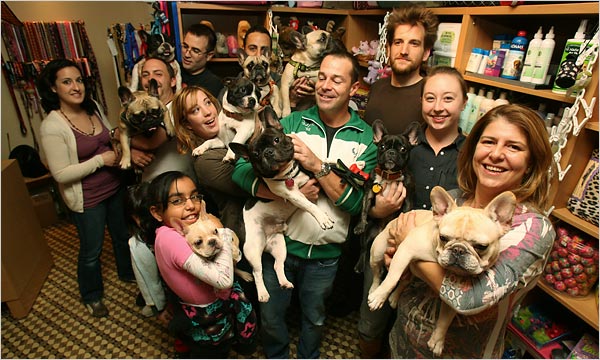
Donut the French bulldog was sitting outside
Starbucks. Romeo was perusing the produce at the Korean
market down the street, and Jack was going to see Oskar for
a play date. Oh yes, Oskar was in his usual spot, sunning
himself on his little red bed in the window of the Jumping
Bulldog, the chic dog and cat boutique named after him.
Stroll
the streets of the Ditmars area of Astoria, Queens, and you’re
bound to run into a French bulldog or 32, which was where
the unofficial tally stood at last count.
“Last year, there were only eight,” said Tanja
R. Firrigno, Oskar’s “mom” and the owner
of the Jumping Bulldog. “There are several more that
I haven’t met, but I’ve seen them in the neighborhood.
I see far more of them here than I do of any of the designer
breeds.”
With their rabbit ears, punched-in faces, squeaky-toy voices
and wrestler’s bodies, French bulldogs are a noticeable
curiosity in Astoria, where the dog of choice still runs to
pound, not pedigree.
“They attract more attention than any other dog,”
said Erin Mara, owner of Donut, who is white with a black
mask face. “I can’t walk two steps without people
stopping us. I walk dogs in my spare time, and no other breed
brings this type of response.”
It’s hard not to fall for Frenchies, which were popular
lap dogs in wealthy households in 19th-century France, but
it’s not easy to understand why working-class Astoria
has succumbed so suddenly. Often conceived via artificial
insemination and delivered via Caesarean section, French bulldogs
can sell for $2,500 to $5,000. According to the Web site of
the French Bull Dog Club of America, the dogs are difficult
to breed and the C-sections are made necessary by the mother’s
narrow hips and the puppies’ large heads.
“For decades, Astoria has been waiting in the wings
to become the next Manhattan,” said George Halvatzis,
a real estate agent whose Ditmars Boulevard office Donut passes
during his daily constitutionals. “We have been getting
trendy restaurants and trendy shops, but more than anything,
the Frenchies, which are so Manhattanesque, may be the signal
that this is finally starting to happen.”
Mr. Halvatzis, who owns a shar-pei named Chopper, said the
breed was perfect for apartments. “Because of the weak
economy, landlords have gotten more lax about taking dogs,”
he said. “And French bulldogs are just the right size
and temperament for smaller spaces.”
The dogs have another landlord-endearing quality: “They
don’t bark,” said Luke Herman, who, with his wife,
Natalia Lyons, owns Jack. “They have their own language
of yodels, screams, chirps, warbles and what can best be described
as snorfles.”
JoAnn and Matt Franjola, owners of Romeo, say he is the perfect
companion for their 3-month-old son, Chase. “They’re
fabulous together,” Ms. Franjola said. “Romeo
licks his toes, and if the baby cries, Romeo runs up to me
and stares as if to say, ‘Are you going to get that?’ ”
The only thing better than one Frenchie, say Givanni Ildefonso
and Jose Sandin, is two. Coco and Samantha, sisters whose
fall wardrobe includes matching brown and pink hoodies that
complement their fawn bodies and black masks, have turned
their owners into celebrities. “We meet new people every
night,” Ms. Ildefonso said. “And people always
say: ‘Wow! They’re twins. How do you tell them
apart?’ ”
Astoria Frenchie owners dismiss the idea that the dogs are
status symbols and emphasize that they require as much tender
loving care as children. They can develop breathing and respiratory
problems because of their short, pressed-in faces, and are
prone to joint diseases, spinal disorders and heart defects.
“There’s an immense commitment, financially,”
says Josh Flanagan, whose 2-year-old George Clooney is among
the original Astoria Eight. “I’ve heard that over
the life of the dog, it could cost $40,000 in veterinarian
bills, premium food and general upkeep. My wife, Lindsay,
and I love ours to death, but I don’t know if we’d
get another.”
Astoria’s fascination with the breed can be traced back
four years to the first Oscar, a high-fashion fawn who wore
a red bandana around his neck. His owner, a tall, ponytailed
man who was said to have been an opera singer, taught Oscar
to walk at his side, leashless, and to wait for him outside
the shops on 31st Street.
Oscar moved to the West Coast, Donut has since taken up the
golden leash, and the new Oskar, with his darling doggie-in-the-window
routine, has turned the Jumping Bulldog into a French bulldog
franchise.
Dogs and owners have become fast friends, so much so that
Ms. Firrigno was considering holding Frenchie Fridays at the
shop for some off-leash playtime.
“You can’t be a Frenchie owner and be antisocial,”
Ms. Mara said. “There’s a special bond between
Frenchie owners. It’s like a club.”
Mr. Herman agreed, adding that those in the Frenchie fraternity
“recognize the dogs but sometimes not the people. But
we have developed social relationships with some of the owners,
and sometimes we even hang out without the dogs.”
There is also a special bond between the pets. Jack, Oskar
and Donut, for instance, have become fast friends.
“I can’t imagine not ever having a Frenchie,”
Ms. Lyons said. “Someday, I would like to get a little
sister for Jack.”
Jack looked up at her and smiled like a clown. On command,
he gave Mr. Herman a high-five with his petite paw, and they
continued down the street.
“Oh, that’s so cute,” a woman cooed as she
knelt to pet his head. “What kind of dog is that?”
Photo:
Michelle V. Agins/The New York Times
|

Bomb-Sniffing
Dog Found After 14 Months MIA
Andrew Mearse
November
13, 2009
Sabi, a bomb-sniffing black Lab who disappeared during a battle
in Afghanistan 14 months ago, has 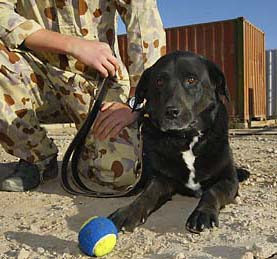 been
returned to her unit. been
returned to her unit.
Sabi was with an Australian-Afghan army patrol when they were
ambushed in the Uruzgan province in September 2008. The ensuing
gunfight wounded nine soldiers, including Sabi's handler,
and Sabi went missing. Soldiers searched for the dog for months,
but she was gone without a trace and declared Missing in Action.
Officials from Australia's Department of Defence said Thursday
that a U.S. soldier at an isolated patrol base elsewhere in
the province recently found Sabi. According to newspaper The
Australian, officials would identify the man who discovered
Sabi only as a soldier named John who was aware that the Aussie
special forces were missing one of their detection dogs.
Military spokesman Brig. Brian Dawson said that because of
Sabi's good condition, it appeared that someone had been looking
after her for more than a year.
Sabi returned back to base with a hero's welcome. According
to The Australian, Sabi's Special Forces trainer claimed that
after only a few hours back she was already adhering to orders
and chasing tennis balls.
Submitted
by Lee Becker and Brian Coape-Arnold
|

A Patchwork of Food Assistance for Pets
By CARLA BARANAUCKAS
November
12, 2009
ANIMAL shelters have reported a steep
rise in the number of cats and dogs being 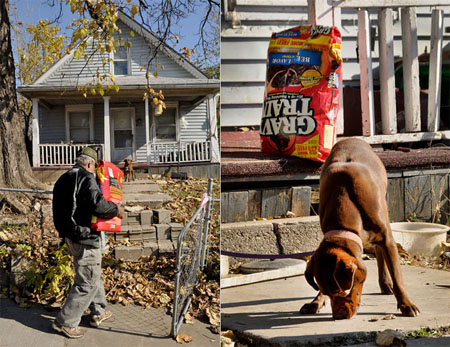 surrendered
as owners face unemployment, home foreclosures, evictions
and other financial hardships. But animal welfare groups and
even churches are stepping up with bags of kibble and containers
of cat litter to help owners keep their pets and to prevent
more from being sent to shelters, and sometimes death. surrendered
as owners face unemployment, home foreclosures, evictions
and other financial hardships. But animal welfare groups and
even churches are stepping up with bags of kibble and containers
of cat litter to help owners keep their pets and to prevent
more from being sent to shelters, and sometimes death.
No national network coordinates pet food assistance. Instead,
efforts have sprung up at a grass-roots level as individuals
and groups have recognized the problem. The means of offering
aid to pet owners varies with each organization. The Humane
Society of the United States keeps a long list of programs
on its Web site headlined “ Having Trouble Affording
Your Pet ?” And the society acknowledges that there
are probably many more programs the organization is not aware
of.
The Tree House Humane Society in Chicago, which focuses on
cats, has provided food assistance for more than 30 years,
said Ollie Davidson, the society’s programs manager.
The society, which also provides food for dogs, has seen demand
almost double over the last year, giving out more than 44,000
pounds of pet food this year, Mr. Davidson said. About 20
percent of the food distributed was for dogs and about 80
percent for cats. If current trends continue, the organization
expects the number of those receiving pet food assistance
to grow to 200 next year, from 157.
“Most of our food is coming from donations of people,”
Mr. Davidson said, but with the sharp increase in demand the
organization is applying for grants to help cover the costs.
Mr. Davidson said the grant applications emphasize that the
food aid program is about much more than feeding hungry animals.
“We’re helping people,” he said. “In
times of stress, it’s always good to keep people with
their pets.”
Jennifer Fulton, president of the Northland Pet Food Pantry
in Kansas City, Mo., said the demand was huge. “We started
giving out food in May of this year, and the response has
been incredible,” she said. “We had people feeding
their pets before they were feeding themselves.” But
now 155 families with pets are being helped.
PAWS Chicago, a no-kill animal shelter, started a crisis-care
program and a food bank last year, “when we saw the
whole real estate thing happening and people were losing their
homes,” said Paula Fasseas, who founded the organization
in 1997. The organization provides temporary foster care for
pet owners who are struggling because of the economy. In addition,
the shelter has worked with the Petco Foundation, providing
dog or cat food and litter for up to three months, said Rochelle
Michalek, executive director of the shelter.
Sandra Jauga, a maintenance worker in Chicago who said she
had been out of work since falling off a ladder this year,
turned to PAWS Chicago for help when her workers’ compensation
claim was denied. Ms. Jauga, a single mother of four, said
Roxy, her beagle-pit bull, would not be able to eat without
the aid. “I’m really grateful for the help,”
she said. “If you have to get rid of the dog, what’s
going to happen with the dog? Where is it going to go?”
With a mission of making Chicago a no-kill city, the shelter
visits Chicago’s animal pounds regularly to rescue animals
that have not been reclaimed or adopted. By providing pet
food to people facing financial hardship, the organization
is trying to keep more animals from being surrendered to the
pounds.
For its part, the Petco Foundation has been involved with
pet- food banks since it began in 1999, said Paul Jolly, the
executive director. “We have always been involved in
the food bank concept simply because it keeps people with
their animals.”
Mr. Jolly said that Hurricane Katrina was a drastic lesson
for the country about how strong the bond between people and
their pets can be. “Katrina pointed out that pets are
part of the family, too,” he said.
The Petco Foundation, based in San Diego, has partnerships
for pet-food assistance with about 75 organizations across
the country. In January, the foundation is introducing a program
with Feeding America , a hunger-relief charity whose members
supply food to more than 25 million Americans each year.
Under the program, “We Are Families Too,” 750
Petco stores will have bins where customers can donate pet
food, Mr. Jolly said. In addition, the foundation will supplement
the donations with food from Petco and other vendors. Distributors
will often donate food approaching its expiration date.
Help is also available from tiny, grass-roots organizations
in smaller towns.
The Young at Heart pet rescue of Palatine, Ill., which focuses
on finding homes for cats and dogs over age 5, established
Nina’s Pet Food Pantry with a donation from Steve and
Laurie Weiner of Buffalo Grove, Ill., in memory of their Portuguese
water dog, Nina. The pantry collects donated kibble from individuals
and pet-food distributors, mixes the various brands and types
of food and repackages it in plastic zip-top bags for distribution
at two human food banks, said Karen Ortolano, a spokeswoman
for the organization. (Combining the food assures a uniform
quality and makes it easier for the animal to make the transition
to what the group calls its “rescue mix.”)
After Nina died about a year ago, Mr. Weiner said he could
understand the pain of separating from a family pet. “I’m
thrilled that dozens of pets don’t know how close they
came to having their lives changed,” he said, adding
that a relationship with a pet is a 24/7 commitment for the
life of the pet. “You don’t move away from them
or they don’t go off to college,” he said. His
family continues to help with the pantry program, staying
involved in the rebagging of the food. “Just last week
I was knee-deep in pet food with latex gloves on, sifting
and sorting,” he said.
Some of the food-pantry programs encourage or even require
pet owners to spay or neuter their pets. Spay and Neuter Kansas
City is one group that makes pet altering a requirement. Gloria
Harris, pet outreach program manager, said the organization
provides low-cost spaying and neutering services for low-income
pet owners. If there is not enough money to feed a pet, there
probably is not enough for a litter of puppies or kittens,
she said.
In October, the organization held its “doggy food raiser,”
collecting 12,000 pounds of the 20,000 pounds of food it will
distribute this year, Ms. Harris said.
Part of the campaign was tied to the Kansas City Chiefs-Philadelphia
Eagles National Football League game this season. Fans were
asked to pledge a bag of dog food every time the Chiefs sacked
Philadelphia’s quarterback, Michael Vick . Although
the quarterback was sacked only once, 500 pounds of food was
collected.
But the pet-food banks are not simply the work of animal welfare
groups. Northeast Community Lutheran Church in the urban core
of Minneapolis serves about 300 people a month at its Little
Kitchen Food Shelf, according to its Web site. But the church,
which also provides vaccines for companion animals, found
that people struggling financially also needed food for their
pets. Now people are also offered food for their pets.
“We know that pets being dropped off at humane societies
tend to be on the rise in this current economy, so its obvious
that pets are suffering,” said the Rev. Craig Pederson,
the pastor.
Jennifer Schultz, coordinator of the Little Kitchen, said
she knew the demand was great because the church had received
calls from people who live in the suburbs and needed help
feeding pets.
Dwayne Pough, a Chicago cook who has been out of work for
several months, said help from PAWS Chicago made a big difference
for his American Staffordshire, Malachi. “Man, it was
crucial because he’s a big dog and he eats a lot,”
Mr. Pough said. “I get food stamps, and you can’t
buy dog food with food stamps. Actually, I was down to my
last bag with maybe two more feedings when they came through.
It was a life-saver, really.”
Photographs
by Don Ipock for The New York Times

Tony and October Gonzalez Would 'Rather Go
Naked Than Wear Fur'
November
12, 2009
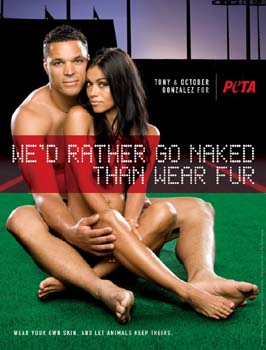
NFL tight end Tony Gonzalez makes another
amazing play! But this time it's not one of his record breaking
receptions, it's his all-star move for animals. The football
sensation and his wife October are baring it all in a PETA
ad to tell people to wear their own skin and let animals keep
theirs. In the ad, Tony and October say "we'd rather
go naked than wear fur."
This six-time Pro Bowl, all-pro tight end, and NFL Hall of
Famer is raising awareness about the treatment of animals
who are killed for their fur and wants his fans to join him
in going the extra yard for animals too. Please join Tony
and October by pledging never to buy or wear fur.

Dog trainer murder mystery
November
12, 2009
ANACORTES, Wash. -- Mark Stover (below), 57, was the Pacific
Northwest's dog trainer to the stars. He  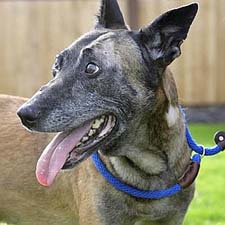 taught
obedience to the pets of Pearl Jam and Nirvana and Seattle
Mariners outfielder Ichiro Suzuki. He also trained his own
dog, Dingo (right) -- for protection. taught
obedience to the pets of Pearl Jam and Nirvana and Seattle
Mariners outfielder Ichiro Suzuki. He also trained his own
dog, Dingo (right) -- for protection.
But when Stover's killer came last month, there was nothing
the female Belgian malinois could do.
She was shot in the face, and when deputies arrived, the only
signs of her master were smears of blood.
Investigators have yet to find Stover's body, but prosecutors
have charged his ex-wife's boyfriend, Michiel Oakes, with
murder in a case that may have stemmed from their divorce
two years ago.
Stover's friends said they believed he had moved on after
the split.
While Dingo survived, pet lovers are in mourning for Stover.
Local K-9 officer Marie Padovan said: "Dogs that were
uncontrollable would go to Mark, and they could be controlled.
It's a big loss for all of us dog people."

Clifton Springs man Phillip Lane bites dog
to save his best Buddy
Carl Dickens
Geelong , AUSTRALIA
November
11, 2009
A CLIFTON Springs man has told how he
bit a dog to save his own from being mauled to  death
on a Collendina beach. death
on a Collendina beach.
Phillip Lane told the Geelong Advertiser he was walking his
two-year-old Jack Russell-cross-beagle Buddy with his wife
Linda on a quiet Collendina dog beach about 4pm on Monday,
when a large, brown ridgeback ran up and snatched their little
dog in its jaws.
"It grabbed our dog, threw him to the ground and had
him by the neck," Mr Lane said. "I thought, 'if
he starts shaking him, he'll kill him'."
Mr Lane said he tackled the attacking dog and tried to forcibly
unclamp its jaws with his hands.
"I thought Buddy was gonna be dead, that's it, he's gone
... he was crying and squealing, it was just horrible."
Then, Mr Lane's protective instinct took hold. With one hand
in the ridgeback's mouth and another around its neck, he resorted
to the most desperate of measures. "I thought, 'if you're
not gonna let go, I'm gonna bite your ear off' ... I ended
up biting him on the ear as hard as I could," he said.
The bite stunned the attacking dog, which released Buddy and
was taken away by its male owner, who had just arrived. Mr
and Mrs Lane then grabbed their bloodied, stricken pooch and
took him to the safety of the water, before rushing him to
the vet.
Mr. Lane said veterinarians told him the thick skin around
Buddy's neck had helped it survive the attack. The dog was
yesterday recovering from its grazes and bruises at home.
Mr Lane, meanwhile, received multiple cuts to his hands from
the Ridgeback's attack, with a doctor administering butterfly
stitches, a tetanus shot and antibiotics.
He voiced his anger at the ridgeback owner's apparent indifference
to the attack and inability to control his pet. "The
bloke had been lying down on the sand, and only arrived when
he heard my wife screaming. He said 'sorry about that', and
mentioned his dog had attacked other dogs," Mr Lane said.
"Dogs are supposed to be muzzled if they're dangerous,
and if they've attacked other dogs, they shouldn't be allowed
on the beach."

L.I. Mom Accused Of Running 'Concentration
Camp' For Dogs
November
11, 2009
SELDEN, N.Y. (1010 WINS) -- A concentration camp
for dogs -- that's what a Long Island woman's  own
son says she was running at her home in Selden -- where the
bodies of nearly two dozen animals were found buried in the
backyard. own
son says she was running at her home in Selden -- where the
bodies of nearly two dozen animals were found buried in the
backyard.
Sharon McDonough (left), of 18 Awixa Place, has been charged
with misdemeanor animal cruelty after at least 20 animal carcasses
where dug up in the backyard of her home where she lived with
her seven children, police said.
The 43-year-old is accused of torturing, killing and burying
the animals in her yard. Her son, Douglas McDonough, told
reporters that she forced her children to torture the pets.
Investigators say she could face more serious charges once
they determine how the animals died. Her children have been
placed in protective custody. She was released on her own
recognizance and is due back in court Tuesday.
"This is one of the worst cases of animal abuse I have
seen in the last 25 years I have been doing this," Chief
Roy Gross, of the Suffolk County SPCA, said.
Investigators say Douglas McDonough, Sharon McDonough's eldest
son, tipped off an animal rescue group to conditions at the
home. The group then contacted police.
"It was a concentration camp for the animals," Douglas
McDonough, said. "My sisters and me, we got the end of
it, too.

Firefighters save dog in Naperville fire
November
9, 2009
Naperville firefighters saved a small dog from a smoky
townhouse fire Sunday 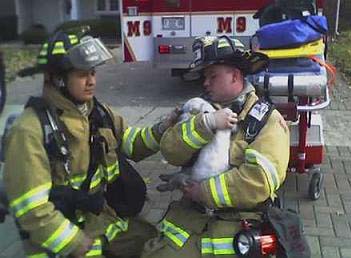 morning,
reportedly giving the dog mouth-to-mouth before using a special
pet-sized oxygen mask to revive it. morning,
reportedly giving the dog mouth-to-mouth before using a special
pet-sized oxygen mask to revive it.
A fire started in the laundry room of one of the units
in the townhouse in the 900 block of West Court when clothes
left near a water heater apparently caught fire, Naperville
Fire Department Battalion Chief Patrick Sleik said. No one
was home at the time.
Firefighters heard the dog barking when they arrived on the
scene at about 10:06 a.m., Sleik said.
A passerby, Linda Quamme Merkel, said she saw firefighters
carry the dog out and one of the firefighters start doing
mouth-to-mouth resuscitation as his partner ran to get special
equipment. She said firefighters at the scene told her they
found the unresponsive dog under a sofa during a search of
the home.
Sleik said firefighter/paramedics Jake Felton and Javier Saucedo
used a special pet mask to give the dog oxygen. The masks
are carried in the battalion car and another vehicle, Sleik
said.
The dog was revived and taken to an emergency veterinary hospital
in Lisle where the dog, a year-old Shih-Tzu named Pepsi, was
recuperating. A veterinary employee said the dog was in good
shape and expected to recover from smoke inhalation.
Damage to the townhouse unit estimated at $45,000, Sleik said,
with the unit being left uninhabitable.
The unit's residents were not home at the time and will stay
with a relative, he said.. A unit across from the hall from
the fire location was also damaged by smoke and firefighting
activities, Sleik said.
About 24 emergency personnel were on the scene along with
two ambulances and five trucks, Sleik said. It took about
15 minutes to control the blaze and firefighters were on the
scene for almost two hours.
A nearby water main also broke because of pressure during
the fire, and Naperville public works crews were called to
the scene.
Photo:
Naperville firefighters administer oxygen to revive Shih-Tzu
Pepsi
Courtesy of Linda Quamme Merkel


Happy Times at the Dog Run, Now Coming to an End
By SUSAN DOMINUS
November
7, 2009
It’s considered
impolite, yet everyone slips up occasionally. How can
anyone be blamed for  mixing
up the name of a dog with that of its owner, especially when
the dog is Henry and his owner goes by Rags? mixing
up the name of a dog with that of its owner, especially when
the dog is Henry and his owner goes by Rags?
Even still, Dick Sebastian resolved he would not make that
particular mistake, or any similar one, at the small-dog run
in Washington Square Park he started frequenting a few years
ago with his wife, Susie, and his dog, Kitty (grounds for
more confusion, but that was someone else’s problem).
He whipped up cartoony illustrations of all the dogs at the
run who, like Kitty, arrived like clockwork for the morning
shift, and turned them into a chart labeled with their names.
Mr. Sebastian sometimes brought the work in progress to the
dog run, and over time, even owners who were not part of the
regular crew — many of them part of a downtown, arty
scene — asked if their pets could be included, or agreed
when approached by Mr. Sebastian.
From there, Mr. Sebastian, a retired surgeon who is now 71,
started experimenting with more serious portraiture, sketching
some of the dogs he had come to know better than many of his
friends’ grandchildren. He started with Sidney, an aristocratic,
standoffish pug belonging to Roberta Bayley (above left),
a former punk-rock photographer turned dog photographer. Everyone
marveled at the images.
“I thought he really captured her weirdness,”
said Ms. Bayley, sitting, as she always does, beside her sedentary,
aloof pet on a bench. “She’s very into herself
and quiet and serenity.”
Mr. Sebastian estimates that in less than a year, he drew
and presented around 50 dog portraits to their owners, as
gifts — in most cases, to great appreciation.
Jessica Pell was grateful that Mr. Sebastian omitted from
the portrait of Briscoe, her bearded, shaggy Brussels griffon
, the oddness that others sometimes see in him. “Some
people look at Briscoe and think he looks like an Ewok ,”
she said, holding up a dog that looked a lot like an Ewok,
the short, furry creature of Star Wars lore. “He captured
a regal quality in him. He captures things that you, as an
owner, feel no one else would see.”
The drawing is one of Ms. Pell’s prized possessions,
because of what it says about her dog, but also about Mr.
Sebastian. “The fact that someone would care enough
that he’d want to draw what’s unique about your
dog for you,” she explained, trailing off.
Even more than the free art, it is his knack for noticing,
for caring about the small details of his fellow dog lovers’
days, that Ms. Pell knows will leave her bereft when Mr. Sebastian
and his wife move back to their native Ohio the day after
Thanksgiving. They decided to make the move so that Mr. Sebastian,
who has Parkinson’s disease , can get easy access to
care at a retirement home.
Ms. Pell, who is single and works for herself, said that right
now, Mr. Sebastian represents stability to her. She’s
there every day; he’s there every day, often with Susie,
always with Kitty, a border terrier , attending to the story
line of Ms. Pell’s life, picking up on the details that
other good friends, absorbed in their own narratives, often
miss. “Susie and Dick never forget,” she said.
“They’ll ask you the next day, ‘Are you
feeling better?’ Or, ‘How did the meeting go?’ ”
New York is full of ad-hoc communities based on proximity
and built up around mutual affection — walk into any
watering hole at 7:30 p.m. — but they often have a live-and-let-live
looseness to them. While parental oversight can stifle, in
loco parentis oversight can be a rare, welcome comfort in
the circles of urban life.
For passionate dog people, the folks at the Washington Square
Park dog run are also, it turns out, passionate people people,
and there have been myriad parties scheduled in honor of Mr.
and Mrs. Sebastian before they depart.
Leaving is painful, said Mr. Sebastian, but walking down subway
stairs is increasingly difficult. The joys of living in New
York — the museums, the restaurants, the various parks
— were eluding him, leaving him with only a very high
rent to pay. For some time now, “this is what I’ve
been doing,” said Mr. Sebastian, gesturing to the clusters
of old friends talking, the small dogs frolicking.
And until it wasn’t, that was enough.
Photo:
Librado Romero/The New York Times
At the small-dog run in Washington Square Park, Roberta Bayley,
with Sidney, her pug,
and Sidney's likeness by Dick Sebastian.

NY Bans the Gassing of Stray Pets
November
6, 2009
An especially challenging political climate in the New York
State Legislature has slowed the progress of a variety of
pro-animal welfare bills this year. However, hard work by
legislators, committee staff, the ASPCA
and New York’s animal advocates brought the humane euthanasia
bill (NY A. 999B) over the finish line!
Introduced in January, the bill sat dormant until the ASPCA,
working closely with Assemblywoman Amy Paulin, Senator Suzi
Oppenheimer and staff, helped revive it and secure passage
in the Legislature in the fall. On October 9, it was signed
into law by Governor Paterson.
The new law, which goes into effect in one year, will:
* Prohibit carbon monoxide and carbon dioxide poisoning (gassing)
of stray and shelter animals (effective in 90 days).
* Require that the euthanasia of stray and shelter animals
be performed by injection.
* Require that such euthanasia be performed by a certified
euthanasia technician, licensed veterinarian, or licensed
veterinary technician.
* Prohibit intracardiac euthanasia—a painful injection
right into the heart—on unsedated shelter animals.
* Require that veterinarians who perform intracardiac euthanasia
on unsedated animals not under the care of a shelter do so
only if it is the most humane option and that they document
the event and rationale.
“The ASPCA
recognizes the necessity of humane euthanasia as a last-step
option to spare animals further suffering,” says Debora
Bresch, Esq., ASPCA
Legislative Liaison to New York State. “We thank the
bill’s sponsors, Assemblywoman Paulin and Senator Oppenheimer,
for their tireless efforts to assure that animals receive
humane treatment at the end of their lives, and look forward
to the day when euthanasia of unwanted animals is an infrequent
occurrence."
Pet Health Notice: FDA Issues Alert on Pet
Insulin Product
On November 2, the U.S. Food and Drug Administration’s
(FDA) Center for Veterinary Medicine issued an alert warning
pet parents and veterinarians to keep a close eye on animals
receiving the insulin product, Vetsulin, to treat animal diabetes.
The product, which is manufactured by Intervet/Schering-Plough
Animal, may contain varying amounts of crystalline zinc insulin,
and could cause a delay in insulin action and an overall longer
duration of insulin activity, according to the FDA.
“Pet parents whose diabetic dogs or cats are currently
being treated with Vetsulin insulin should contact their veterinarians
to discuss appropriate measures,” says Dr. Louise Murray,
Director of Medicine at the ASPCA.
“Examples of alternative insulin choices include Humulin
N and Levemir insulins for dogs, and Lantus (glargine) insulin
for cats. These insulins require different syringes than those
used to administer Vetsulin, and it is essential that pet
parents work closely with their veterinarians when making
any changes.”
Veterinarians should monitor their patients who are receiving
Vetsulin, and consider transitioning them to the insulin products
outlined above.
Inside the ASPCA
ER: Dog Ingests Toxic Pennies and Survives
On September 29, when Keiver Guacane of Manhattan brought
his five-month-old Cockapoo, Gordo, to ASPCA
Bergh Memorial Animal Hospital, his beloved pup was in dire
straits. The fuzzy, light-brown pooch was in critical condition,
suffering from severe anemia and dangerously low blood pressure.
ASPCA
veterinarian Dr. Geruza Paiva examined Gordo, and immediately
suspected the cause of the pup’s distress. “She
was worried he may have eaten coins because he had hemolytic
anemia—anemia due to red blood cell rupture—which
can be caused by zinc toxicity from eating pennies,”
says Dr. Louise Murray, Director of Medicine at the ASPCA.
“Dr. Paiva took an x-ray and saw the coins in his stomach.”
Pennies minted after 1982 contain a zinc core surrounded by
copper and are the only U.S. coins in circulation that pose
a toxicity hazard to pets. Unfortunately, these toxic, late-model
pennies are commonly ingested by our furry friends. The stomach
provides an exceptionally acidic environment and aids in the
rapid distribution of zinc into the blood stream, which can
cause life-threatening anemia and kidney failure.
Luckily, Gordo was in good hands. He immediately received
a blood transfusion, and then ASPCA
veterinarians passed an endoscope (fiber optic technology
attached to a tiny camera) through the dog’s mouth,
down his esophagus and into the GI tract to locate the pennies
and retrieve them with a long, grabbing instrument. The non-invasive
procedure was a success, but the evidence was startling. The
handful of retrieved coins included several gnarly, partially
decomposed pennies and others that appeared almost new.
“If you look at the pennies we took out, the pure copper
ones from before 1982 are perfect, intact and shiny,”
reports Dr. Murray. “The newer, zinc ones are all eaten
away.”
Of course, this interesting disparity in coin metals is probably
of little consolation to mischievous little Gordo. His pet
parent, too, was just relieved to see his furry friend recover
well, and no doubt will forevermore watch what Gordo eats!
As always, if you suspect your pet has ingested pennies or
any other toxic item, please contact your veterinarian immediately
or call the ASPCA
Animal Poison Control Center hotline at (888) 426-4435.

Picked From a Lineup, on a Whiff of Evidence
By JOHN SCHWARTZ
November
4, 2009
HOUSTON — A dog’s sniff helped
put Curvis Bickham in jail for 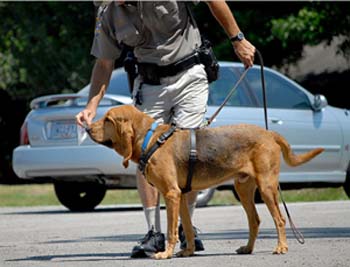 eight
months. Now that the case against him has been dropped, he
wants to tell the world that the investigative technique that
justified his arrest smells to high heaven. eight
months. Now that the case against him has been dropped, he
wants to tell the world that the investigative technique that
justified his arrest smells to high heaven.
The police told Mr. Bickham they had tied him to a triple
homicide through a dog-scent lineup, in which dogs choose
a suspect’s smell out of a group. The dogs are exposed
to the scent from items found at crime scene, and are then
walked by a series of containers with samples swabbed from
a suspect and from others not involved in the crime. If the
dog finds a can with a matching scent, it signals —
stiffening, barking or giving some other alert its handler
recognizes.
Dogs’ noses have long proved useful to track people,
and the police rely on them to detect drugs and explosives,
and to find the bodies of victims of crime and disaster. A
2004 report by the F.B.I. states that use of scent dogs, properly
conducted, “has become a proven tool that can establish
a connection to the crime.”
Scent lineups, however, are different. Critics say that the
possibilities of cross-contamination of scent are great, and
that the procedures are rarely well controlled. Nonetheless,
although some courts have rejected evidence from them, the
technique has been used in many states, including Alaska,
Florida, New York and Texas, said Lawrence J. Myers, an associate
professor of animal behavior at the Auburn University College
of Veterinary Medicine.
In particular, the methods of the dog handler in Mr. Bickham’s
case, and in a half-dozen others that are the basis of lawsuits,
have come under fierce attack.
The handler, Deputy Keith A. Pikett of the Fort Bend County,
Tex., Sheriff’s Department , is “a charlatan,”
said Rex Easley, a lawyer in Victoria, Tex., who represents
a man falsely accused by the police of murdering a neighbor.
Deputy Pikett, the lawyer said, “devised an unreliable
dog trick to justify local police agencies’ suspicions”
for producing search warrants and arrests.
Deputy Pikett, who declined to be interviewed, works in the
town of Richmond, southwest of Houston, but he has served
as a busy consultant to law enforcement agencies around the
state, using his home-trained bloodhounds — he has given
them names that include Columbo, Quincy and Clue — to
sniff out crime. A native of Buffalo, N.Y., he has by his
own estimate in court testimony performed thousands of scent
lineups since the 1990s. His lawyer said the techniques were
effective.
Thomas Lintner, the chief of the F.B.I. laboratory’s
evidence response team unit, said the agency used scents only
to follow a trail to a suspect or to a place associated with
him, and not to identify one person out of several. The 2004
F.B.I. report warned that dog scent work “should not
be used as primary evidence,” but only to corroborate
other evidence.
In several of the cases that were based on Deputy Pikett’s
dogs, however, the scent lineups appear to have provided the
primary evidence, even when contradictory evidence was readily
available. Mr. Bickham spent eight months in jail after being
identified in a scent lineup by Deputy Pikett’s dogs,
until another man confessed to the killings. In an interview,
Mr. Bickham scoffed at the accusation that he had taken part
in three murders, noting that he has been hobbled by bone
spurs and diabetes and is partially blind.
Ronald Curtis, another Houston man jailed on the basis of
Deputy Pikett’s dogs, was released from jail nine months
after being accused of a string of burglaries. Store videos
showed that the burglar did not resemble him. “Nobody
was listening,” Mr. Curtis said.
Both he and Mr. Bickham are filing civil lawsuits over their
treatment in federal court on Wednesday.
The first person to file such a suit, in January, was Michael
Buchanek, a retired captain with the Victoria County, Tex.,
Sheriff’s Department and a client of Mr. Easley. After
Deputy Pikett’s dogs identified him, Mr. Buchanek said
the police “just kept telling me, ‘the dogs don’t
lie — we know you did it.’ ” After months
of uncertainty, DNA evidence implicated another man who later
confessed to the crime.
As Mr. Easley examined the case, he sought the opinion of
animal investigation experts who reviewed Deputy Pikett’s
work and responded with incredulity. Robert Coote, the head
of a British canine police unit, reviewed videos of Deputy
Pikett’s scent lineup in the Buchanek case and stated,
“If it was not for the fact that this is a serious matter,
I could have been watching a comedy.”
Mr. Easley shared his findings with colleagues at the Innocence
Project of Texas , a legal defense organization, which released
a report last month that excoriated dog scent lineups as a
“junk science injustice.” Jeff Blackburn, the
chief counsel for the group, said Deputy Pickett merely gave
the police the match they had hoped for.
Mr. Myers, the animal behavior expert, suggested that handlers
like Deputy Pikett might believe in the dogs and the methods,
but might allow samples to become contaminated or inadvertently
allow the dogs to pick up on subtle, even unconscious signals
from handlers or detectives . “They just don’t
realize they’re doing it wrong,” he said.
Randall Morse, an assistant Fort Bend county attorney who
is representing Deputy Pikett, said the dogs provided information,
not conclusions of guilt or innocence. “Pikett doesn’t
arrest anybody,” Mr. Morse said. “Our dogs don’t
say, You murdered somebody. They don’t even say, You
committed a crime. They just say, We picked up your scent.”
Mr. Morse said scent lineups had proved their worth, as in
the case of Bart Whitaker, a Texan who hired friends to kill
his family in 2003. Deputy Pikett’s dogs helped identify
the trigger man from eight suspects. Mr. Whitaker is now on
death row, and his accomplices are in prison. “We believe
in this stuff,” Mr. Morse said.
Mr. Blackburn of the Innocence Project noted that the Whitaker
case involved a great deal of corroborating evidence beyond
the dogs. “Our estimate right now is we’ve got
15 to 20 people who are in prison right now based on virtually
nothing but Pikett’s testimony,” he said. “That’s
a big problem.”
Donna Hawkins, a spokeswoman for the Harris County district
attorney’s office in Houston, said she could not comment
on the dispute over dog scent lineups or on the re-examination
of cases that involved them. “Cases will be evaluated
on an individual basis, considering all relevant evidence,”
Ms. Hawkins said.
As for Mr. Bickham, he said he had lost his home while in
jail and had struggled to restart his barbecue stand; he sold
his cars to hire his lawyer. These days, he said, he is easily
agitated, cries readily and is taking antidepressants.
“I lost everything,” Mr. Bickham said, because
of “a nothing case.”
Photo:
Bill Clough/Victoria Advocate, via Associated Press

Good Dog, Smart Dog
By SARAH KERSHAW
November
1, 2009
Life as a Labradoodle may sound free and easy,
but if you’re Jet, who lives in  New
Jersey, there is a lot of work to be done. New
Jersey, there is a lot of work to be done.
He is both a seizure alert dog and a psychiatric service dog
whose owner has epilepsy, severe anxiety, depression, various
phobias and hypoglycemia. Jet has been trained to anticipate
seizures, panic attacks and plunging blood sugar and will
alert his owner to these things by staring intently at her
until she does something about the problem. He will drop a
toy in her lap to snap her out of a dissociative state. If
she has a seizure, he will position himself so that his body
is under her head to cushion a fall.
Jet seems like a genius, but is he really so smart? In fact,
is any of it in his brain, or is it mostly in his sniff?
The matter of what exactly goes on in the mind of a dog is
a tricky one, and until recently much of the research on canine
intelligence has been met with large doses of skepticism.
But over the last several years a growing body of evidence,
culled from small scientific studies of dogs’ abilities
to do things like detect cancer or seizures, solve complex
problems (complex for a dog, anyway), and learn language suggests
that they may know more than we thought they did.
Their apparent ability to tune in to the needs of psychiatric
patients, turning on lights for trauma victims afraid of the
dark, reminding their owners to take medication and interrupting
behaviors like suicide attempts and self-mutilation, for example,
has lately attracted the attention of researchers.
Letter
A Dog’s Intelligence
November
5, 2009
To the Editor:
Re “Good Dog, Smart Dog” (Week in Review, Nov.
1):
As we know, dogs are highly intelligent animals. But to compare
their intelligence to human intelligence is to do dogs a disservice.
As we live in closer proximity to dogs than ever before, we
are learning that they can be of service to humans in many
ways, as your article mentions. But to say, as some researchers
have, that a dog has the intelligence of an average 2-year-old
child is missing the point and purpose of advanced service
dog training.
I’m sure many 2-year-old children are smarter than dogs
in human terms, but can a 2-year-old human child detect seizures
or onset of depression in a family member? They cannot, and
most adult humans cannot either.
Let research continue to promote ways that animals can help
humans lead healthy lives, using the animals’ own brand
of intelligence.
Alice Laby
Valley Stream, N.Y., Nov. 2, 2009
The writer is an animal-assisted therapy volunteer.

Dog owners sought park, but may get parking
lot
Uncomfortable with dogs loose in Skinner Park,
officials proposed a site that has humans howling in disgust.
By Patty Pensa Special to the Tribune
October
30, 2009
In the now-bustling West Loop
neighborhood, Skinner Park is a center of activity
with  families,
teens and seniors filling the fields and tennis courts. It
also draws dog owners. families,
teens and seniors filling the fields and tennis courts. It
also draws dog owners.
They walk the perimeter, cut through the playing fields and
cross the sidewalk that bisects park property and Whitney
Young High School land. When the park is practically empty
-- and with only other dog owners around -- many let their
dogs off their leashes to run around a grassy swath.
"I know it's against the law," said Heidi Milby,
30, walking her dog, Patterson, on a recent afternoon. "But
I got a Jack Russell who is hyper and he needs to run. There's
not a lot of places to go."
The West Loop, like other city areas that have shed their
industrial pasts to become vibrant neighborhoods, is the latest
to grapple with an issue that stirs passion among neighbors:
Where can dogs run free?
Skinner Park is the answer for many, who time their dogs'
park visits around heavy park use.
As a solution, the Chicago Park District wants to convert
part of Whitney Young's parking lot at the southeast corner
of Laflin and Monroe streets into a dog-friendly area. The
plan, though, has riled some in the neighborhood who say dogs
should get a grassy area, not an old parking lot.
The arguments have a familiar ring to Gail Merritt, founding
president of the South Loop Dog Park Action Cooperative. After
years of back-and-forth with the community and the Chicago
Park District, the South Loop neighborhood got its first dog-friendly
area -- Grant Bark Park -- in 2006.
The South Loop Dog PAC first proposed parks where dogs can
run off leash nearer residents' homes, said Merritt, but Grant
Park was chosen because of its distance from residents. "It
was clear there were going to be groups that were going to
fight" a dog park located near homes, she said. But the
location, and its hard surface, didn't have full community
backing then and still doesn't today, she added.
May Toy, president of the Skinner Park Advisory Council and
chairwoman of its dog advocacy committee, is opposed to the
Park District's proposed site in the West Loop. "It's
too small, unsafe and nobody is going to use it," she
said. A better option, she said, is a fenced dog-friendly
area in the middle of the Skinner Park, where cars once passed
through on Loomis Street.
Park district officials, though, say the best spot for dogs
is away from children.
"Safety is our No. 1 concern and we believe this site
is appropriate," said Jessica Maxey-Faulkner, district
spokeswoman, referring to the high school's parking lot.
The district recently approved a 40-year lease with the Chicago
Board of Education for a dog-friendly area on about 7,780
square feet of the parking lot. Residents won an additional
2,500 square feet after complaining the original plan called
for too small a space. The project will be presented to the
community for approval before work begins to add pea gravel,
trees, drainage, fencing and double gates, Maxey-Faulkner
said. Construction is expected to start sometime next year,
she said.
Also next year, the district will add a dog-friendly area
to a new park planned at Adams and Sangamon streets, less
than a mile east of Skinner Park.
The area at Skinner Park will cost between $100,000 and $150,000
and be split evenly among the Park District, the local alderman
or state representative and the community, Maxey-Faulkner
said.
For dog owners here, any options are welcome.
"Anything would be better than what we have now, which
is nothing," said Mike Neary, 29, walking his Shih Tzu,
Miles, in the park.
For now, dogs run free in Skinner Park. At dusk, about 20
dogs will run around the park in between two baseball fields
on Adams and Throop streets, said Brian Boehm, 39, who had
his girlfriend's dog, a white mixed-breed named Ziggy."We're
not supposed to, but everyone does. Now so many people bring
their dogs here and love it here," he said. "They
don't think they're doing anything wrong."
Melissa Beilstein, who has lived in the neighborhood for eight
years, overlooks the field where the dogs run free. She hears
police blare orders over their megaphones to dog owners to
leash their dogs. "I see a park that's overwhelmed,"
said Beilstein, 38, a member of the Skinner Park Advisory
Council. Beilstein does not support the dog-friendly area
in the high school parking lot but wants it in the center
of Skinner Park. "We've waited so long, what's another
six months to get an outside opinion?" Beilstein said.
With few dog-friendly areas around, owners have begun letting
canines run off their leashes in the West Loop's Skinner Park.
Tribune photo by E. Jason Wambsgans
/October 26 , 2009

|
| 
Dog Shot By Memphis Officer
October
30, 2009
In a tragic example of what happens when proper police protocol
is not followed, two pet Labrador Retrievers were shot at last
Thursday by officers from the Memphis Police Department when
the canines used their dog door to see who had come into their
yard. The officers entered the private property to investigate
a possible burglary because the homeowner’s alarm system
had been triggered. Although one dog was shot and the other
ran away, the dogs’ owner, who was not home at the time,
was not informed by the authorities that anything unusual had
taken place, leaving her to discover quite a frightening scene
when she returned home hours later.
“Police shootings of family dogs are a huge problem nationwide,”
says Dr. Randall Lockwood, ASPCA Senior Vice President of Anti-Cruelty
Field Services. “In general, in at least one-third to
one-half of all incidents where a police officer fires a gun,
the target is a dog. In almost all cases, just a sharp verbal
command or a confident display of authority is enough to deter
a dog attack. The easiest way for police officers to do this
would be to raise their batons in a threatening way. Failing
that, pepper spray may be used. Shooting is very rarely justifiable.”
The Memphis Police Department has received regular training
in animal handling and dog confrontations over the last decade,
but that does not seem to have stemmed the rate of anti-protocol
dog shootings by its officers, which is significantly higher
in Memphis, per capita, than in major cities like New York and
Los Angeles. “It’s ironic—Memphis is ahead
of most other police departments in the nation in that they
have official use-of-force policies for encounters with animals—but
the real-world effectiveness of these policies depend much on
internal support and enforcement and holding people accountable,”
adds Dr. Lockwood.
Last week’s shooting of the two Labs comes just one week
after a similar incident in which a Boxer mix was also shot
in his home by a Memphis policeman. The Memphis Police Department
is investigating both incidents, and all three dogs are now
back home with their families, recovering from their ordeals.
|

Coyotes Kill Woman on Hike in Canadian Park
Published: October 28, 2009
TORONTO (AP) -- Two coyotes attacked a promising young musician
as she was hiking alone in a  national
park in eastern Canada, and authorities said she died Wednesday
of her injuries. The victim was identified as Taylor Mitchell,
19, a singer-songwriter from Toronto who was touring her new
album on the East Coast. national
park in eastern Canada, and authorities said she died Wednesday
of her injuries. The victim was identified as Taylor Mitchell,
19, a singer-songwriter from Toronto who was touring her new
album on the East Coast.
She was hiking solo on a trail in Cape Breton Highlands National
Park in Nova Scotia on Tuesday when the attack occurred. She
was airlifted to a Halifax hospital in critical condition
and died Wednesday morning, authorities said.
Coyotes, which also are known as prairie wolves, are found
from Central America to the United States and Canada.
Wildlife biologist Bob Bancroft said coyote attacks are extremely
rare because the animals are usually shy. Bancroft, a retired
biologist with Nova Scotia's Department of Natural Resources,
said it's possible the coyotes thought Mitchell was a deer
or other prey. ''It's very unusual and is not likely to be
repeated,'' Bancroft said. ''We shouldn't assume that coyotes
are suddenly going to become the big bad wolf.''
Royal Canadian Mounted Police spokeswoman Brigdit Leger said
other hikers heard Mitchell's screams for help on Tuesday
and called emergency police dispatchers.
Police who were in the area reached the scene quickly and
shot one of the animals, apparently wounding it. But the wounded
animal and a companion coyote managed to get away.
Paul Maynard of Emergency Health Services said Mitchell already
was in critical condition when paramedics arrived on the scene
and had multiple bite wounds over her entire body. ''She was
losing a considerable amount of blood from the wounds,'' he
said.
An official with Parks Canada said they blocked the entrance
to the trail where Mitchell was attacked and were trying to
find the animals to determine what prompted such an unusual
attack. ''There's been some reports of aggressive animals,
so it's not unknown,'' said Helene Robichaud, the park's superintendent.
''But we certainly never have had anything so dramatic and
tragic.''
Mitchell was an up-and-coming folk and country musician who
was nominated for a 2009 Canadian Folk Music Award in the
Young Performer of the Year category.
''Words can't begin to express the sadness and tragedy of
losing such a sweet, compassionate, vibrant, and phenomenally
talented young woman,'' Lisa Weitz, Mitchell's manager, said
in an e-mail. ''She just turned 19 two months ago, and was
so excited about the future.''

Merci: Turning the Corner
by
David Dickson
October 28, 2009
There's a lot more to the healing process than medications
and time logged in at a clinic. When all is 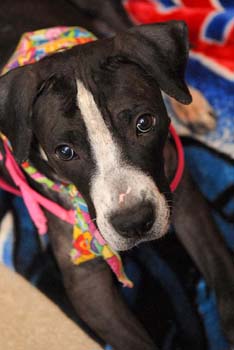 said
and done, after everything the vets and caregivers can do,
a lot is still up to the animal. And for Merci the dog (left),
that side of the equation wasn't looking very good when she
came to Best Friends. said
and done, after everything the vets and caregivers can do,
a lot is still up to the animal. And for Merci the dog (left),
that side of the equation wasn't looking very good when she
came to Best Friends.
Merci was found in about as bad shape as a dog can be, and
still be breathing. Truth be told, even the whole breathing
thing was in question — the poor girl was
barely alive. Found alongside a dumpster, Merci had a broken
leg; she was full of ticks; she was starving, and she was
dehydrated. What's more, she had horrible skin infections
and a systemic case of valley fever. Put another way, she
already had one or two feet on the Rainbow Bridge and was
getting ready to make a break for the other side.
She was rushed to Best Friends, where the first part of the
healing process could happen. Fluids, medication, good food,
expert care, and ultimately surgery on her leg pulled her
back from the brink. But that was only part of the solution.
From her side of things, Merci shut down emotionally and stayed
that way for an entire month. Life had dropped her at the
bottom of the heap and she had no intentions of getting back
up again.
Even after the surgery that should have given her some strength
back in her leg, Merci didn't want to move. She was depressed,
and she wasn't going to try, no matter what. For that long
month, her caregivers along with the medical team did all
they could to help her, but she was struggling with her part.
It seemed like she might never walk again.
There's something funny that happens at Best Friends on occasion.
Every now and again an animal will make such a dramatic turnaround
that the caregivers start to wonder about alien abductions!
(Okay, not really, but that's as good an explanation as any.)
Merci pulled off just such a turnaround. One day something
clicked inside her and she decided to try to get up one more
time.
From that point on, she has simply not been the same dog.
The valley fever, which can be treated but never cured, continues
to play tricks on her balance, but the difference this time
is that Merci keeps right on walking anyway. She might wobble
a bit as she goes, but she knows she'll get there eventually!
Besides, she's getting stronger.
Truly, it' almost like she woke up from a bad dream. All of
a sudden Merci began noticing things for the first time, even
though they'd been there all along. Things like the cookie
jar! Merci became so skillful at convincing visitors to give
her treats from the cookie jar that her caregivers were forced
to set out a bowl of more healthy treats just for Merci.
She's also been attending several of the Jin Shin Jyutsu classes
with instructor and Best Friends staffer Angela Rovetto. Angela
says Merci has become the ultimate ham in the class, stealing
the spotlight time and again. In fact, Merci's newfound enthusiasm
for life has started getting her into trouble. No longer content
to wait for somebody to notice her, Merci likes to give little
playful tugs on people's pant legs to catch their attention.
(She's landed herself square into some basic obedience classes
because of that stunt.)
There may still be some physical setbacks down the road for
Merci. But she's come so far in such a short time, it's hard
to imagine she won't face those setbacks head-on. Way to go,
Merci. You’re an inspiration to us all.
Photo
by Gary Kalpakoff

Pet cemetery offers final resting place for
beloved animals
Hinsdale Animal
Cemetery lets humans memorialize their furrycompanions
By Gerry Smith
October 26, 2009
About once a month, Carl
and Ann Christoff visit the cemetery where Mindy and Buttons
are 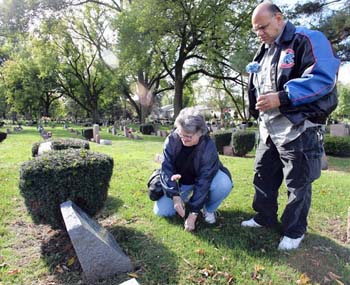 buried.
As Carl clips and sweeps grass around their graves, his wife
uses vinegar to wash bird droppings off the marble headstones.
Before they go, they leave decorations: flowers, an angel
statue or a small Christmas tree. buried.
As Carl clips and sweeps grass around their graves, his wife
uses vinegar to wash bird droppings off the marble headstones.
Before they go, they leave decorations: flowers, an angel
statue or a small Christmas tree.
This is no ordinary burial ground. Mindy and Buttons, two
Shih Tzus who died in 1990 and 2005, are among more than 15,000
pets -- including dogs , cats, deer, lizards, turtles, rodents,
monkeys and a 3-foot shark -- buried in Hinsdale Animal Cemetery
in Willowbrook , one of the nation's oldest.
To the Christoffs, of Oak Brook , these were no ordinary pets.
"At one time, every one of the animals meant so much
and brought so much joy into one's life," Ann Christoff
said.
Just how much they meant to their owners is evident from the
epitaphs. "Our Dear Pet," "Gentle Giant"
and "Loyal Friend" are common headstone inscriptions.
A mausoleum adorned with a dog sculpture reads: "He gave
up his life that a human might live. Greater love hath no
man."
"You walk through and read the inscriptions on the headstones
and some will make you laugh, some will make you cry and some
will make you think," said Bill Remkus, whose family
has owned the cemetery for four generations. "You can
almost understand the story."
Michael Schaffer, author of the book "One Nation Under
Dog," said he has noticed the messages on pet epitaphs
have evolved over time, reflecting how many people have promoted
their pets to "full-fledged members of the family."
"If you visit old pet cemeteries, the oldest headstones
might say 'Here lies Fido, a loyal servant,' or 'Here lies
Fido, man's best friend,'" said Schaffer. "Nowadays
it's 'My little girl,' or 'Mommy and Daddy miss you.' People
have developed a conception of their pets as children. That
is quite a dramatic development."
Remkus said he did not think the feelings people have for
their pets have changed, but instead, modern society has become
more accepting of people who love their pets and consider
them family. "Years ago, if you buried your pet in a
pet cemetery it would be seen as eccentric," he said.
"That's not how it's seen today. Now it is just another
way to memorialize."
Hinsdale is not a celebrity pet cemetery, although guide dogs
for blind author Bernice Clifton of Oak Park, who died in
1985, are buried here. Rather, the cemetery that began in
1926 is a memorial to many pets who faithfully serve their
owners.
The cemetery offers a variety of funeral packages. For about
$50, pet owners can purchase a "memorial cremation"
-- in which a pet's ashes are mixed with those of other pets
and scattered across the cemetery grounds. For about $2,000,
they can buy an oak casket with a vault and marble headstone.
Despite the recession, business at Hinsdale Animal Cemetery
has remained steady, although Remkus' son, Jonathan, has noticed
more "memorial cremations," which he said are "a
more economical way for a pet to still be taken care of in
a reverent manner."
Still, when it comes to finding a proper burial for man's
best friend, money is usually not a factor. "People who
are going to take care of their pets are going to do so, whether
or not they are employed or unemployed," Jonathan Remkus
said.
Or if they just spent more than $7,000 on medical bills trying
to save their pet's life, as Ernie Yamich did this summer.
Despite the high costs of sending Bogart, his 11-year-old
German shepherd, to the emergency room, Yamich said he did
not think twice about spending $2,100 on funeral arrangements
for "my first born."
"He was our baby," said Yamich, 30, a heavy equipment
operator in Chicago. "You wouldn't do any less to a human,
even in a recession."
While some owners are content to simply bury their pets at
the cemetery, others go further. Several people have been
buried with their pets at Hinsdale Animal Cemetery. And a
few people who did not have pets buried there simply chose
the cemetery as their final resting place "because they
felt it was a happy place," Jonathan Remkus said.
Carol Szabo of Naperville spent $160 for a private cremation
to ensure the ashes she received belonged to Teddy, her uncle's
beloved Shih-Tzu. Her family planned to mix Teddy's remains
with those of her uncle, Raymond Beranek, who died recently,
then bury them at St. Casimir Catholic Cemetery in Chicago.
"I'm trying to do right by my uncle and do right by the
dog," she said.
Sometimes, it is easier to do so for the dog, like when it
comes to cemetery maintenance, some owners say. When Joyce
Koziel of Frankfort visited her grandparents' graves this
summer in Alsip , her brother had to use a weed whacker to
uncover their gravestones, she said.
On the other hand, the graves of her Labrador and a Labrador/terrier
mix, Sweetness and Brandon, are in immaculate shape at Hinsdale
Animal Cemetery, she said. "What gets me a little angry
is the pet cemetery is in better shape than where my family
is buried," she said.
While the owners of Hinsdale Animal Cemetery can be credited
for this, the pristine condition of many headstones also may
be due to regular visits from people like the Christoffs,
who view washing the headstones of Buttons and Mindy as a
way of giving thanks.
"This is the reward they get from their owners for being
great companions," Ann Christoff said.
Photo:
James and Joyce Koziel find the graves of their two dogs,
Sweetness
Chuck Berman/Chicago Tribune

|

Family adopts dogs of couple killed in cycle crash
October
22, 2009
A Burr Ridge animal training center may have found the right
people to adopt four dogs that belonged 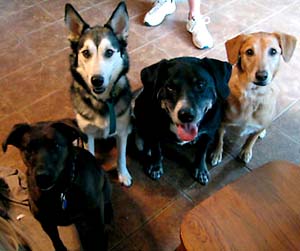 to
a couple killed in a motorcycle crash over Labor Day weekend
. to
a couple killed in a motorcycle crash over Labor Day weekend
.
Last Thursday, a family took in the four dogs that belonged
to Susan and Mike Kelms, whose wishes were to keep the dogs
together, said Kathy Deets, manager of the Chicago Canine
Club. The adoptive family has had three dogs over the years
-- but never more than one at a time, Deets said. "The
family has not made a final decision yet, but things are going
well," Deets said in an e-mail today.
One stumbling block in finding a family for the dogs has
been that many villages in the area have a legal limit
of three. But the shelter worked hard to keep the four united.
"They really like each other," Deets said last month.
The dogs are 6-year-old Anacortes, a 47-pound female American
Eskimo lab mix; 3-year-old Cedonia, a 34-pound female husky
mix; 7-year-old Tacoma, a 92-pound male lab mix, and 4-year-old
Everettt, a 47-pound male Austrian Shepherd lab mix.
A large number of people also have donated to a fund to help
care for the four dogs. "Donations have been very generous
and the dogs will be well taken care of," Deets said.
The center hopes "to know next week if everything
is final," Deets said.
The Canine Club is a boarding, daycare and training center
owned by Community Support Services, which assists people
with developmental disabilities.
Left
to right: Anacortes, Cedonia, Tacoma and Everett
Photo courtesy of the Chicago Canine Club

|

Montana:
Changes in Wolf Hunt Are Considered
By THE ASSOCIATED PRESS
October
13, 2009
Wildlife
officials will consider changes to the state’s inaugural
wolf hunt after hunters killed nine wolves in just three weeks
along the border of Yellowstone National Park. More than 1,300
gray wolves were removed from the endangered species list
in Idaho and Montana this spring after a costly federal restoration
effort. Hunting has been promoted as a way to keep the population
of the fast-breeding species in check and reduce wolf attacks
on livestock. At least 48 wolves have been killed since Sept.
1 by hunters in the two states. But all but 2 of the 11 killed
in Montana came from a small part of the Absaroka-Beartooth
Wilderness, along the northern border of Yellowstone. Four
of those wolves were from Yellowstone’s Cottonwood Pack,
including the group’s breeding female.
Concerned
about the heavily concentrated killing, state wildlife commissioners
suspended hunting last week in the area.
|

Bless
the Beasts and Doris Day Too
By NATE CHINEN
October
11, 2009
NELLIE MCKAY hadn’t made it a block from her Upper West
Side apartment when she stopped 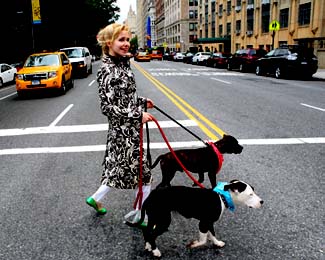 abruptly,
leash in hand, halfway across Central Park West. “Oh,”
she said, eyes widening. “I forgot Hank’s ‘Adopt
Me’ vest. Can we go back and get it?” abruptly,
leash in hand, halfway across Central Park West. “Oh,”
she said, eyes widening. “I forgot Hank’s ‘Adopt
Me’ vest. Can we go back and get it?”
Hank is a rescued pit bull, one of two in Ms. McKay’s
care. (The other one, Bessie, looks to be staying for a while.)
Both dogs appear in costume pearls on the cover of her fourth
album, “Normal as Blueberry Pie” (Verve). Their
inclusion isn’t arbitrary: the album, out on Tuesday,
pays homage to Doris Day , the perennially fresh-faced singer
and actress, now 87, who followed her record-breaking postwar
music and movie career with a leading role in animal welfare
advocacy.
On a recent afternoon, once the neon-orange vest had been
retrieved from her shabby-chic ground-floor apartment, Ms.
McKay, in a vintage red blazer, began to walk the dogs toward
the Arthur Ross Pinetum in Central Park. She took Bessie,
entrusting Hank to a reporter. Before reaching the park, there
was an adoption inquiry from a passer-by, and phone numbers
were exchanged.
Photo:
G. Paul Burnett/The New York Times
Nellie McKay, crossing Central Park West with Bessie, foreground,
and Hank
Click
√
on image for full article
|

Whispering to Rottweilers, and to C.E.O.’s
By AMY WALLACE
October 11, 2009
LOS
ANGELES -- Cesar
Millan, on location for his show, walks Chase, as Royce Chang,
the dog’s 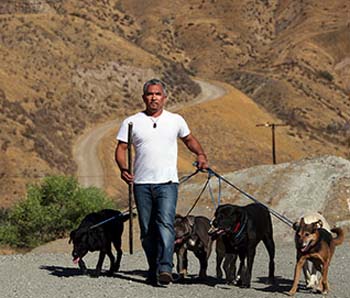 owner,
follows. Mr. Millan says he has to transform people as well
as their pets. owner,
follows. Mr. Millan says he has to transform people as well
as their pets.
IT’S a miracle. That’s what the humans believe,
more often than not, after watching this compact, 40-year-old
C.E.O. do his work. He enters a room purposefully, his chest
thrust forward and a smile on his face. “How can I help?”
is his standard introduction, and the way he says it —
calmly, assertively — indicates that your problems are
about to be solved.
It’s unbelievable. That’s what the humans say
when they see what Cesar Millan, the “Dog Whisperer,”
can do. And the dogs? To a pooch, they appear to be thinking:
“Thank God, help has finally arrived.” To prompt
a visit from Mr. Millan, these dogs have exhibited seemingly
irrational fears (of motorbikes, toasters, linoleum floors)
and strange obsessions (biting rocks, ankles, tractor tires).
Their owners, meanwhile, have told poignant, if at times ludicrous,
stories. One couple sought out Mr. Millan after their two
pit bulls, hell-bent on killing each other, forced them to
live apart. Another hadn’t slept in the same bed for
months because their Yorkies wouldn’t allow it.
If you have a television, you may know Mr. Millan from “
Dog Whisperer With Cesar Millan ,” whose  sixth-season
premiere was on Friday on the National Geographic Channel,
a cable network piped into about 70 million homes. Nearly
11 million Americans tune in each week. You may have stumbled
upon his new glossy magazine, Cesar’s Way, or his four
books, the latest of which, “ How to Raise the Perfect
Dog ,” went on sale last week. His first three books,
all New York Times best sellers, have cumulatively sold two
million copies in the United States and are available in 14
other countries. sixth-season
premiere was on Friday on the National Geographic Channel,
a cable network piped into about 70 million homes. Nearly
11 million Americans tune in each week. You may have stumbled
upon his new glossy magazine, Cesar’s Way, or his four
books, the latest of which, “ How to Raise the Perfect
Dog ,” went on sale last week. His first three books,
all New York Times best sellers, have cumulatively sold two
million copies in the United States and are available in 14
other countries.
Partly because he is based in Los Angeles, the epicenter of
the entertainment industry, Mr. Millan has become something
of a cultural icon, a Latino man who commands respect wherever
he goes. He has helped scores of movie stars and moguls —
among them alpha dogs like Oprah Winfrey , the actor Will
Smith , the former Disney chief Michael D. Eisner and the
director Ridley Scott — become pack leaders in the one
place they fail to rule: their homes.
No wonder Mr. Millan’s reputation as a fixer —
he says he rehabilitates dogs, but trains people — has
been immortalized in pop culture. “What is the ‘Dog
Whisperer’?” has been a winning answer on “Jeopardy.”
An episode of “South Park” featured the mom of
Eric Cartman, the spoiled, foul-mouthed brat, hiring Mr. Millan
to discipline him. A New Yorker article by Malcolm Gladwell
quoted scientists and dance experts analyzing how Mr. Millan’s
bearing instills confidence. The conclusion: his fluid movement
communicates authenticity better than words could.
Not bad for a once-poor native of Culiacán, Mexico,
who crossed the border illegally 19 years ago with nothing
in his pockets. (He became a United States citizen this year.)
When he talks about transformation, in other words, he’s
living proof that it’s possible.
With his wife, Ilusion, he runs Cesar Millan Inc., the center
of a constellation of businesses that coordinates all things
Cesar beyond the show, including speaking engagements; executive
leadership seminars; a line of organic dog food, fortified
water, shampoos and toys that sells at Petco; and the charitable
foundation financed by an undisclosed percentage of the company’s
revenue.
His Web site, cesarmillaninc.com , grosses annual sales in
the mid-seven figures, according to a company 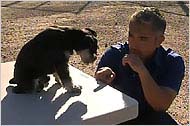 spokesman,
chiefly from DVDs, books and merchandise like the Illusion
Collar, designed by his wife to help control challenging dogs.
Nearly 400,000 visitors are on the site monthly. Then there’s
his Dog Psychology Center, a 43-acre mecca he calls a “
Disneyland for dogs.” Under construction north of here,
near where he and his family live, it will be the first of
many such centers nationwide, he says. spokesman,
chiefly from DVDs, books and merchandise like the Illusion
Collar, designed by his wife to help control challenging dogs.
Nearly 400,000 visitors are on the site monthly. Then there’s
his Dog Psychology Center, a 43-acre mecca he calls a “
Disneyland for dogs.” Under construction north of here,
near where he and his family live, it will be the first of
many such centers nationwide, he says.
According to MPH Entertainment, the production company that
is Mr. Millan’s partner in all its many offshoots and
co-owns the TV show with the producers who discovered him,
he will be a $100 million business in a few years. And he
says he’s just getting started.
“Anything that is realistic, if I create it in my mind,
it can become a reality,” he says, evoking one of his
favorite authors, the self-help superstar Wayne W. Dyer. “That
is the power of intention.”
Like the dogs that he is world-famous for understanding —
and, notably, unlike some of their owners — Mr. Millan
doesn’t judge others. Instead, he lives in the now and
maintains a sort of über-balanced mien. For without balance,
or what he calls “our most important tool: calm, assertive
energy,” no one can be a pack leader. And that, more
than anything else, is what Cesar Millan dearly wants each
of us to be — for our animals, sure, but also for ourselves
and the well-being of the planet.
“World transformation begins with self-transformation,”
he advises. To achieve that, he says, you need a co-pilot:
“My suggestion is you have somebody next to you that
is willing at any time to transform the moment. That is called
dog."
Photos:
Monica Almeida/The New York Times
Click
√
on images for full article
|

Paralyzed
pit bull still gets around
William Hageman
October
10, 2009
By all accounts, Red is a great dog. The 7-year-old pit bull
knows more than a dozen commands -- verbally and 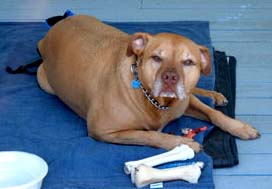 through
hand signals. He is playful, smart, protective. And that last
attribute almost got him killed. through
hand signals. He is playful, smart, protective. And that last
attribute almost got him killed.
Back in July, two gunmen attacked and robbed Red's elderly
owner in his West Side garage, beat him severely and tied
him up. Then they burglarized the man's home, where Red was.
And they shot the dog. The attack is still under investigation,
according to the Chicago Police Department .
"I guess Red was doing his job, defending his master's
property, and they shot him in the back, paralyzed him,"
said the victim, a man in his 60s who asked that his name
not be used.
Red ended up at Animal Care and Control; his owner ended up
in the hospital. When he was released, he visited the recovering
Red.
"I'd come in, hobbling with my swollen face and black
eyes, and I'd kiss him and he'd kiss me, you know?"
Finally he had to make a choice: Take Red home or have him
put down.
Because he lives on a second floor and has health issues,
he couldn't carry a paralyzed 50-pound dog up and down the
stairs several times a day. So he decided to let Red go.
"The girl (at Animal Care and Control) and I both cried,"
he said of the day he made the decision. "The staff there
all got to know him and they liked him."
But then, a PAWS Chicago representative, making one of the
shelter's daily runs to pull animals from the Animal Care
and Control facility, was told about Red. The dog quickly
won the hearts of the agency's volunteers, who donated funds
to purchase a cart to help him get around. And Saturday he'll
be in PAWS' adoption center at 1997 N. Clybourn Ave., ready
to be adopted.
"Red is obviously a very special dog," says Rochelle
Michalek, PAWS' executive director. "He has the best
disposition. He's one of the best dogs you'll ever see. The
bullet severed his spine , but you'd never know it. He's happy,
he loves to play. He's a big snuggler."

|
 First
daughters thrilled - by their dog's birthday
First
daughters thrilled - by their dog's birthday
October
10, 2009
WASHINGTON -- Moments after President Obama got the news about
winning the Nobel Peace Prize, 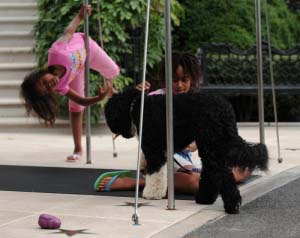 his
excited daughters came to congratulate him -- and put things
in perspective. his
excited daughters came to congratulate him -- and put things
in perspective.
Malia, 11, and Sasha, 8, came to see their dad not long after
White House Press Secretary Robert Gibbs telephoned Obama with
the news, awakening him in the early morning hours.
Appearing later in the Rose Garden, Obama said it wasn't "how
I expected to wake up this morning."
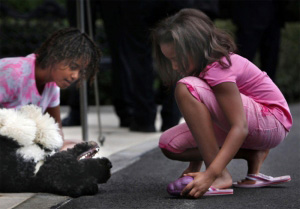 He
said that after he heard about the award, "Malia walked
in and said, 'Daddy, you won the Nobel Peace
Prize, and it is Bo's birthday.' And then Sasha
added, 'Plus, we have a three-day weekend coming up.' So it's
-- it's good to have kids to keep things in perspective." He
said that after he heard about the award, "Malia walked
in and said, 'Daddy, you won the Nobel Peace
Prize, and it is Bo's birthday.' And then Sasha
added, 'Plus, we have a three-day weekend coming up.' So it's
-- it's good to have kids to keep things in perspective."
Bo is the family's Portuguese water dog, a breed that was recommended
to the Obamas by the late Sen. Ted Kennedy. |

Selling
a Charitable Feeling, Along
With Treats for the Dog
By STUART ELLIOTT
October
9, 2009
ONE of the most popular tactics in consumer advertising these
days is what is known as cause 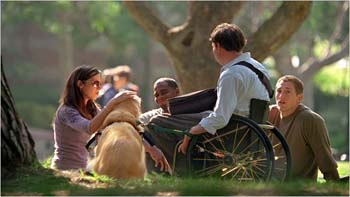 marketing
or cause-related marketing, whereby companies seek to do well
by doing good. So widespread has cause marketing become that
it is being expanded from products for people to products
for their pets. marketing
or cause-related marketing, whereby companies seek to do well
by doing good. So widespread has cause marketing become that
it is being expanded from products for people to products
for their pets.
Skip to next paragraphFor instance, for some time the Pedigree
brand of dog food sold by Mars has been promoting its support
of pet adoption. Now, Del Monte Foods is making its donations
to an organization named Canine Assistants the centerpiece
of a campaign for its Milk-Bone line of dog treats.
Underlining that focus is the theme of the campaign: “It’s
good to give.” The double meaning is meant to convey
that just as Milk-Bone is good to give your dog, you can also
get a warm and fuzzy feeling if you give to good causes —
or support brands that do.
The campaign, created by the New York and San Francisco offices
of Draft FCB, part of the Interpublic Group of Companies,
has a budget estimated at more than $10 million. The ads began
appearing on Sept. 21 and are scheduled to run through the
spring.
The campaign includes the first television commercials for
Milk-Bone in several years. There is also print advertising,
ads in coupon inserts in Sunday newspapers, information on
the Milk-Bone Web site (milk-bone.com or milkbone.com) and
elements in social media like Facebook, Flickr, Twitter and
You
 Tube.
Tube.
Milk-Bone is “a bit of a sleeping giant,” said
Christie Fleming, vice president for marketing at Del Monte
in San Francisco, and “as we thought about the next
generation of growth, reminding consumers why they should
continue to purchase Milk-Bone is critically important to
us.”
Out of those discussions came the concept of playing up the
“emotional” aspects of the brand along with the
“functional” aspects, Ms. Fleming said, an idea
encapsulated in this language on the brand’s home page:
“When you give the wholesome goodness of Milk-Bone dog
snacks, you’re giving more than cleaner teeth and fresher
breath. That’s because every time you buy Milk-Bone
dog snacks, a portion of the proceeds goes to help the Canine
Assistants organization.”
Click
√
on image for full article
|

U.S. Marines Enlist ASPCA to Keep Marine Corps
Pets & Families Together
October
9, 2009
On October 6, a team of ASPCA
animal behavior experts arrived in Beaufort, S.C., to conduct
behavior  assessments
of more than 100 dogs living in Marine Corps housing units
in the South Carolina Tri-Command area. assessments
of more than 100 dogs living in Marine Corps housing units
in the South Carolina Tri-Command area.
The visit by ASPCA
behaviorists comes after these dogs became the subject of
a breed ban recently instituted by Marine Corps headquarters.
The policy specifically bans purebred and mixed-breed Pit
Bulls, Rottweilers and wolf hybrids, as well as canines with
"dominant traits of aggression" who pose a risk
to people living in U.S. Marine Corps housing worldwide.
“Our goal in coming to the Parris Island base is to
make sure safe dogs and their families are able to stay together,”
says Dr. Emily Weiss, ASPCA
Senior Director of Shelter Research & Development, “and
so far, the results have been positive."
After assessing individual canines with SAFER (the ASPCA
Safety Assessment for Evaluation Rehoming)—a research-based
tool that helps identify the likelihood of canine aggression—ASPCA
behaviorists report that of the approximately 65 dogs assessed
to date, only two have had significant aggression issues.
“One, we believe, will be able to be managed while on
base,” comments Dr. Weiss. “The vast majority,
however, are well-loved, well-behaved family pets.”
The families of safe dogs will be given the opportunity to
apply for a waiver, allowing their dog to remain on the base
until 2012. "We're very excited about the ASPCA’s
assessment," says Army Capt. Jenifer Gustafson, the Officer
in Charge of the veterinary clinic on Parris Island. "This
is a welcome alternative to the unpleasant possibility of
pet parents being forced to give up their dogs or leave base
housing.”
The ASPCA
is opposed to breed bans, which target entire breeds instead
of focusing on individual dogs. Aggressive canines are often
the result of owners failing to provide proper training. Our
organization continues to work on identifying potential aggression
in individual dogs, opening up opportunities for behavior
modification.

Connecticut, Protect Your Pets —
Trust Act Is Now Law!
October
9, 2009
Thanks to a new law that went into effect last Thursday, Connecticut
residents may now make legally 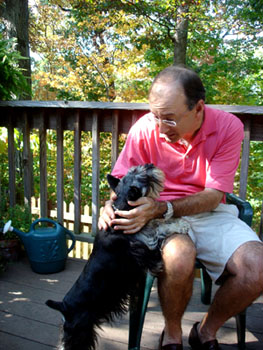 binding
arrangements for their animals. The law, titled An
Act Concerning the Creation of a Trust for the Care of an
Animal, allows pet parents to set up enforceable
pet trusts to provide care and stability for animals in the
event of their owner's death or disability. Governor M. Jodi
Rell signed the act into law in June—before it became
effective on October 1, animal trusts in Connecticut were
not enforceable and considered merely "honorary." binding
arrangements for their animals. The law, titled An
Act Concerning the Creation of a Trust for the Care of an
Animal, allows pet parents to set up enforceable
pet trusts to provide care and stability for animals in the
event of their owner's death or disability. Governor M. Jodi
Rell signed the act into law in June—before it became
effective on October 1, animal trusts in Connecticut were
not enforceable and considered merely "honorary."
Forty-two states, including NY and NJ, now have some form
of pet trust law. Like any aspect of estate management, laws
vary from state to state and creating a pet trust requires
advanced planning.
"As the legal wrangling over the Leona Helmsley estate
has illustrated, careful consideration has to be given to
the language creating a pet trust in order to safeguard the
pet owner's wishes," warns Debora Bresch, attorney and
ASPCA
legislative liaison to Connecticut. "If you are interested
in setting up a pet trust, be sure to work with a legal professional
who is familiar with them—or at the very least, one
who is comfortable with the concept, specializes in trusts,
and is familiar with the care and maintenance needs of pets."
Visit ASPCA's
Pet Care pages to learn more about how to begin the process
of creating
a pet trust.
Photo:
Robert Coane
|

A Case of Pet Care and Politics
By PETER APPLEBOME
October
8, 2009
 GARRISON,
N.Y. -- Two things struck many people as odd three years ago
when sheriff’s deputies came to Sandy Saunders’s
150-acre farm, said they had found “shocking” conditions,
arrested him on nine counts of animal cruelty, and seized five
horses, three sheep and a goat that have never been returned. GARRISON,
N.Y. -- Two things struck many people as odd three years ago
when sheriff’s deputies came to Sandy Saunders’s
150-acre farm, said they had found “shocking” conditions,
arrested him on nine counts of animal cruelty, and seized five
horses, three sheep and a goat that have never been returned.
The first was that the barn owned by Mr. Saunders, a well-known
local environmentalist and gadfly, was a popular and quite public
gathering place. In the five weeks before the animals were seized,
an annual barn dance there brought out perhaps 200 people, and
a political fund-raiser drew 150. A woman who had visited with
her children said that she had seen dozens of farms and that
Mr. Saunders’s was “one of the cleanest and well-maintained
I have come across.”
The second was that Barbara Dunn, the deputy who seized the
animals and participated in a separate raid and arrest involving
the care of purebred Maltese dogs that same month, was also
the president of the Putnam Humane Society, where the animals
were taken, which struck many people as an unfortunate mixing
of responsibilities.
The two arrests set in motion a series of legal proceedings
that culminated in the indictment of Deputy Dunn this week on
28 counts, including grand larceny, perjury and official misconduct,
some stemming from her testimony in the investigation involving
the dogs.
It would be nice if the indictment suggested a clear motivation.
Instead, it’s more of a reminder that while politics involving
humans can be pretty complicated, they’re nothing compared
to the politics of people and critters.
Mr. Saunders’s case had no direct bearing on the indictment,
a result of an 18-month investigation. Deputy Dunn was accused
of larceny, insurance fraud and official misconduct for claiming
workplace injuries when, in fact, she had fallen off a horse,
prosecutors say. And she was accused of perjury and official
misconduct in connection with her testimony about the seizure
of the dogs from Linda Nelson, a breeder in Kent.
Deputy Dunn pleaded not guilty to all of the charges on Monday.
William Aronwald, her lawyer, said the notion that she was improperly
acting in the interests of the Humane Society ignored the evidence.
“She took six Maltese dogs that hadn’t been fed,
had no water, were sitting in their own excrement from a sweltering,
hot room and took them to the Humane Society,” he said.
“What other recourse did she have? Just leave them there?
I don’t think there’s any evidence at all that the
Humane Society benefited from this.”
The problem is that a State Supreme Court judge, Justice Andrew
P. O’Rourke, in dismissing charges against Ms. Nelson,
ruled otherwise, saying: “Deputy Dunn, in her position
as president of the Humane Society, engaged in a public campaign
to garner support for the renewal of the society’s contract
with the county. She increased the number of seizures of animals
and sought increased fines for animal-related violations in
order to increase the coffers of the Humane Society.”
It’s small potatoes, unless you’re the one accused.
In addition to the worthy work that animal protection groups
do, there have been allegations elsewhere of animals improperly
seized and reputations ruined out of excess zeal. An investigation
by “20/20” in 2005 included numerous claims from
people who said that instead of helping them care for wanted
pets, the local Society for the Prevention of Cruelty to Animals
confiscated their animals, sold them within days and kept the
money.
BUT if that kind of conflict was at work, it didn’t show
up in the indictment. Christopher York, the chief assistant
district attorney in Putnam County, said he had no way of knowing
if any improprieties in Deputy Dunn’s conduct were affected
by excess zeal for animal rights, the interests of the Humane
Society or a belief that she was acting properly. “We
don’t have to prove motivation,” he said.
Still, regardless of whether she’s found guilty, you could
deduce three things. The first is that an accusation of animal
abuse can be as damaging as one of child abuse. Mr. Saunders
found himself reported on animal abuse Web sites. (He agreed
to give up the animals in return for the dismissal of the charges
against him.) The second is that being on the side of the animals
doesn’t necessarily mean you’re on the side of the
angels. And the third is that giving the president of the local
Humane Society a badge and a license to investigate animal abuse
isn’t the smartest move. |
 Wire
Services Wire
Services
Weird but True
By
LUKAS I. ALPERT
November
11, 2009
You've
heard about hero police dogs. This is not one of them.
An Oregon burglar trying to break into a residence escaped
cops after a police dog bit the innocent homeowner and let
the prowler get away.
Adding insult to injury, police have yet to apologize to the
man, who suffered a chomp on the butt.
The police chief said only that the incident was "unfortunate."
•••
Call
it the paws of life.
A Polish man who suffered a heart attack was revived when
his pet Jack Russell terrier hopped up and down on his chest,
jump-starting his ticker.
"I want everyone to know how much I love my big-hearted
dog," said Piotr Wagner, pointing to a heart-shaped marking
on the dog's side.
•••
October
9, 2009
Whoa,
doggy!
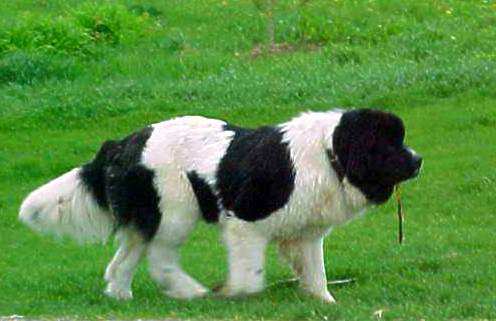
A massive pooch named Boomer (above) who stands 3 feet tall
and 7 feet long from nose to tail may be the world's biggest
living dog.
The 3-year-old, 180-pound Landseer Newfoundland, who lives
on a farm in Casselton, ND, can drink from the faucet without
lifting his paws off the ground. He also gobbles up a 20-pound
bag of dry food a week.
|
 Wire
Services Wire
Services
Weird but True
By
LUKAS I. ALPERTOctober
5, 2009

He got so depressed
about moving out of Paris' Elysée Palace that he started
kicking -- make that biting -- ass.
No, it wasn't ex-French President Jacques Chirac. Former First
Dog Sumo was so upset about leaving his home of 12 years,
he started chomping on the ex-president's buttocks.
He was exiled to a farm.
• • •
September 30, 2009
This
Gives new meaning to the phrase"inside dope."
A
30-year-old Florida man was bustedafter a bag of cocaine "shot
out" of his rear end during a traffic stop.
After
a drug-sniffing Canine indicated that Warren Wiley had drugs
on him, cops searched him but found nothing. But they noticed
that he had his butt cheeks clenched and asked him to relax,
which sent the bag flying.
|

Court Hears Free-Speech Case on Dogfight Videos
By ADAM LIPTAK
October
7, 2009
WASHINGTON — Justice Samuel A. Alito Jr. wanted to know
if Congress could ban a “Human  Sacrifice
Channel” on cable television. Sacrifice
Channel” on cable television.
Justice Ruth Bader Ginsburg asked about videos of cockfighting.
“What about hunting with a bow and arrow out of season?”
Justice John Paul Stevens asked.
“What if I am an aficionado of bullfights,” Justice
Antonin Scalia wondered, “and I think, contrary to the
animal cruelty people, they ennoble both beast and man?”
And Justice Stephen G. Breyer asked about “stuffing
geese for pâté de foie gras.”
The rapid-fire inquiries came in an exceptionally lively Supreme
Court argument on Tuesday in the most important free speech
case this term.
The case concerns the constitutionality of a 1999 federal
law that bans commercial trafficking in “depictions
of animal cruelty.” The number and variety of questions
suggested that most of the justices thought the law was written
too broadly and thus ran afoul of the First Amendment.
In defending the 1999 law, Neal K. Katyal, a deputy solicitor
general, cautioned the justices against pursuing an “endless
stream of fanciful hypotheticals.”
Mr. Katyal reminded the justices that the case before them
concerned videos of dogfights and that the law itself was
mainly prompted by so-called crush videos, which cater to
a sexual fetish. Those videos show women in high heels stepping
on small animals.
But the 1999 law by its terms applies to audio and video depictions
of all sorts of activities in which “a living animal
is intentionally maimed, mutilated, tortured, wounded or killed”
if that conduct was illegal where the depiction was sold.
The case before the court, United States v. Stevens, No. 08-769,
arose from the conviction of a Virginia man for selling videos
of dogfights. The man, Robert J. Stevens , was sentenced to
37 months in prison. The federal appeals court in Philadelphia
last year overturned Mr. Stevens’s conviction and struck
down the law on First Amendment grounds.
Patricia A. Millett, a lawyer for Mr. Stevens, urged the justices
to follow suit, saying the law could not be rendered constitutional
by narrowing it through judicial interpretation.
“There is interpreting and then there is alchemy,”
Ms. Millett said, “ and I think this statute requires
alchemy.”
The law does exempt materials with “serious religious,
political, scientific, educational, journalistic, historical,
or artistic value.”
But several justices indicated a discomfort with the vagueness
of that standard and with entrusting the question of a work’s
“serious value” to prosecutors and juries.
“Could you tell me what the difference is between these
videos and David Roma’s documentary on pit bulls?”
Justice Sonia Sotomayor asked Mr. Katyal, referring to “Off
the Chain,” an exposé of dogfighting . “David
Roma’s documentary had much, much more footage on the
actual animal cruelty than the films at issue here.”
Mr. Katyal responded that “the line will sometimes be
difficult to draw.”
Justice Scalia said the law violates the First Amendment by
treating speech condemning depictions of animals fighting
more favorably than speech celebrating the fighting. Mr. Stevens’s
“message is that getting animals to fight is fun,”
Justice Scalia said.
The hypothetical Human Sacrifice Channel came up late in the
argument. Justice Alito described how it would work.
“Suppose that it is legally taking place someplace in
the world,” he said. “I mean, people here would
probably love to see it. Live, pay per view, you know, on
the Human Sacrifice Channel.”
Ms. Millett haltingly said that Congress could not ban such
a channel solely on the ground that it was offensive.
Mr. Katyal, to the apparent surprise of some of the justices,
agreed, saying the First Amendment would not permit a law
banning such a channel unless it could be shown that the depictions
made the sacrifices more likely. The distastefulness of the
depictions alone would not justify the ban.
The justices did not seem inclined to expand categories of
speech outside the protection of the First Amendment, notably
obscenity and child pornography , to encompass violent images
unrelated to sex.
In child pornography, Justice Ginsburg said, “the very
taking of the picture is the offense — that’s
the abuse of the child.” In dogfighting, by contrast,
she continued, “the abuse of the dog and the promotion
of the fight is separate from the filming of it.”
Ms. Millett agreed. “If you throw away every dogfighting
video in the country tomorrow,” Ms. Millett said, “dogfighting
will continue.”
Justice Breyer suggested that Congress would be able to draft
a more carefully tailored law focusing on crush videos and
the kinds of animal cruelty that are illegal in all of the
states.
“Why not do a simpler thing?” Justice Breyer asked.
“Ask Congress to write a statute that actually aims
at those frightful things it was trying to prohibit.”
“I am not giving Congress advice,” he added, “though
I seem to be.”
Photo:
Doug Mills/The New York Times

|

Exploring the Health Benefits of Pets
By CARLA BARANAUCKAS
October
5, 2009
When Chad, a yellow Labrador retriever, moved in with Claire
Vaccaro’s family in Manhattan last  spring,
he already had an important role. As an autism service dog,
he was joining the family to help protect Ms. Vaccaro’s
11-year-old son, Milo — especially in public, where
he often had tantrums or tried to run away. spring,
he already had an important role. As an autism service dog,
he was joining the family to help protect Ms. Vaccaro’s
11-year-old son, Milo — especially in public, where
he often had tantrums or tried to run away.
This week Dr. Melissa Nishawala, clinical director of the
autism-spectrum service at the Child Study Center at New York
University,answers questions about pet therapy, companion
animals and the treatment of autism spectrum disorder.
Like many companion animals, whether service dogs or pets,
Chad had an immediate effect — the kind of effect that
is noticeable but has yet to be fully understood through scientific
study. And it went beyond the tether that connects dog and
boy in public.
“Within, I would say, a week, I noticed enormous changes,”
Ms. Vaccaro said of Milo, whose autism impairs his ability
to communicate and form social bonds. “More and more
changes have happened over the months as their bond has grown.
He’s much calmer. He can concentrate for much longer
periods of time. It’s almost like a cloud has lifted.”
Dr. Melissa A. Nishawala, clinical director of the autism-spectrum
service at the Child Study Center at New York University ,
said she saw “a prominent and noticeable change”
in Milo, even though the dog just sat quietly in the room.
“He started to give me narratives in a way he never
did,” she said, adding that most of them were about
the dog.
The changes have been so profound that Ms. Vaccaro and Dr.
Nishawala are starting to talk about weaning Milo from some
of his medication.
Anecdotes abound on the benefits of companion animals —
whether service and therapy animals or family pets —
on human health. But in-depth studies have been rare. Now
the Eunice Kennedy Shriver National Institute of Child Health
and Human Development, part of the National Institutes of
Health , is embarking on an effort to study whether these
animals can have a tangible effect on children’s well-being.
In partnership with the Waltham Center for Pet Nutrition in
England (part of the Mars candy and pet food company), the
child health institute is seeking proposals that “focus
on the interaction between humans and animals.” In particular,
it is looking for studies on how these interactions affect
typical development and health, and whether they have therapeutic
and public-health benefits. It also invites applications for
studies that “address why relationships with pets are
more important to some children than to others” and
that “explore the quality of child-pet relationships,
noting variability of human-animal relationships within a
family.”
The national institutes’ interest in this type of research
goes back at least two decades. Valerie Maholmes, who directs
research on child development and behavior at the children’s
health institute, said that at a broad-ranging meeting in
1987 on the health benefits of pets, the N.I.H. “concluded
that there needed to be much more research,” especially
on child development.
Other sessions confirmed the need for research, but most studies
focused on negative interactions, like the ways pets could
spread disease, said James A. Griffin, the institute’s
deputy chief of child development and behavior.
Meanwhile, the Waltham Center was expanding its own research
to do some small studies about human-animal interaction, said
Catherine E. Woteki, global director of scientific affairs
for Mars Inc. “We are a pet food company and pet care
company,” Dr. Woteki said, “and we’re interested
in seeing that that relationship stays a strong one.”
Reviews of the Waltham research program indicated that larger
studies over longer terms with appropriate control groups
were needed. When Mars became aware of the institutes’
interest in this type of research, a public-private partnership
was established, with the company committing more than $2
million. The National Institute of Nursing is also providing
money.
Peggy McCardle, chief of the institutes’ child development
and behavior branch, said the money from Mars helped jump-start
the efforts. Dr. McCardle added that the N.I.H. had established
protocols for public-private partnerships and that all proposals
got two levels of review before being approved.
People working with animals expect the research to back up
their observations. At Children’s Hospital of Orange
County in Southern California, for instance, dozens of volunteers
regularly take their dogs to visit patients. Children being
treated for serious illnesses often have the blues, anxiety
or depression. The dogs brighten them up,” said Emily
Grankowski, who oversees the pet therapy program at the hospital.
Some patients who have refused to speak will talk to the dogs,
she said, and others who have refused to move often reach
for the dogs so they can pet them. So the animals become part
of the therapeutic program, especially in the areas involving
speech and movement.
“The human-animal bond bypasses the intellect and goes
straight to the heart and emotions and nurtures us in ways
that nothing else can,” said Karin Winegar, whose book
“Saved: Rescued Animals and the Lives They Transform”
(Da Capo, 2008) chronicles human-animal interactions. “We’ve
seen this from coast to coast, whether it’s disabled
children at a riding center in California or a nursing home
in Minnesota, where a woman with Alzheimer’s could not
recognize her husband but she could recognize their beloved
dog.”
Such observations are not new at Autism Service Dogs of America,
which brought Milo and Chad together. “Many children
with autism can’t relate to a human,” said its
director, Pris Taylor, “but they can relate to a dog.”
Photo:
Tommy Conforti, a cancer patient, and Lady, a therapy dog.
Michal Czerwonka for The New York Times
|

Call
of the wild
Ma ditches city to raise wolves
By CYNTHIA R. FAGEN
October
5, 2009
Who's afraid of the big, bad wolf?
Not Maggie Howell (below with Atka), 37, who traded in her
Wall Street job years ago to run the Wolf Conservation 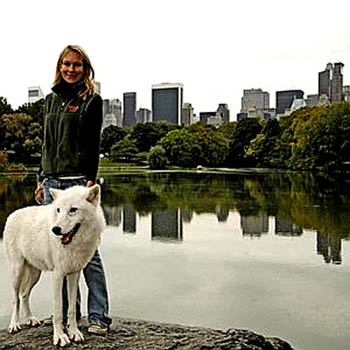 Center
in the sleepy Westchester suburb of South Salem, about an
hour's ride from Central Park. Center
in the sleepy Westchester suburb of South Salem, about an
hour's ride from Central Park.
Howell's bumper sticker reads, "Got Wolf?" But
she's not kidding.
Atka, a stunning white 85-pound arctic gray, rides in the
back of Howell's work van in a crate, traveling to schools,
the Museum of Natural History and other events acting as
an ambassador for his endangered species.
The 7-year-old wolf was in town recently to promote National
Wolf Awareness Week, beginning Oct. 11. "He's a rock
star. He loves to pose for the camera," boasted Howell,
who grew up a city kid in Chelsea and is the married mother
of a 2?-year-old girl, Eleanor.
Atka is one of four arctic grays born in captivity on the
27-acre wooded spread, along with 22 Mexican gray wolves,
indigenous to New Mexico and Arizona, and three red wolves,
whose habitat is in North Carolina.
He and his three arctic gray counterparts travel around
interacting with 30,000 humans a year as part of the center's
outreach program to educate people.
Still, there's no petting them. They're "socialized"
because they've been around people, but that doesn't mean
they can be handled by the public.
To help keep Atka calm during his travels, he has a road
buddy with him, a German shepherd named Kai. The dog travels
in the front seat of Howell's work van during their road
trips.
The aim of the nonprofit center, which receives 7,000 visitors
a year, is to raise healthy offspring from selected wolf
packs as potential candidates to be released in areas where
they were once hunted nearly to extinction. It seems to
be working. Where there were once only seven Mexican gray
wolves left in the wild, now there are close to 400. And
the center hopes to eventually help reintroduce red wolves
in North Carolina in its Alligator River National Wildlife
Refuge.
The 10-year-old Wolf Conservation Center was co-founded
by renowned classical pianist Helene Grimaud.
Photo
by Chad Rachman/N.Y.Post: Maggie Howell with Atka

Click √
on logo for Wolf Conservation Center
|

Modern
Love
An
Affection Multiplier, With Four Feet and Wet Nose
By BOB MORRIS
October
4, 2009
THE nine-pound longhaired miniature dachshund at the animal
shelter wasn’t the kind of dog I imagined  walking
in Manhattan. She was a little lap dog and a cliché,
too small for someone as insecure and image conscious as
me. And her name was Zoe — too cutesy. I put a deposit
down on her anyway. walking
in Manhattan. She was a little lap dog and a cliché,
too small for someone as insecure and image conscious as
me. And her name was Zoe — too cutesy. I put a deposit
down on her anyway.
“She’s just not the dog I imagined losing my
freedom for,” I wailed like a freaked-out groom before
his wedding night. “She’s too small. She’s
just too gay!”
A form to fill out asked, “Why do you want a dog?”
The answer should have been simple: companionship. But it
was more complicated than that.
Bob Morris is the author of “Assisted Loving:
True Tales of Double Dating With My Dad.”
Click
√
on image for full article
Illustration
by Christopher Silas Neal
|

When
Illness Brings You Closer to Animals: The Animal Rescuer
By Tara Parker-Pope
October
4, 2009
Stefanie Rinza began rescuing animals after a long illness.
Much has been written about the healing power of pets and
how animals of all kinds can improve health. 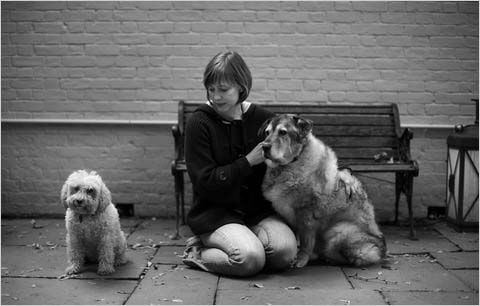 Scientists
have even studied whether pet owners begin to look like
their dogs . Scientists
have even studied whether pet owners begin to look like
their dogs .
But sometimes, poor health brings us closer to our pets.
Dana Jennings of The New York Times has shared how aggressive
prostate cancer has changed his relationship with his dog
Bijou and the lessons he has learned from her.
Stefanie Rinza (left), 44, a fine antiques dealer, relates
how her poor health prompted her to seek the companionship
of a rescue dog.
“I had always had this underlying feeling that I was
desperate to have a dog,” she says. “But the
real conscious realization came when I was 30 years old
and had a very bad illness that was kind of scary, and it
could have been worse. I thought, ‘Why is it I’ve
worked so very hard and don’t fulfill the one dream
I have and that is to have a dog?’
"As
soon as I was better I went to the Battersea shelter in
London and picked out a dog that had been there for 11 months,
Jasper. He's probably 16 now. We have four dogs, all of
them rescued in some way. Jasper was the first.
"The
next one was Dinky, who I on a flier in the Corner Bookstore
on 93rd, looking really sad. And Charlie -- another flier
I couldn't say no to.
"And
the fourth one was Tilly, who I saw running on Fifth Avenue
in the morning rush hour. She'd been living in the park,
clearly; she was filthy.What I didn't know then was that
she only had oe eye.
"I
started running straight into the traffic head-on. I must've
looked quite mad, with Prada slippers and handbag. I think
for that reason the cars stopped. But Tilly actually didn't
stop. She kept zigzagging on the road. She crossed 96th
Street ywice and then headed toward Madison and we were
weaving through the cars. And in the end I kind of did a
full-length tackle and just grabbed her and I thought, 'Well,
you can bite my face, if you want, I'm going to just hold
you anyway.' So I did hold onto her. She didn't try to bite
me.
"She
fell asleep for the whole day and then I walked her in the
evening and, halfway through the walk, she turned around
and sat down in front of me. I went down to see what was
going on and she came up to me and kissed my hand.
"There's
this gratitude, these just incredible ways that they use
to express themselves. That never ends as long as you have
that animal. What I love is when someone has just been rescued
and when they come here and have their first good sleep.
When they curl up and you can see that they feel really
safe for the first time and they can rest. After everything
they've been through, they're willing to trust someone and
give them their love and devotion.
"I'm
very sure that all of them would have protected me if there
had ever been an issue. They're very, very loyal."
Ms. Rinza today is in good health, has 4 rescue dogs and
has found homes for about 40 animals of all kinds, including
a lost bunny, white doves released at a wedding and a kitten
stranded in the trunk of a drunken driver’s car.
Click
√
on the photo above to hear Stefanie Rinza's
full story and see photos of her animals
Photo:
Todd Heisler/The New York Times
|

Please releash me! Dog is home
By WILLIAM J. GORTA
October
3, 2009
A dog owner who handed off her small pooch to a friend because
of her busy schedule was awarded  custody
of the pet yesterday after a six-month court battle. custody
of the pet yesterday after a six-month court battle.
Queens Supreme Court Justice Valerie Brathwaite Nelson said
in her decision that Ravely Arias intended to leave Panda,
a Teacup Yorkie, with Leandro Rohde only for a short time
-- and not make a gift of the pooch, as Rohde asserted.
Arias said her work schedule was so hectic that, in January
2009, she dropped the dog off with Rohde until her hours settled
down. But Rohde said Arias turned over Panda's health records
and registration, and that the dog was his.
The judge said Rohde did not try to register the dog as his
own until Arias asked for Panda's return.
She found that Arias never abandoned Panda and continually
checked up on his well-being.
Rohde called the decision "sad," because Panda feels
at home with him. "She's not even showing up for the
[court-approved] visits," Rohde said.
Arias did not immediately return a call for comment, but her
lawyer said the decision showed "compassion."
"Miss Arias is thrilled to finally get Panda back,"
said Joshua Krakowsky of Davidoff, Malito and Hutcher. "It's
not a dog-eat-dog world after all." |

Editorial
A
Quarterback’s Second Chance
September
27, 2009
After serving 18 months in prison for running an elaborate and
sadistic dogfighting ring, Michael Vick, the professional quarterback,
returns to a regular-season game Sunday in Philadelphia. There
may be as much spectacle off the field as on. One cynical entrepreneur
is peddling “Vick” jerseys for dogs. An animal rescue
group offered dog food donations for each tackling of the former
all-star.
But the real lesson in the Vick conviction is that dogfighting
remains a nationwide scourge. Federal agents busted an eight-state,
400-dog ring in July, arresting 26 alleged practitioners, including
a schoolteacher and a Little League coach.
The Humane Society of the United States estimates there are
40,000 organized professionals who, as in Mr. Vick’s interstate
ring, illegally breed, match and ruthlessly destroy countless
canines for the private entertainment of big-money bettors.
“Breed the best, bury the rest” is one cynical comment
on the culture. Mr. Vick first denied, then admitted to personally
killing a half-dozen wounded losers.
It remains to be seen how effectively the gifted athlete delivers
on his probation vow to become a cautionary role model for urban
youngsters involved in the booming subculture of street-corner
dogfighting. A recent address to Philadelphia youngsters was
heavier on bromides about leadership than his culpability for
tormenting animals.
The Humane Society has used the Vick case to help toughen anti-cruelty
laws in 26 states. And arrests and convictions for dogfighting
are up across the nation. But agents of the Pennsylvania Society
for the Prevention of Cruelty to Animals also warn that, since
Mr. Vick’s notoriety, street dogfighting appears to be
more popular among youngsters as “the thing to do.”
We hope Mr. Vick will use his second chance to reach out to
impressionable youngsters and tell them the truth: There is
no honor or glamour in dogfighting, only shame and a jail sentence.

|
 
First
Annual Brooklyn Bridge 'Pup' Crawl
Excerpted from various sources
September
27, 2009
BROOKLYN, N.Y. -- More than 400 dogs -- from chihuahuas to
Great Danes -- took to the iconic Brooklyn  Bridge
under cover of darkness on Saturday, September 26 to raise
funds for the 1 million pets that, according to ASPCA
estimates, have lost or will lose their homes to foreclosure. Bridge
under cover of darkness on Saturday, September 26 to raise
funds for the 1 million pets that, according to ASPCA
estimates, have lost or will lose their homes to foreclosure.
"The down economy has hit animal shelters twice as hard,"
said Howard Wu, Kennel Supervisor for the Brooklyn Animal
Resource Coalition (BARC), a non-profit, no-kill animal rescue
shelter in New York City and one beneficiary of The Pup Crawl
. "There is an increase in the number of animals being
abandoned because people can't afford to care for them any
longer and, at the same time, we are seeing a sharp decline
in donations. We're caring for more animals with fewer funds."
The Brooklyn Bridge Pup Crawl was inspired by a nighttime
newscast that alerted some concerned New Yorkers about the
devastating impact of the economic crisis on pets.
"Our goal is to help feed as many pets as possible in
animal shelters across the country," said Joseph Hassan,
one organizer of The Pup Crawl. "Twenty dollars is enough
to feed one shelter pet for an entire month. If we get people
across the country to realize the staggering number of pets
that have lost their homes and the increased financial burden
that this places on shelters, we might just tug at their heartstrings
enough to get them to donate to their own local shelters,"
Hassan said.
To get the event rolling, the 29-year-old communications consultant
corralled dozens of volunteers to help and reached out to
companies that donated products.
Mr. Hassan and his friends reached out to sympathetic businesses
like Iams to provide pet food. Another partner, The LuLu Leash
, donated the first-ever illuminated dog leash to highlight
the nighttime dog walk, the cause and to help keep participants
safe. And innovative music cooperative East Village Radio
offered to start spreading the word over its airwaves.
In addition to the Brooklyn shelter, other official Pup Crawl
partner shelters included Get-A-Life Pet Rescue in Fort Lauderdale
and Ace of Hearts in Los Angeles, making the effort a true
coast-to-coast initiative. Organizers encouraged Americans
to donate to local shelters across the country.
Despite having no dog - his landlord doesn't allow pets -
Hassan's Williamsburg apartment resembles a dog food factory,
piled high with hundreds of pounds of kibble generously donated
by IAMS .
Lulu Leash, a Florida -based company, donated the illuminated
dog leashes that will be distributed to every dog registered
for the event.
Proceeds from the event will be donated to local and national
animal shelters in Florida and California .
"If, months down the line, we hear that one pup or kitten
-- we love cats, too -- has been reunited with a family that
gave them up because of the financial crisis, we'll have done
our job," said Mr. Hassan.
For more on The Pup Crawl and to find a partner shelter to
which to donate visit www.thepupcrawl.com
The fall season is chock-full of fun events to help raise
funds for needy animals, including dozens of adoption events
around the city.
Here's a sampling:
• On Thursday, October 1, gamble alongside celebrities
including Chuck Scarborough and Q104.3 deejay Maria Milito
at the Bet for Pets Casino night at Marquee in Chelsea. Organizers
hope to raise $20,000 to help fund the city's first low-cost
"M.A.S.H.-style" spay/neuter clinics. www.ua4a.org
.
• Sunday, Oct. 4, Stray from the Heart hosts its Oktoberfest
at the Boat Basin Cafe at W.79th St. from 3 p.m. to 6:30 p.m.
Proceeds fund its rescue effort, which includes pit bulls
and other hard-to-place dogs. www.strayfromtheheart.org .
• Oct. 10 to Oct. 18 marks the first New York Week for
Animals. Throughout the week, shelters, rescue groups and
humane organizations across the state will host animal-related
events. To get involved, go to www.newyorkanimals.org .
Photo
by José Martínez for The New York Times:
A Pomeranian named Amelie on a leash lighted with LEDs
in a practice crawl over the Brooklyn Bridge.
|

Urbanhound, After 10 Years, Shuts Down
By ALEXIS MAINLAND
September
25, 2009
A decade is a long time in dog years, and in Web years, too.

And so,
on Wednesday, Urbanhound, a site conceived as “the city
dog’s ultimate survival guide” at the peak of
the dot-com frenzy, announced that it had run its course after
10 years and was shutting down, surprising thousands of New
Yorkers who depended on its advice and considered it a permanent
fixture within the city’s zealous dog culture.
Nina Munk (below), the site’s creator and editor, said
that Urbanhound never generated enough  revenue
to justify itself as a stand-alone Web site. revenue
to justify itself as a stand-alone Web site.
“We always ran on a shoestring,” said Ms. Munk,
whose sister, Cheyne Munk Beys, was her partner in the business
they ran out of a studio apartment. “It was a labor
of love.”
Ms. Munk, a business journalist and a contributing editor
at Vanity Fair, said that Urbanhound, seeking a partner to
bolster the site’s national expansion, had attracted
and lost three potential buyers shortly before the economic
crisis began last fall.
“When the third deal fell through and the recession
hit, we had to dramatically cut back on every expense,”
she said. “Unfortunately, with the Internet, there is
still a divide between providing something people really want
and discovering the secret to monetizing it.”
An e-mail message from Ms. Munk informed 25,000 subscribers
on Wednesday afternoon that Urbanhound had closed. By then,
the site’s content was already inaccessible, and a note
thanking its “large and loyal community” had been
posted.
Urbanhound offered a curated compendium for dog owners that
reflected Ms. Munk’s journalistic background and passion
for animals.
On the last day of Urbanhound, reflecting on the many ways
the New York dog landscape has evolved since she started the
site, Ms. Munk said that even though dogs had increasingly
become a kind of fetishized luxury item, her goal was always
to provide high-quality information and to avoid an air of
rhinestone-collar, designer-breed consumerism.
“In the end, it wasn’t enough,” she said.
|
A
FAREWELL
Dear
Urbanhounders,
Ten years after launching Urbanhound from our living
room, we're folding our tent and moving on. Urbanhound
always operated on a shoestring; but thanks to your
support we had far more impact on dogs and their humans
than our budget might have suggested.
From the get-go, the media was unanimous in its praise
of Urbanhound. Entertainment Weekly named us "Best
in Show." The Wall Street Journal said we were
"wry" and "cool." Forbes, which
added us to its "Best of the Web" list, said
we were "sophisticated and sassy." Our start-up
was the subject of an article in the New York Times
Magazine . We were featured on Life/Style TV .
David Carr wrote about our expansion in his New York
Times' column. Cindy Adams was a devoted fan.
Over the years, to reach an audience beyond the Internet,
we published two spin-off books: " The Complete
Healthy Dog HandBook " (2009) and " Urbanhound:
The New York City Dog's Ultimate Survival Guide "
(2002).
But our greatest accomplishment was building a large
and loyal community of dog people all across the United
States. You posted photos of your dogs on urbanhound.com,
subscribed to our newsletters, contributed to our message
boards, bought our books, and otherwise helped keep
us afloat. Thank you!
When Urbanhound began, our mascot, the handsome Brittany
named Mack, was a puppy. In the years since, he has
aged gracefully. We like to think we have too.
With best wishes to you and to your best friends, yours,
Nina
Munk & Cheyne Munk Beys
|
Photo
of Nina Munk by Mark Shäfer
EDITORIAL
COMMENT
Sad.
One less good thing in New York City.
|

NYC Must Create More Animal Shelters
September
24, 2009
The ASPCA
applauds a decision by the New York State Supreme Court to
uphold a 2000 law  mandating
the existence of full-service animal shelters in all five
New York City boroughs. In last week’s ruling, Manhattan
Supreme Court Justice Marilyn Shafer gave the City 60 days
to come up with a plan to implement the law (pdf) which
will ultimately allow for more animals to be adopted and fewer
to be euthanized. mandating
the existence of full-service animal shelters in all five
New York City boroughs. In last week’s ruling, Manhattan
Supreme Court Justice Marilyn Shafer gave the City 60 days
to come up with a plan to implement the law (pdf) which
will ultimately allow for more animals to be adopted and fewer
to be euthanized.
While the boroughs of Manhattan, Brooklyn and Staten Island
are each outfitted with New York City Animal Care and Control
shelters, the Bronx and Queens have only part-time animal
receiving centers. Animals in these two boroughs are routinely
sent to Manhattan and Brooklyn, where shelters quickly reach
capacity, resulting in the euthanasia of healthy pets. Although
funds were allocated for a full-service shelter in each borough,
the City has not yet taken steps to purchase sites in the
Bronx and Queens.
“Each New York City borough, by law, was required to
have a full-service animal shelter by July 1, 2006,”
states Michelle Villagomez, ASPCA
Senior Manager of Advocacy & Campaigns. "The ASPCA
has been urging New York City for years to fulfill its mandate
and provide the people and animals of Queens and the Bronx
with these shelters."
In January 2009, the nonprofit group Stray from the Heart
sued the City, reasoning that its failure to set up animal
shelters in the Bronx and Queens resulted in the “needless
suffering and death of homeless cats and dogs." In its
lawsuit, the group charged: “Homeless dogs have been
dying in unconscionable numbers because the Department of
Health and Mental Hygiene has not provided the shelter space
required by statute.”
Notes Villagomez, “Not only are healthy, innocent animals
being euthanized before getting a chance at adoption, but
residents of these boroughs are tax-paying New Yorkers and
deserve the same services that residents in the other three
boroughs receive.”
The City of New York plans to appeal the court's decision.
How You Can Help
The impact of the shelter shortage is felt city-wide—even
in the three boroughs that currently have shelters. Please
phone your representative on the New York City Council and
urge him or her to support the establishment of full-service
animal shelters in all five boroughs.
Click
√
Find
out who your councilmember is.
|

Dog-o-Lanterns
How to sculpt a special Halloween pumpkin
By Terri Hardin
September
24, 2009
When
Halloween rolls around, you don’t have to be an artist—
or even think you’re particularly  creative—to
feel the pull of the pumpkin. The pumpkin reminds us of our
childhood, of times when the whole family gave it their best
shot. We knew that if our pumpkins weren’t perfect,
they would rot and that would be the end of the embarrassment.
And this is true today, my friends. Pumpkins still rot. So
take a chance! creative—to
feel the pull of the pumpkin. The pumpkin reminds us of our
childhood, of times when the whole family gave it their best
shot. We knew that if our pumpkins weren’t perfect,
they would rot and that would be the end of the embarrassment.
And this is true today, my friends. Pumpkins still rot. So
take a chance!
Last year, I sculpted some puppy pumpkins and sent the photos to the editor. Which is how I came to
be invited write this piece. Even if you believe you’re
not an artist, I encourage you to try this. Why? Because Bark
and its readers inspired me to start pumpkin carving in the
first place.
and sent the photos to the editor. Which is how I came to
be invited write this piece. Even if you believe you’re
not an artist, I encourage you to try this. Why? Because Bark
and its readers inspired me to start pumpkin carving in the
first place.
My technique involves removing the skin and sculpting the
meat of the pumpkin, varying the wall thickness to create
the design. When you punch through to the cavity of the pumpkin,
you have a dark pumpkin with a flaming hot yellow color inside
when it is lit. But if you don’t cut all the way through,
you can create many layers of color.
Click
√
on images
for instructions
|

the
BARk Goes Digital
INTRODUCING BARK’S NEW DIGITAL MAGAZINE
September
24, 2009
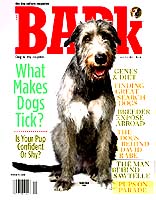
Bark’s new digital edition looks and feels like the
“real” Bark print magazine, but with more bells
and whistles—all the links are live, so a mouse click
takes you directly to a website or launches a video. It provides
instant access to helpful information and resources, and makes
Bark into a multimedia experience. It’s easy to turn
the pages (from bottom right corner), and zooming in and out
is a cinch too!
The digital edition is absolutely free to you — as a
Bark subscriber. Subscribers to the magazine edition will
receive both the print and digital versions.
Click
√
on image
to access thebark.com
|

$40,000
Dog Custody Dispute
September
23, 2009
WOODBURY, NJ - When a couple splits, what happens
to the Pooch?
A New Jersey Judge settled the question Monday. Eric
Dare and DoreenHosemen are to share the Pug Dexter (right).
Judge Ronald tomasello said the arrangement would
last until 6-year-old Dexter "goes to the Great Kennel
in the Sky."
|

Large Dogs in Public Housing Are Now Endangered Species
By MANNY FERNANDEZ
September
23, 2009
Tyson was a tough-looking, head-turning dog — a 60-pound,
year-old Staffordshire bull terrier with a silver-gray coat
and blue eyes. But the only thing tough about him was his
name, his owner said.
Tyson followed commands, never bit anyone and liked to put
his paws on people’s heads to play with their hair.
“He was a big baby,” said his owner, Marc Hernandez,
20, who had had Tyson since he was a puppy of 7 weeks. Yet
one day in May, Mr. Hernandez, a student at John Jay College
of Criminal Justice , took Tyson to an East Harlem animal
shelter, where he reluctantly and tearfully surrendered him.
The problem was not Tyson’s behavior, but his home:
Mr. Hernandez lives in one of New York City’s public
housing projects, where a ban on pit bulls and other large
dogs went into effect May 1.
The ban , one of the strictest for any public housing authority
in the country, prohibits residents from keeping pure-bred
or mixed-breed pit bulls, Rottweilers and Doberman pinschers,
as well as any dog, with the exception of service dogs, expected
to weigh more than 25 pounds when grown. It has divided tenants
and outraged animal welfare groups.
For the New York City Housing Authority , keeping track of
the pets in 178,000 apartments has been a challenge. But the
way the agency announced the policy and the way it has enforced
it has confused and angered many.
Under the 14-page policy, residents who already owned dogs
on the outlawed list could keep them if they were registered
by May 1, but many tenants failed to do so and were forced,
like Mr. Hernandez, to choose between keeping their dogs or
their apartments.
Since April, the owners of at least 113 dogs have given them
up, citing the ban, to shelters and centers run by Animal
Care and Control of New York City , the nonprofit group that
has a contract with the city to take in unwanted animals.
Of the 113 dogs, 49 have been euthanized, because of illness,
behavior or a lack of space. Fifty-nine were adopted by individuals
or taken by rescue groups, two remain in shelters and three
were reclaimed by their owners. The statistics were supplied
by the Mayor’s Alliance for NYC’s Animals , a
coalition of animal rescue groups and shelters that examined
shelter intake records.
The Mayor’s Alliance, which is not affiliated with the
mayor’s office, and the American Society for the Prevention
of Cruelty to Animals have asked the Housing Authority to
stop enforcing the ban. The groups found that many of the
dogs turned in were described as well behaved by shelter workers.
“You can’t predict what a dog is going to be like
just simply based on its breed,” said Jane Hoffman,
president of the Mayor’s Alliance. “I don’t
want a dangerous dog out there. But doing it this way is wrong
and it’s condemning perfectly innocent dogs to death.”
City Councilwoman Rosie Mendez of Manhattan, the chairwoman
of the Council’s Subcommittee on Public Housing, has
also called for a re-examination of the policy. She said one
resident with a 28-pound poodle told her that she planned
not to feed the dog until it was under the 25-pound limit.
A spokesman for the Housing Authority, Howard Marder, said
the new rules were a response to complaints and reports of
dangerous and threatening dogs from tenants, tenant leaders
and the police. The three breeds on the forbidden list had
been identified as “the most frequent problem breed
s,” Mr. Marder said.
There have been several attacks by pit bulls in public housing
buildings in recent years. A 12-year-old girl was mauled by
two pit bulls in Brooklyn in 1997, and there have been more
than 17 dog attacks since 2007 in which people were hurt or
other pets were killed or maimed.
Mr. Marder said that the Housing Authority had discussed the
issue with animal welfare groups, but that he was not aware
of any plans to ease the restrictions. “We made these
changes based on the realities of what we hear from residents
living in public housing, about how difficult their lives
are because of being threatened or attacked by these animals,”
he said.
Victor A. Gonzalez, 60, tenant association president at Rabbi
Stephen Wise Towers on the Upper West Side, said he knew of
about 16 pit bulls there. “The elderly are fearful,”
he said. “They’re afraid to get on the elevators
with these dogs, much less be in the lobby when they get in.”
As of July 31, there were 4,792 dogs registered with the authority.
So far, no one has been evicted for having an unauthorized
dog, but the authority has pursued 41 termination-of-tenancy
cases against residents for violating the pet policy. Nine
cases have been resolved, Mr. Marder said: Some were withdrawn
at the housing manager’s request and one tenant gave
a dog to a friend. The 32 others are pending.
The agency announced the rules by publishing a notice in the
April issue of its monthly newspaper. But that notice listed
27 prohibited breeds, including the Shar-Pei, the cane corso
and the dogo Argentino . Mr. Marder said the agency had tried
to identify breeds that exceed 25 pounds when grown, but realized
that the long list was “impractical” and cut it
to three.
Tenants have received verbal and written warnings about their
dogs from housing managers. An employee instruction guide
on using the agency’s computerized program of pet tracking
is 37 pages long, and maintenance workers who go into apartments
to make repairs make a note of any pets in the household,
Mr. Marder said.
Mr. Hernandez, who lives with his mother at Mariana Bracetti
Plaza in the East Village, took Tyson into the management
office the day before the ban started, but Tyson could not
be registered because he also exceeded the previous weight
limit , infrequently enforced, of 40 pounds. Mr. Hernandez
said he feared that he and his mother would be evicted if
he kept Tyson. “I got scared, so of course I’m
going to do it,” he said. Mr. Hernandez later learned
that Tyson had been adopted. 
Kanielle Hernandez, 23, who lives in the same building as
Mr. Hernandez but is not related to him, refused to give up
Denim (right), her 60-pound blue-nosed pit bull, after he
was refused registration because of his weight. She said she
walked Denim when housing managers were not around, as if
harboring a fugitive. “I’m still cautious,”
she said. “I get scared if I see a manager.”
Photo:
Todd Heisler/The New York Times
|

Tax Break for Pet Care Costs
September
23, 2009
  Introduced
by Rep. Thaddeus McCotter (left), H.R. 3501—known as
the Humanity and Pets Partnered Through the Years (“HAPPY”)
Act—is a federal bill that would reward responsible
pet parents by allowing them to keep more money in their pockets
come tax time. Introduced
by Rep. Thaddeus McCotter (left), H.R. 3501—known as
the Humanity and Pets Partnered Through the Years (“HAPPY”)
Act—is a federal bill that would reward responsible
pet parents by allowing them to keep more money in their pockets
come tax time.
We all want to give our animal companions the best care we
possibly can, but it seems that pet care costs are always
on the rise—and these days, it’s harder than ever
to stretch the family budget. That’s why the ASPCA
supports H.R. 3501, which would amend U.S. tax code to allow
qualifying pet care expenses, including veterinary care, to
be tax-deductible.
This means that when you prepare your income taxes, money
you spent on pet care that year would count as non-taxable
income—and you can deduct up to $3,500 per year!
Help us support the HAPPY Act, H.R. 3501.
What You
Can Do
Visit the ASPCA
Advocacy Center online to send an email to your U.S. representative
and urge him or her to support and cosponsor the HAPPY Act,
H.R. 3501.
|

Tie
to Pets Has Germ Jumping to and Fro
By BRENDA GOODMAN
September
21, 2009
For decades, the drug-resistant germ called MRSA was almost
exclusively a concern of humans, usually 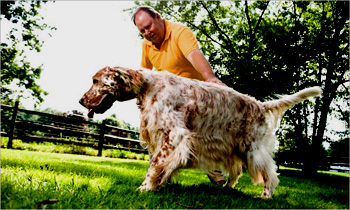  in
hospitals and other health care settings. in
hospitals and other health care settings.
But in recent years, the germ has become a growing problem
for veterinarians, with an increasing number of infections
turning up in birds, cats, dogs, horses, pigs, rabbits and
rodents. And that, infectious-disease experts say, is becoming
a hazard to humans who own or spend time with these animals.
“What’s happened for the first time that we’ve
noticed is that you’re getting flip back and forth,”
said Scott Shaw, head of the infection control committee at
the Cummings School of Veterinary Medicine at Tufts University
.
It is unknown how often pets play a role in human infections
by methicillin-resistant Staphylococcus aureus and vice versa;
physicians and veterinarians do not routinely trace such infections
to their source. When such scientific sleuthing is conducted,
however — usually in the case of multiple or recurring
infections — the results suggest a strong link.
In 2008, for example, an elephant calf and 20 of its caretakers
at the San Diego Zoo contracted MRSA skin infections. An investigation
by the zoo and state health officials determined that the
calf, which was eventually euthanized, had probably been infected
by a keeper who unknowingly carried the bacteria. (The case
was reported in The Morbidity and Mortality Weekly Report.)
Still, experts are not recommending routine testing of pets
and their humans. Instead, they call for the same kinds of
precautions that apply to other pathogens, especially frequent
washing or sanitizing of hands before and after playing with
a pet.
The first cases of MRSA in pets, about five years ago, appeared
to be in therapy dogs and other animals exposed to patients
or health care workers. Those animals are still thought to
be at greatest risk, but the pattern might be changing.
In a study this summer in The American Journal of Infection
Control , Elizabeth A. Scott and her colleagues at the Center
for Hygiene and Health in Home and Community at Simmons College
in Boston swabbed household surfaces like kitchen and bathtub
drains, faucet handles, toilets, high chairs, trash cans and
kitchen sponges at 35 randomly selected addresses to see what
germs they would find.
They found MRSA in nearly half of the homes they sampled.
When they tried to figure out what might make it more likely
to have the bacteria at home, they ruled out many supposed
risk factors, including working out at a gym, having children
who attended day care, having a recent infection or recent
antibiotic use, and even working in a health care facility.
The one variable that overwhelmingly predicted the presence
of the germ was the presence of a cat. Cat owners were eight
times more likely than others to have MRSA at home. “There
are a number of papers coming out now showing that pets pick
up MRSA from us,” Dr. Scott said, “and that they
shed it back into the environment again.”
Dr. Scott’s next study will screen patients scheduled
for elective surgeries. When she finds MRSA, she will also
test their pets to determine how common that transmission
might be.
“This is a burgeoning epidemic,” said Dr. Richard
L. Oehler, an infectious disease specialist at the University
of South Florida College of Medicine in Tampa, who reviewed
case reports of MRSA’s jumping between people and animals.
Dr. Oehler’s paper appeared in July in The Lancet. Dr.
Oehler recounted the case of a diabetic man with recurrent
MRSA skin infections that were eventually traced to his dog,
a Dalmatian who carried the bacteria but was not ill.
“He would sleep with the couple in the bed and lick
them in the face,” said Dr. Farrin A. Manian, chief
of infectious diseases at St. John’s Mercy Medical Center
in St. Louis. Dr. Manian believes the dog was infected by
its owner, but then served as a reservoir for the bacteria,
reinfecting his patient. “Only after we treated all
three members of the family were we able to get rid of the
infections,” Dr. Manian said.
Then there was the case of the 15-year-old girl and her calico
cat; both developed MRSA infections. DNA fingerprinting confirmed
that the bacteria in wounds on the girl’s arm and near
the cat’s tail were the same.
J. Scott Weese, a veterinary internist and microbiologist
at the University of Guelph in Ontario, believes MRSA infections
transmitted between people and animals are relatively rare.
His tests of randomly selected dogs, for example, have shown
that at any given time only 2 to 3 percent carry MRSA on their
fur or skin or in their saliva. And even if a pet becomes
colonized, meaning that the bacteria take up residence and
reproduce, veterinarians say most healthy animals should be
rid of it in a matter of weeks.
For protection, Dr. Oehler recommends hand washing or using
hand gels before and after playing with a pet, not letting
a pet lick people around the face, and not washing pet food
or water bowls in the same sink that food is prepared. People
should also wear gloves when attending to pets that have open
wounds, he said, and should keep any of their own broken skin
bandaged. And Dr. Oehler advised owners to be more attentive
to their pets’ health in general. “In many of
these cases, there was a lack of awareness that the animal
was ill,” he said. “If a pet has a wound, they
need that evaluated.”
Dr. Weese, who estimated that relatively few animals were
infected, nevertheless agreed that attentiveness was in order.
“In the grand scheme of things with MRSA, pets are a
pretty minor thing,” he said. “But when you consider
how many MRSA infections are occurring in North America at
the moment, if they’re a minor component of a major
disease, that’s still something we need to be aware
of.”
And pets may pose a particular hazard because their relationships
with people can be very close.
“If you think about the individuals with whom you have
the closest contact in terms of duration, intensity, intimacy,
in most people, it’s going to be the spouse, then small
children, then pets,” Dr. Weese said. “For some
people, pets are No. 1 on the list.”
Photo:
Alex di Suvero
INFECTION Don Graff of Belle Mead, N.J., with his English
setter, Sunny. The dog contracted MRSA after a spider bite
but was given medication and has improved.
|

 Cindy
Adams Cindy
Adams
September
20, 2009
So
this guy, in the pet food aisle of the supermarket, says: "My
little dog cost me $2800. I paud $1800 for him, and just a few
months after I got him he ate 15 cents. I had to rush him to
the vet and the surgery cost me $1000. Besides that, the vet
kept the 15 cents." |

 Motive
in Yale Slaying May
Never Be Explained Motive
in Yale Slaying May
Never Be Explained
By SERGE F. KOVALESKI
September
18, 2009
The biggest break in the case came from a German shepherd
named Max handled by State Trooper Nick Leary, according to
a law enforcement official.
Max, who is trained in body recognition, was first sent to
search through mounds of garbage that had been sent out for
incineration from the lab. On Sunday he was taken to the basement
of the lab building, where he picked up Ms. Le’s scent.
Alison
Leigh Cowan contributed reporting from Stamford, Conn., and
Javier C. Hernandez from New York City.
Click
√
on image for full artcle
|

A Free Speech Battle Arises From Videos of Fighting
Dogs
By ADAM LIPTAK
September
18, 2009
WASHINGTON — The next great First Amendment battle in
the Supreme Court concerns, of all  things,
dogfight videos. things,
dogfight videos.
The
ones at issue in the case are old and grainy, and they feature
commentary from the defendant, Robert J. Stevens (left), an
author and small-time film producer. Mr. Stevens calls himself
an educator, and his subject is the history and status of
pit bulls.
“For centuries,” Mr. Stevens exclaimed on one
videotape, “the American pit bull terrier has reigned
supreme as the gladiator of the pit!”
Mr. Stevens, 69, had nothing to do with the dogfights themselves.
But he did compile and sell tapes showing them, and that was
enough to earn him a 37-month sentence under a 1999 federal
law that bans trafficking in “depictions of animal cruelty.”
The Supreme Court will hear his case, which has divided animal
rights groups and free-speech advocates, on Oct. 6. The central
issue is whether the court should for the first time in a
generation designate a category of expression as so vile that
it deserves no protection under the First Amendment. The last
time the court did that was in 1982; the subject was child
pornography.
Dogfighting and other forms of cruelty to animals are illegal
in all 50 states. The 1999 law was aimed solely at depictions
of such conduct. A federal appeals court last year struck
down the law on First Amendment grounds and overturned Mr.
Stevens’s conviction.
The law has an odd history. It was enacted in large part to
address what a House report called “a very specific
sexual fetish.” There are people, it seems, who enjoy
watching videos of small animals being crushed. “Much
of the material featured women inflicting the torture with
their bare feet or while wearing high-heeled shoes,”
according to the report. “In some video depictions,
the woman’s voice can be heard talking to the animals
in a kind of dominatrix patter.”
When President Bill Clinton signed the bill, he expressed
reservations prompted by the First Amendment and instructed
the Justice Department to limit prosecutions to “wanton
cruelty to animals designed to appeal to a prurient interest
in sex.” But the Justice Department in the Bush administration
pursued at least three prosecutions for the sale of dogfighting
videos.
There is little dispute that crush videos are profoundly disturbing.
The two dogfighting videos Mr. Stevens was prosecuted for
selling present a harder question.
There was conflicting testimony at Mr. Stevens’s trial
about the nature and social worth of the videos. Defense experts
said the films had educational and historical value, noting
that much of the footage came from Japan, where dogfighting
is legal. A veterinarian who testified for the prosecution
disputed that and said the videos depicted terrible suffering,
including scenes of dogs that were “bitten, ripped and
torn” and “screaming in pain.”
There is certainly biting in the dogfighting videos, but the
fights are not bloody. In their Supreme Court brief, Mr. Stevens’s
lawyers denied that any of the dogs in the videos were “ripped
and torn,” and they counted “at most, 25 seconds
containing yelps” in the more than two hours of footage
on the tapes.
The third video at issue in the case, “Catch Dogs and
Country Living,” shows pit bulls being trained to attack
hogs and then hunting wild boar. The encounters are gory and
brutal. Mr. Stevens participated in the hunting and filmed
parts of the third video, which bears some resemblance to
nature documentaries.
The law applies to audio and video recordings of “conduct
in which a living animal is intentionally maimed, mutilated,
tortured, wounded or killed.” It does not matter whether
the conduct was legal when and where it occurred so long as
it would have been illegal where the recording was sold. That
means it may be a crime for an American to sell a video of
a bullfight that took place in Spain, where bullfighting is
legal. And because all hunting is illegal in Washington, a
literal reading of the statute would make the sale of hunting
videos illegal here. The law contains an exception for materials
with “serious religious, political, scientific, educational,
journalistic, historical or artistic value.” That exception
may well protect journalism, scholarship and animal rights
advocacy about subjects like factory farming, pharmaceutical
testing, circuses and the slaughter of baby seals. But the
determination of whether particular materials have “serious
value” is, in the first instance at least, made by prosecutors.
News organizations, including The New York Times, filed a
brief supporting Mr. Stevens. The 1999 law, the brief said,
“imperils the media’s ability to report on issues
related to animals.”
In a brief supporting the government, the Humane Society of
the United States said that “gruesome depictions of
animal mutilation targeted” by the law “simply
do not merit the dignity of full First Amendment protection.”
When federal agents raided Mr. Stevens’s home in rural
Virginia in 2003, he had no idea, his lawyers and family say,
that he was breaking the law. But there are hints in the videotapes
that Mr. Stevens at least knew that people participating in
dogfighting in the United States were doing something illegal.
“Because I’m not going to show any participants
or spectators, I have to cut a lot of it,” Mr. Stevens,
who has a folksy manner and looks a little like the actor
Bill Murray, said on one of the videos. “I only show
certain action clips I think you’ll enjoy.” Mr.
Stevens did not try to hide the identities of those involved
in the Japanese dogfights or in the video of dogs attacking
hogs.
There is a crucial difference, Mr. Stevens’s lawyers
told the Supreme Court, between illegal conduct and depictions
of that conduct. “While acts of animal cruelty have
long been outlawed,” the brief for Mr. Stevens said,
“there have never been any laws against speech depicting
the killing or wounding of animals from the time of the First
Amendment’s adoption through the intervening two centuries.”
State and local governments occasionally try to ban depictions
of violence against people, notably in videogames. But those
laws are routinely struck down, and the Supreme Court has
never ruled that speech about nonsexual violence is beyond
the protection of the First Amendment.
Mr. Stevens’s sentence was 14 months longer, the brief
noted, than that of Michael Vick, the football star who actually
participated in a dogfighting venture.
Through his lawyers, Mr. Stevens declined to be interviewed.
He has said he never had his own dogs participate in dogfights.
Mr. Stevens’s son, Michael, said his father was guilty
of nothing more than a longtime fascination with the affection,
loyalty and passion of pit bulls. “You couldn’t
treat a dog any better,” the younger Mr. Stevens said,
“than my father treats pit bull dogs.”

|
 Dog
poop for sale
Dog
poop for sale
Fertile minds devise doo-doo compost plan
By WILLIAM KATES
September
18, 2009
Some upstate dog owners think they have a can-doo plan to profitably
compost the billions of pounds of pooch poop produced yearly
in the United States.
If their pilot project in Ithaca is successful, the Tompkins
County Dog Owners Group and Cayuga Compost hope to market usable
compost within the next two or three years.
Finding a use could also lead to a significant reduction in
the amount of waste material sent to landfills, said Leon Kochian,
a spokesman for TC DOG, the not-for-profit volunteer group involved
in funding the project.
"There was a large Dumpster at the park, and it was just
always overflowing with plastic bags of dog poop. The amount
was unbelievable," said Kochian, a Cornell University biology
professor who owns a yellow Labrador retriever. "Ithaca
has a reputation as a green community . . . It made sense to
us to find a way to compost and spare the landfill from all
the plastic bags."
Dog and cat waste contain parasites and pathogens that make
them unsuitable as compost for vegetable gardens and topsoil
and can run off into waterways and diminish water quality, said
Cary Oshins, an assistant program director for the US Composting
Council. Composted pet waste can be used for deep-fill or other
purposes.
There are any number of small-scale backyard pet-waste composters
and converters available on the market, but Oshins said he had
not heard of any place in the country composting pet waste on
such a grand scale.
"It actually makes sense to do it on a larger scale. The
larger the facility, the more control," he said. "Anything
that gets waste out of a landfill is a good thing."
There are 73 million pet dogs in the United States. The average
dog produces about 274 pounds of waste a year, which means total
dog waste in the United States is more than 20 billion pounds.
A handful of dog parks in the country provides on-site composting
receptacles but none has tried moving it off site to a large-scale
composting facility in a commercial venture, according to DogParkUSA.com,
a national dog-park Web site. But large-scale composting has
worked at the Parc Notre Dame de Grace in Montreal, Canada,
where municipal officials have been composting dog waste since
2004 and annually divert about a ton of dog waste and 7,000
plastic bags from landfills.
Kochian estimated Cayuga Compost has been collecting about 1,000
pounds of poop monthly from the nearly five-acre Ithaca Dog
Park. |

Barbra adds dog prize
Richard Johnson
September
18, 2009
Barbra Streisand declared a second winner in her "cute
pet competition" after Page Six revealed it was originally
won by the diva's breeder. Fur flew after the contest (to
win two tickets to Streisand's Sept. 26 Village Vanguard show)
was won by Dina , a dog owned by the star's friend, Mari lyn
Smart.
 After
we asked Streisand's people about a possible fix, Streisand
announced a new winner yesterday -- but refused to strip Dina
of the title. After
we asked Streisand's people about a possible fix, Streisand
announced a new winner yesterday -- but refused to strip Dina
of the title.
Streisand
wrote on her Web site, "We've got an additional winner
in our Sammie Strei sand's Cutest Pet Photo Contest! Dina,
our first stellar and adorable winner, will share her winning
sta tus with Punks ," a Chihuahua. Streisand had claimed
the first choice had been made by record executives, not her.
One
fan wrote, "Thank you to The Post for getting this one
right."
from
Barbra
in pooch-gate
Richard
Johnson
September 17, 2009
Fuming
Barbra Streisand fans claim she rigged a "cute pet competition"
so one of her friends could win priceless tickets to her upcoming
Village Vanguard show. But after Page Six started looking
into the scandal, the contest results were nullified, and
a new winner will be selected.
The contest was won Monday by Dina , a Coton de Tulear owned
by Streisand's friend Marilyn Smart -- the breeder of the
diva's equally fluffy, white dog, Sammie .
Streisand's intimate Sept. 26 show for just 123 fans is the
hottest ticket in town because it's the first time she's performed
in a jazz club since 1961.
Smart boasted on her blog on Tuesday how Dina was "the
proud winner" and how she "was awarded round-trip
airfare for two, hotel accommodations, and two tickets to
attend Barbra Streisand's concert."
The superstar's Web site and Facebook page were soon deluged
with complaints from furious fans desperate for a ticket.
One, Theresa , fumed on Facebook, "It was nothing but
a scam!"
Smart told Page Six yesterday, "I have nothing to say
to you," before slamming down the phone.
"Barbra does know Marilyn Smart," her publicist,
Dick Guttman , said. "Barbra did not participate in the
selection because she has been away on a boat in Europe. She
knows nothing about this. This was an inappropriate selection
and arrangements are being made to rectify the situation.
The tickets will be given to the next runner-up," Guttman
said.
A spokesman from Columbia Records added, "This is a complete
accident which I cannot quite believe happened.
"We had no idea that the winner was Sammy's breeder until
it was pointed out to us by fans. Barbra had absolutely nothing
to do with this." May the best dog win.
|

Dog dies in Bronx home invasion
By JOHN DOYLE
September
18, 2009
A pitbull who ran after its owners during a home invasion in
the Bronx accidentally hanged itself early today after jumping
out a second-story in an effort to escape three armed men, police
said.
Cops said that three men barged into an apartment on Cauldwell
Avenue in the Morrisannia section at 6:50 a.m., scaring the
two men and three pitbulls that were inside the apartment.
Spooked by the invasion, the two men who live inside the apartment
jumped out the window, police said.
One of the dogs, a pitbull that was chained inside the apartment,
ran after its owners, police said. Not knowing it was tied down,
the dog hanged itself and was found dangling by police on the
building's exterior as the two men hit the ground.
The men, who were not immediately identified by police, suffered
cuts and bruises. The three attackers fled without taking anything,
police said |

ASPCA Locates Dog Attacker Through Facebook
September
17, 2009
Last Friday, September 11, ASPCA
Special Agent Paul Lai arrested New Yorker Donnell Walters
for 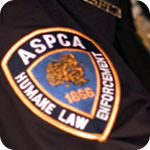 allegedly
beating his boyfriend’s dog, a 41⁄2-pound Yorkshire
Terrier named Lucy. Lucy’s owner alleges that in late
July, a verbal dispute triggered Walters, 22, to assault the
tiny canine. He is accused of repeatedly slamming or dropping
Lucy to the ground, shattering one of her legs. allegedly
beating his boyfriend’s dog, a 41⁄2-pound Yorkshire
Terrier named Lucy. Lucy’s owner alleges that in late
July, a verbal dispute triggered Walters, 22, to assault the
tiny canine. He is accused of repeatedly slamming or dropping
Lucy to the ground, shattering one of her legs.
When ASPCA
Humane Law Enforcement (HLE) began its investigation, Agent
Lai had trouble finding Walters. He cleverly used a variety
of tools, including Facebook, the popular social networking
website, to locate the suspect. Friday’s arrest was
made at Walters’ Manhattan workplace; he has been charged
with one count of aggravated animal cruelty, which carries
a penalty of up to two years in jail.
"Lucy was the innocent victim of a domestic dispute,”
says Stacy Wolf, ASPCA
HLE Vice President & Chief Legal Counsel. “As unfortunate
as these kinds of incidents are, it is good to know that the
criminal justice system is treating them with the seriousness
that these crimes deserve."
After the incident, Lucy’s owner phoned the ASPCA
to report the dog’s injuries. He then brought her to
the ASPCA’s
Bergh Memorial Animal Hospital, where her broken leg was operated
on and repaired using screws and a metal plate. Lucy was returned
to her owner and is recovering well from her ordeal.
If you know of an animal who is being hurt, please report
it—those who intentionally hurt animals may move on
to abuse the people in their lives. To report animal cruelty
in New York City, call the ASPCA’s tip line at (877)
THE-ASPCA.
Visit
the ASPCA's
Report
Cruelty FAQ
to learn how to report cruelty elsewhere.
|
No
Kill in San Francisco: Saving Bay Area Pets
by Sandy Miller
September
16, 2009
San Francisco is close to becoming the first large no-kill
city in the United States. But there is still much work left
to be done to get to that point. Three members of the city’s
Commission of Animal Control and Welfare recently presented
what they call “One Possible Road Map to No Kill in
San Francisco.” Though most agree their plan contains
some good ideas, many say it’s still lacking some key
components.
When the commission began exploring the idea of making the
city by the bay a no-kill community, it sought the advice
of a number of animal welfare organizations, including Best
Friends Animal Society.
Gregory Castle, Best Friends co-founder and interim chief
executive officer, traveled to San Francisco’s  City
Hall this summer to speak to the commission. “It would
be easy for them to become a no-kill community with some commitment,”
Castle says. “They have a very high save rate —
about 85 percent. There are a lot of people who feel that
if they just did a few things right now, they could become
the biggest city in the U.S. to become no-kill.” City
Hall this summer to speak to the commission. “It would
be easy for them to become a no-kill community with some commitment,”
Castle says. “They have a very high save rate —
about 85 percent. There are a lot of people who feel that
if they just did a few things right now, they could become
the biggest city in the U.S. to become no-kill.”
Castle (left) told the commission there are some key things
that must be in place if San Francisco wants to reach the
goal of becoming no-kill community. Agencies and organizations,
including Animal Care and Control, government agencies, the
San Francisco SPCA, veterinarians, rescues, and other no-kill
organizations — must form a coalition and work together
toward the same goal. And one of those organizations must
be willing to step up and take leadership of the group effort,
providing coordination, motivation and direction, Castle says.
He says the coalition must tap all available resources, and
that there is money available from foundations such as Maddie’s
Fund that is currently not being used to save lives in the
San Francisco community. And if San Francisco and other cities
across the nation are ever to reach the goal of No More Homeless
Pets, they must keep those pets from entering shelters in
the first place, Castle says. That means having programs that
help animals with behavioral and medical issues so they can
stay in their homes or find new ones. It also means having
programs that address the most commonly euthanized animals
in shelters — pit bulls and feral cats. “Pit Bulls:
Saving America’s Dog” and “Focus on Felines”
are two of four Best Friends campaigns aimed at reaching the
goal of No More Homeless Pets. Read more about the campaigns
here .
Where to
go from here
After spending months hearing testimony from Castle and other
animal welfare advocates, commission chairwoman Sally Stephens
and commissioners Angela Padilla and Andrea Brooks put together
“One Possible Road Map to No Kill in San Francisco.”
The plan does indeed incorporate some of the advice from Castle
and others, such as creating a coalition. Among other things,
it would offer free or low-cost dog training classes and would
develop a fund to pay for medical and behavioral treatment
of animals at Animal Care and Control. It would create a halfway
house for shelter animals to stay until foster homes could
be found for them. It would provide education and outreach
to help end the horrible blood sport of dogfighting, and it
states that landlords can’t refuse to rent to pit bull
guardians. In addition, it would make trap/neuter/return (TNR)
an official city policy. But many, including Castle, say the
plan doesn’t go nearly far enough. Castle says the policy
should be a mandate and not just a resolution. He says Animal
Care and Control should be mandated to run TNR programs, and
that the city should also mandate programs that address pit
bulls, feral cats and animals who enter shelters sick or in
need of rehabilitation.
FixSanFrancisco.org,
a group made up of local animal welfare advocates and organizations,
agrees.
“We believe that legislation is absolutely necessary
to accomplish no kill in San Francisco,” wrote Kathleen
McGarr in a letter to commissioners on behalf of the group.
“No kill legislation in San Francisco is a tangible
goal within our reach. It is time to ensure that all savable
animals in San Francisco have a secure future.” Stephens
says the road map is by no means a final document. She and
the other commissioners drafted it simply to get the discussion
going. She says she’s not sure whether the final plan
should be a mandate.
“If it is mandated, the city is saying you have to do
this,” Stephens says. “If you don’t have
programs in place to support it, it becomes an empty mandate.
How do you enforce it? If they don’t meet the mandate,
do you fine them? The money spent on fines could be going
to the animals. If there was better coordination between these
groups, no-kill would happen whether there’s a mandate
or not.”
Pit Bulls: Saving America’s Dog
The importance
of working together
Getting all of San Francisco’s local organizations to
work together and coordinate their efforts could prove to
be a challenge. For a long time, the San Francisco SPCA, which
is celebrating its 141st anniversary this year, was considered
the model for how to do things right. The organization worked
closely with animal care and control to help raise the city’s
save rate to the impressive 85 percent it is today. It built
a brand new adoption center and was one of the first organizations
to create cage-free environments. But in the last couple years,
some have criticized the organization for diluting its lifesaving
programs and becoming less committed to no-kill.
One of the biggest criticisms of the SFSPCA is that it brings
easily adoptable animals in from outside the community while
refusing to take in many of the animals from animal care and
control. According to FixSanFrancisco.org, the SFSPCA brought
in more than 1,000 animals from outside the city in 2008 alone.
The SFSPCA is bringing in animals that are easy to adopt while
“choosing to abandon the older black dog who needs his
teeth cleaned,” McGarr says. Only when San Francisco
reaches the goal of saving all of its own animals should it
reach out to take in animals from other communities, the letter
to commissioners said. According to FixSanFrancisco.org, any
road map to no-kill must also:
• Establish that San Francisco shelters’
primary role is to save the lives of animals.
• Fully comply with California’s Hayden Law,
including the section that requires shelters to transfer animals
to rescue groups that are willing to take them.
• Make TNR an official city policy.
• Provide free and/or affordable spay/neuter services
for all of the city’s low-income companion animals.
• Establish uniform criteria for determining if
an animal is saved or killed.
• Prohibit killing animals based on arbitrary criteria
such as breed bans.
• Require shelters to notify people surrendering
animals about the possibility of those animals being killed.
• Refuse to kill savable, surrendered animals even
when requested by the guardian, unless independent assessment
has been made that the animal is irremediably suffering or
hopelessly ill or injured.
• Require shelters to regularly report outcomes
— how many animals are adopted, killed, transferred
to other shelters or taken in by rescue groups — and
conduct regular reporting of the outcomes. And, those statistics
should be reported monthly rather than annually.
• Require both public and private shelters to have
fully functioning adoption programs that include such things
as offsite adoptions, use of the Internet and staying open
seven days a week with some evening hours.
• Require shelters to involve qualified, trained
volunteers in all aspects of animal saving endeavors, including
fostering and socializing animals and assisting with adoptions.
Already having an 85 percent save rate, San Francisco is very
close to becoming the country’s first large no-kill
city. But everyone will need to work together if they’re
going to make the final stretch to the finish line. Castle
says the community as a whole must believe that the goal of
No More Homeless Pets is possible and must be committed to
getting there.
“None of it is very difficult,” Castle says. “They
need to save an extra 600 animals a year.”
Photo
by Molly Wald: Gregory Castle, Best Friends co-founder and
interim chief executive officer
|

Oxygen
for pets
Tribune photo by Chuck Berman
September
15, 2009
Bailey,
an eight-year-old a beagle-Lab mix, has his snout covered
by an oxygen mask in a demonstration in Aurora. The Aurora
Fire Department was given nine sets of oxygen masks designed
for pet with smoke inhalation from fires. The masks were donated
by Invisible Fence of Chicagoland and their use was demonstrated
on a couple of pooches at the Central Fire Station.
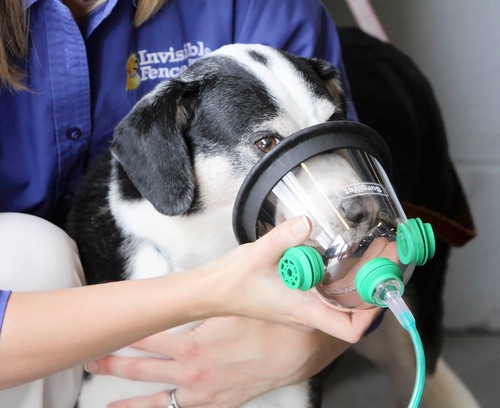
|

Jessica
Simpson's Dog Snatched by Coyote
Jarett Wieselman
September
15, 2009
Jessica
Simpson 's beloved maltipoo Daisy was grabbed by a wild coyote
that then vanished with the small dog, the singer wrote via
Twitter Monday night.
"My heart is broken because a coyote took my precious
Daisy right in front of our eyes. HORROR!".
Simpson, 29, has offered a reward to anyone who can reunite
her with her 5-year-old, caramel-colored dog.
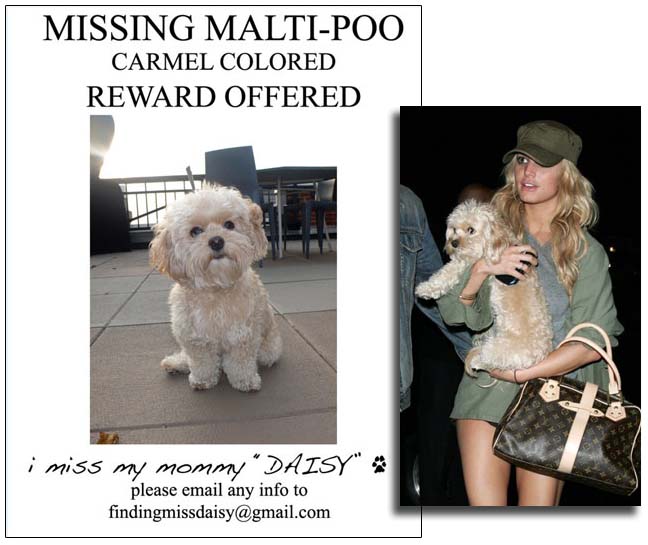
WE
ARE SEARCHING. HOPING. PLEASE HELP.
|
 Cruel
dog-bash in Queens
Cruel
dog-bash in Queens
By PHILIP MESSING
September 12, 2009
A Queens man was busted yesterday for allegedly taking the tiny
Yorkshire terrier he'd given his boyfriend as an engagement
gift and smashing her down until he'd shattered her leg, authorities
said.
After Donnell Walters, 22, and Omar Koonce, 20, argued outside
their Far Rockaway home July 29, Walters grabbed Lucy, 4, "by
the neck and started slamming her against the stairwell three
times and dropped her to the ground," the heartbroken Koonce
told investigators.
The ASPCA said Lucy's leg required pins, plates and a splint
to repair.
Walters was charged with felony animal cruelty and criminal
mischief. |

Most expensive' at $585G
September
11, 2009
A Tibetan mastiff called Yangtze River Number Two is believed
to have broken the world record as the  most
expensive dog, having been sold to a Chinese woman for a reported
$585,000. most
expensive dog, having been sold to a Chinese woman for a reported
$585,000.
In keeping with its status the dog — 18 months old and
80cm high — arrived at its new owner’s home in
stupendous style. According to local reports, a motorcade
of 30 cars cruised to the airport in Xi’an, the capital
of Shaanxi province, to take delivery of Yangtze, and a throng
gathered to fête the arrival of the city’s new
resident.
If the sales figure is accurate it makes Yangtze River Number
Two possibly the most expensive dog ever. This year a family
in Florida paid $155,000 (£90,000) for a Labrador called
Lancelot Encore — a price that included the cost of
cloning him from the original Lancelot.
In the days of Mao Zedong, pet dog ownership was condemned
as a bourgeois folly and banned. Now nearly 150,000 dogs are
registered in Shanghai alone.
The
Tibetan mastiff’s wealthy new owner, a Chinese website
said, fell in love with it while on a visit to Qinghai province.
The woman, referred to only as Mrs Wang, had been travelling
to the town of Yushu with a Tibetan mastiff that she already
owned with a view to mating it with the famously pure-blooded
hounds of that region. While there, though, she spotted a
dog known as White Root and knew immediately that she had
to make it hers.
AFP/Getty
Images: Yangtze River Number Two
|

Wolves
Aren’t Making It Easy for Idaho Hunters
By WILLIAM YARDLEY
September
11, 2009
 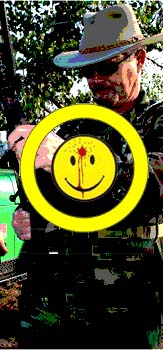 BOISE
NATIONAL FOREST, Idaho — Hunting and killing are not
the same thing. Even as Idaho has sold more than 14,000 wolf-hunting
permits, the first 10 days of the first legal wolf hunt here
in decades have yielded only three reported legal kills. BOISE
NATIONAL FOREST, Idaho — Hunting and killing are not
the same thing. Even as Idaho has sold more than 14,000 wolf-hunting
permits, the first 10 days of the first legal wolf hunt here
in decades have yielded only three reported legal kills.
“It’s clear it’s not going to be easy,”
said Jon Rachael, the wildlife manager for the Idaho Department
of Fish and Game.

Click
√
on images or full article
KILLER:
MARV HAGEDOM
Photos:
Paul Hosefros for The New York Times
Imaging:
Artgrunge
WE'RE
WOOFING FOR THE WOLF
|

ASPCA Rescues 25 Dogs from Queens Hoarder
September
11, 2009
On August 19, the ASPCA,
NYC Animal Care & Control and the Mayor's Alliance for
NYC's 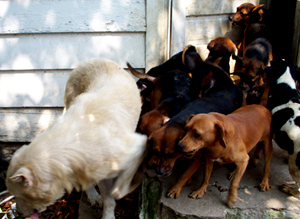 Animals
worked in tandem with local police to rescue 25 dogs from
an animal hoarder in Queens, NY. After a carefully planned
intervention led by the ASPCA,
the hoarder, a man in his mid-50s, voluntarily relinquished
the dogs. Animals
worked in tandem with local police to rescue 25 dogs from
an animal hoarder in Queens, NY. After a carefully planned
intervention led by the ASPCA,
the hoarder, a man in his mid-50s, voluntarily relinquished
the dogs.
While neighbors had long been complaining to each other about
the excessive barking and horrible smells coming from the
house, it took several years for anyone to contact authorities.
Officials were finally tipped off after a neighbor complained
to various city agencies about the constant barking, vile
stench and the ever-increasing number of animals in the residence.
The dogs—mostly Beagles, Miniature Pinschers and mixes
of the two—were living in squalid conditions and suffering
from an array of medical conditions including parasites, fleas,
overgrown nails and mange. Four of the dogs are pregnant.
"Hoarding situations are complex and depending upon a
number of factors, including the mental health status of the
hoarder, they may or may not be referred to the criminal justice
system," says Allison Cardona, ASPCA
Director of Disaster Response. "It is vital that authorities
be notified of hoarding situations so that steps can be taken
to ensure the protection of the animals. This kind of problem
will not go away by itself. It will only get worse. That is
why people need to speak up!"
The ASPCA
also worked closely with Adult Protective Services because,
as in many of these cases, the hoarder himself was in need
of medical attention. "Like many psychological conditions,
there are probably multiple underlying causes for animal-hoarding
behavior. These are not situations that can or should be handled
by animal welfare agencies alone," explains Cardona.
"The ASPCA
will continue to work with Adult Protective Services to monitor
this man's behavior. Without intervention and monitoring,
the relapse rate for hoarders is 100 percent."
The surrendered dogs are recuperating in several shelters,
and ASPCA
animal behaviorists are currently working with seven in particular.
"These dogs have never been socialized, walked on a leash
or run around in a yard," says Cardona. "Their future
pet parents will need to be especially caring, patient people,
willing go the extra mile."
For more information on animal hoarding, visit ASPCA.org.
|

Judge Rules Wolf Hunts in Rockies Can Proceed
By THE ASSOCIATED PRESS
September
10, 2009
BILLINGS, Mont. (AP) — Four months after the government
removed gray wolves from the  endangered
species list, a federal judge has ruled that the first hunts
for them in the contiguous United States in decades can proceed. endangered
species list, a federal judge has ruled that the first hunts
for them in the contiguous United States in decades can proceed.
In a decision issued late Tuesday, the judge, Donald W. Molloy
of the Federal District Court for Montana, denied a request
by environmentalists and animal welfare groups that he stop
the hunts, in Montana and Idaho.
Judge Molloy said plans by the two states to allow hunters
to kill more than 20 percent of the estimated 1,350 wolves
there would not cause long-term harm to the species. He said
the wolf population could sustain a hunting harvest in excess
of 30 percent and still bounce back.
Idaho, which introduced a wolf hunting season on Sept. 1,
has a quota allowing as many as 220 wolves to be killed. Montana,
whose season begins next Tuesday, has a quota of 75.
While Judge Molloy’s ruling denied an injunction that
would have put a halt to this fall’s hunts, it left
unresolved the broader fight, brought by the environmentalists
in their continuing lawsuit, over whether wolves should be
returned to the endangered species list.
The judge did say, however, that the Fish and Wildlife Service
appeared to have violated the Endangered Species Act when
it carved Wyoming out of its decision to lift protections
in May for wolves elsewhere in the Northern Rockies. ‘The
service has distinguished a natural population of wolves based
on a political line, not the best available science,”
he said. “That, by definition, seems arbitrary and capricious.”
That statement suggested that the environmentalists could
ultimately prevail in their effort to restore the wolf’s
protections.
Doug Honnold, a lawyer who argued the case on behalf of groups
opposed to the hunts, offered a mixed reaction to the ruling.
“If they violated the Endangered Species Act, then this
population eventually is going to have to go back on the list,”
Mr. Honnold said. But he also said that he was disappointed
that the injunction request had been denied, and that he “took
no comfort” in Judge Molloy’s statement that the population could withstand a hunt.
the population could withstand a hunt.
A decision on whether to appeal the ruling could be made by
Thursday.
Joshua Winchell, a spokesman for the Fish and Wildlife Service,
said the ruling confirmed the agency’s assessment that
the Northern Rockies’ gray wolves had recovered, at
least in terms of sheer numbers. But Mr. Winchell acknowledged
that the ruling also raised legal issues that were more far-reaching.
“Obviously, we want to make sure we’re doing right
by the law, too,” he said, adding that the agency would
consult with the Justice Department on the issue.
Image:
Two Wolves by Doug Lehnhardt
|

Smallest
dog dies
Petite pooch had short leash on life
By TODD VENEZIA
September
5, 2009
Scooter, we hardly knew ya.
 A
14-ounce Maltese puppy who may have been the smallest dog
in the world died this week after a tragic accident. A
14-ounce Maltese puppy who may have been the smallest dog
in the world died this week after a tragic accident.
The 6-month-old New Zealand pooch became seriously ill after
jumping from the hands of his owners and breaking his leg,
the Kiwi Web site Stuff.co.nz reported.
Although he was placed in a tiny cast, his medication caused
stomach ulcers that proved fatal, the site said.
"He was a big part of my life," his owner, Cheryl
McKnight told the site.
Though the fluffy white pup was too young to qualify for the
official Guinness record for littlest pooch, his owners were
planning to get him certified as soon as he turned 1.
Scooter was only 3 inches tall and 7 inches long. He was so
tiny that McKnight said she had trouble giving him a proper
burial. "There was no box small enough for him,"
she told the site. "I said 'I'm not going to bury him
in that,' so I thought I would put him in the shoe box he
lived in. The poor little fella. "I put him in the box
with flowers and a little dove picture to take him to."
McKnight told the site that she named the dog Pee Wee at first
-- but changed his name to Scooter to avoid an "inferiority
complex."
Scooter was among a number of little young dogs who were considered
to be a contender to take the tiny title from the current
record holder, an American Chihuahua named Heaven Sent Brandy,
according to the Los Angeles Times.
Photo:
Reuters
|

Pit bulls find redemption in new homes
2 years after police broke up a massive dogfighting
ring, rescuers say many of dogs they campaigned to save are
thriving in adoptive homes
By Wendy E. Normandy
September
4, 2009
Guests at Catherine Hedges'
home in Chicago are surprised when Holland gives
them a high-five.

The 2-year-old dog is playful like that, often frolicking
with her other dogs and cats. Hedges describes him as affectionate
and sweet, but because he's a pit bull rescued from a dog-fighting
ring, some people doubt he can be saved. Holland was one of
39 dogs, most of them pit bulls, Hedges and others helped
rescue after a dogfighting ring -- said by Cook County sheriff's
officers to be the largest pit bull ring ever uncovered in
Illinois -- was broken up in South Holland two years ago.
In normal circumstances, many, if not all, of the dogs likely
would have been destroyed, Hedges said. But because of the
rescuers, 31 of the dogs -- including Holland -- now have
permanent homes. Though the future for some of the others
remains uncertain, Hedges said she believes it shows that
dogs rescued from an upbringing of violence -- including pit
bulls -- can be saved.
Many dogs still carry physical and emotional scars and Hedges
admits Holland was "on the borderline" of being
able to assimilate into a normal social environment. He had
a previously broken jaw and leg and needed extensive dental
work.
"When Holland first came to us he was shell-shocked.
He didn't even know what toys were for," she said. "Now
he runs through the household at high speeds, jumping on furniture,
playing with his toys and giving everyone in sight his version
of high-fives. "The South Holland case was -- and still
is -- important because it was one of the first times anyone
gave pit bulls, rescued from a fighting situation, a chance
to live in normal homes," said Hedges, founder of the
rescue group Don't Bully My Breed. "Even PETA did not
think these dogs would be safe to place up for adoption."
The Humane Society of the United States had recommended that
pit bulls taken from fighting rings be put down, reasoning
that they are beyond rehabilitation. The organization has
changed its stance in the last year.
The South Holland raid came just months after a similar one
in Virginia that involved Michael Vick. The star quarterback
pleaded guilty to conspiracy charges, served time in prison
and is working on full reinstatement into the NFL.
More than 50 full- or mixed-breed pit bulls were taken from
Vick's Virginia home and those that survived were sent to
various shelters, including 22 dogs sent to a ranch in Utah
( Best Friends Animal Society) for medical and social rehabilitation.
The court ordered Vick to pay almost $1 million for their
care.
Those dogs, too, have shown rehabilitation to be worthwhile,
Hedges said.
"After all they went through, only one had to be euthanized
and the rest have shown wonderful temperaments, even some
becoming certified therapy dogs," she said, mentioning
Leo, a 2-year-old male pit bull that was certified and spends
a few hours a week visiting chemotherapy patients at cancer
wards near his adopted home.
As for the South Holland dogs, two had to be euthanized because
of severe medical problems. The rest were kept at area shelters
as "evidence" in the case against the homeowner
until November 2007 when a judge relinquished them to the
rescue groups.
Before they could even be considered for adoption, the dogs
had to go through several months of medical treatments and
temperament testing because of what they'd been through.
When police raided a small, makeshift barn behind a home on
July 13, 2007, investigators found dozens of malnourished
dogs kept in small cages without ventilation, covered in their
own feces and urine, in temperatures often exceeding 100 degrees.
They were only taken out of their cages to be trained as fighters.
The female "breed" dogs were often strapped to stands
to keep them from fighting with the males they were forced
to mate with. Others were used as bait dogs, thrown into a
ring with a fighter for "practice." If the bait
dogs lived, they were tossed back into cages with their wounds
untreated to await the next "training session."
The homeowner, Kevin Taylor, then 29, was arrested and charged
with 75 counts of dog fighting and animal cruelty. His case
is pending.
Some of the adopted dogs still show effects of their ordeal,
their handlers said. Rosey shows signs of post-traumatic stress
disorder, which almost all fighting dogs suffer to some degree,
experts said. She's afraid of being left alone, and is fearful
of noises, quick movements and yelling or raised voices, said
Rich Carbon of Melrose Park, who, with his mother, Flora Ann,
adopted Rosey after she spent a year and a half at the Pawsitively
Heaven Pet Resort in Chicago Ridge.
Carbon said he gets disapproving looks from many of his neighbors,
whom he suspects think Rosey should have been destroyed. "I
guess it goes with the breed. It's easier for people to turn
the other way with these dogs," he said. That's why Hedges'
Chicago-based organization specializes in pit bull rescues
and educating the public on the misconceptions about the breed.
"When someone hears the word pit bull, they immediately
think the dog is going to be an aggressive danger to society,"
Carbon said. "It seems as though every single event of
a dog attack represented in the media is immediately assumed
to be a pit bull." Sometimes, he said, it turns out to
be a different breed.
"What people need to know is that these dogs don't want
to be fighting machines," said Judi Schnur of Chicago
Ridge, owner of Pawsitively Heaven Pet Resort. She adopted
one dog from the raid and has two up for adoption, Flora and
Chula.
"They just want to be shown love and compassion, even
after they have lived a life of hell and been brought back
into society, like Chula. She shames every single person who
participates in this gruesome activity," Schnur said.
Rescued
pitbulls find happy hopes
Two years ago 39 pit bulls were saved after a massive dog-fighting
ring was uncovered in south suburban South Holland, the largest
in state history. Since then 31 of the dogs have been permanently
adopted into new homes.
Photos: William DeShazer / Antonio Pérez
/ Chicago Tribune
|

PETITION:
Alaska's Wolves Need YOUR Help
RODGER SCHICKEISEN
President, Defenders of Wildlife
September
3, 2009

In
the past five years, more than 800 wolves have been brutally
slaughtered by Alaska's aerial killing program. Now another
season of aerial gunning is underway. But -- with your help
-- we can
stop this awful practice!
Take action now to help save these wolves -- sign our petition
to urge the Obama Administration to put an end to aerial gunning
in Alaska.
Easy targets against fallen snow, wolves are gunned down from
airplanes or chased to exhaustion, then shot at point blank
range. State-licensed riflemen can target entire packs --
even pregnant
mothers!
It's
not wolf management. It's a wolf massacre.
Please
take action now to save these wolves:
https://secure.defenders.org/site/Advocacy?JServSessionIdr001=ogx4ix15w1.app26a&cmd=display&page=UserAction&id=1517
Defenders of Wildlife has long led the fight to stop this
horrific practice and promote sound management of wolves in
Alaska. And with the anti-wolf Bush/Cheney Administration
now gone from the White House, we have even more hope to end
this awful practice once and for all.
Urge the Obama Administration to enforce the Federal Airborne
Hunting Act, the federal law that could put an end to the
killing.
 Alaska's
politicians continue to promote aerial gunning and other extreme
measures to kill wolves. In fact, in 2008 Governor Sarah Palin
(right) and the state legislature approved spending $400,000
in taxpayer funds to promote the slaughter from the skies
and defeat a citizen's initiative to limit aerial gunning.
To encourage the killing, Governor Palin even proposed a $150
bounty for the left foreleg of each dead wolf and other measures
-- a grisly proposal that Defenders of Wildlife stopped. Alaska's
politicians continue to promote aerial gunning and other extreme
measures to kill wolves. In fact, in 2008 Governor Sarah Palin
(right) and the state legislature approved spending $400,000
in taxpayer funds to promote the slaughter from the skies
and defeat a citizen's initiative to limit aerial gunning.
To encourage the killing, Governor Palin even proposed a $150
bounty for the left foreleg of each dead wolf and other measures
-- a grisly proposal that Defenders of Wildlife stopped.
Now Palin and her allies are once again working to expand
the killing and we need your help to stop them.
Our
wolves are a crucial part of the natural heritage that we'll
leave our children and grandchildren, and we have a real chance
to end this terrible practice.
Please sign our
petition right now and help us end aerial gunning in Alaska:
https://secure.defenders.org/site/Advocacy?JServSessionIdr001=ogx4ix15w1.app26a&cmd=display&page=UserAction&id=1537

“Guns,
hunting. The boring occupations of the
barbarian mind.”
~
JUDITH MERKLE RILEY
American academic and writer of historical
novels
|

U.S. Presidential Master Chef adopts a Best Friends Dog!
How cool is that? And we’re betting the
dog food at his new home is pretty good, too! Plus, his local
doggie park has chutes, slides, ramps, race tracks.
by Ted Brewer
September
3, 2009
There was something about the dog on television that captured
Talli Counsel. “The way he was 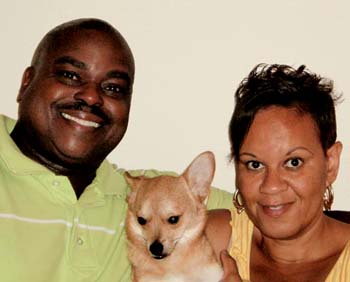 bouncing
around, something just hit me, and I knew,” Counsel
says. bouncing
around, something just hit me, and I knew,” Counsel
says.
Rescued by Best
Friends from a Los Angeles county shelter, the 5-month-old
Chihuahua mix named Popcorn was on the local Fox affiliate’s
“Good Day L.A.” program. He was being featured
as one of the dogs who would be up for adoption the next day
at a Best
Friends mobile event in West Hollywood. Counsel was
so taken by Popcorn that he and his girlfriend Ingrid Ingram
drove 60 miles from their home to meet him.
“I was determined to get him, and I did,” Counsel
says.
Popcorn, renamed Henderson by Counsel and Ingram but still
called “Pop,” is now living a rather privileged
life as the dog of an appointed and commissioned United States
Presidential Master Chef.
For two previous administrations and now the current one,
Counsel has organized special presidential dinner events that
occur outside the White House when the president is traveling.
In addition, he organizes the American Presidents Table, a
series of fundraising events introducing the fine wine and
grand cuisine served at private and state dinners that have
been hosted by presidents both former and current. Counsel
is now in the midst of planning an American Presidents Table
event to benefit the Los Angeles Society for the Prevention
of Cruelty to Animals, to be held late November or early December.
Along with Counsel and Ingram’s other two former shelter
dogs, Harrison and Hamilton (hence Popcorn’s name change),
Henderson is now living a life many humans dream of having:
a life that includes regular lunches at upscale restaurants,
dinners prepared by his master chef guardian, and shopping
in Beverly Hills with Ingram. Yes, Counsel and Ingram take
their guardian role extremely serious, and almost always have
one or more of the dogs with them wherever they go. They both
abide by a schedule which has both of them spending quality
one-on-one time with each of the dogs. They call this one-on-one
time “bonding days.”
“We do this so each pup can have a relationship with
us,” Counsel says.
Henderson is now spending nearly every day at a dog park near
Ingram and Counsel’s home, which might just qualify
as the best dog park in the world. It has chutes, slides,
ramps, ground level water, and a race track around its circumference.
There, Henderson and Harrison have taken to racing each other.
Though still very much a puppy, Henderson is giving the older
and more conditioned Harrison a run for his money.
“We were amazed to see that amount of determination
and drive at such a young age,” Counsel says.
Henderson has proven to be a rather colorful character, and
a voracious eater.
“During dinner on Friday evening, not only did Pop eat
the dinner I prepared for him, he just picked up Hamilton’s
small chicken breast and went to his pillow,” Counsel
says. “Hamilton is the elder of the boys and is very
lovable and gentle, so we carefully watched to see what would
unfold. Hammy walked over to Pop and licked him on his ear
and laid down right beside him until he went to sleep.
“Pop is a blessing and he has had a wonderful effect
on everyone he encounters. This little guy is one of the greatest
dogs I have ever had, and we just love him.”
Photo:
Counsel, Henderson, Ingram
Courtesy of Talli Counsel
|

Any advice for first-time dog owner?
ASK DOG LADY | Tales in 'Pack of Two' will inspire and encourage

BY MONICA COLLINS
September 3, 2009
I read your column every week in the Sun-Times. I'm a dog lover
but have never been a dog owner. I'm thinking of getting a dog.
Can you suggest a Web site or book that could provide information
for new dog owners?
Janis, Chicago
A.
If Dog Lady could read just one book about the joys and trials
of a first-time dog owner, it would be Pack of Two: The Intricate
Bond Between People and Dogs by Caroline Knapp (Delta, $10.88).
Sure, there are many books and sites to advise you how to
buy a leash, a bed, how to train, etc. But only this book
captures the deep dynamic between the person who has never
had a dog before and the dog. After Dog Lady got her puppy
(and was totally miserable, by the way), she would creep into
bed exhausted by the ordeal, pull up the covers, and read
Pack of Two for inspiration.
This book leaps out of the pack because Knapp writes so well
about her relationship with Lucille, the shepherd-mix adopted
from a shelter: "Before you get a dog, you can't quite
imagine what living with one might be like, afterward you
can't imagine living any other way. Life without Lucille?
Unfathomable, to contemplate how quiet and still my home would
be, and how much less laughter there'd be, and how much less
tenderness, and how unanchored I'd be without her presence,
the simple constancy of it."
Knapp is not afraid to admit her mistakes and personal vulnerabilities.
Knapp died of lung cancer at age 42 in 2002. The Boston Globe's
obituary said that Lucille was at her bedside.
Q. My 16-year-old
Scruffy barked at night and kept us awake. Even when we carried
her to our bedroom, she was restless and not comfortable.
Our solution? TV. Her favorite was Nick at Nite.
Margaret, Cicero
A. Your Nick
at Nite solution worked for your dog but may not work for
every woofer, although the sights and sounds of the TV can
definitely help assuage loneliness and restlessness.
Q. I recently
adopted a 2-year-old shepherd/hound mix who is a great dog
and house broken for the most part. Problem: She gets so excited
when people come to visit that she widdles all the way to
the door. Any suggestions?
Hold That Thought, Chicago
A. When you
know company is coming, calmly put her in her crate, or behind
a closed door, and keep her contained. Or command her to sit
and stay (canine basic training). The point? You do not want
your dog all hopped up when company arrives.
Pet
perplexed? Write doglady@askdoglady.com
|

Oregon Wants ‘Dog Friendly’ to Be Less So
By WILLIAM YARDLEY
September
2, 2009
“Look
at her; she’s the calmest dog you’ve ever met,
isn’t she?” Lawrence Sax said of Star, his 8-year- old
Australian shepherd mix (left), as he held her leash at
a Whole Foods Market here. “Everybody I know loves
her.” old
Australian shepherd mix (left), as he held her leash at
a Whole Foods Market here. “Everybody I know loves
her.”
Mr. Sax had apparently overlooked the glare of Stefan Koprinkov.
“I love animals,” Mr. Koprinkov, who had to
step around the dog in his search for cheese pizza, said
later. “But it’s wrong for animals to be in
the store.”
Mr. Koprinkov is not the only person who thinks so. In the
last year, the food safety division of the Oregon Agriculture
Department has received more than 600 complaints about animals
in food stores, and a disproportionate number of them have
come from the Pearl District of Portland, an affluent, dog-passionate
procession of newer condominiums and shiny retail shops
at the edge of downtown. Whole Foods has had complaints;
the Safeway a few blocks away has had even more.
“Usually they’ll hold off and not make a complaint
until they’ve seen a dog urinate in the grocery store
or jump up and try to swipe a pack of meat,” said
Vance Bybee, the head of the food safety division. “Or
they’ve seen dogs pooping in the aisle, that sort
of thing. That sort of puts them over the edge,” Mr.
Bybee said.
In response to the complaints, Oregon is about to begin
an unusual campaign, distributing posters and  pamphlets
to about 4,500 retail stores that sell food. The message
is this: Animals, except those trained to help the disabled,
are not allowed. pamphlets
to about 4,500 retail stores that sell food. The message
is this: Animals, except those trained to help the disabled,
are not allowed.
The campaign, however, is not likely to make the problem
go away, state officials and dog owners say, particularly
in a neighborhood like the Pearl District, where many people
who are not physically disabled consider the company of
their pets therapeutic and insist on taking them just about
everywhere. Some banks put water bowls by their front doors,
and dog day-care facilities take time to serve pets the
specially packed lunches their owners make for them.
“Portland is dog crazy,” said Andrea Schneider,
who lives in the Pearl District and runs pdxdog.com, a social
network for dog lovers. “If you don’t understand
that context, you’re not going to get this.”
Ms. Schneider confessed that she had in the past taken her
golden retriever, Ellie, who is not a service animal, into
places where animals were prohibited, fearing leaving the
dog on the street. She said she took Ellie to Safeway, too,
thinking dogs were allowed. When an employee politely stopped
her, she said that “it was a surprise” but that
she understood.
The federal Food Code, based on language from the Americans
with Disabilities Act, describes service animals as aiding
people with physical disabilities and performing certain
tasks the disabled person cannot, like those provided by
Seeing Eye dogs. The code says, too, that a service animal
is not considered a pet. Yet the disability law also limits
the extent to which a private business can question people
about their disabilities and the service an animal provides,
and there is no requirement under state or federal law that
an animal be licensed or somehow labeled as a service animal.
A new poster created by the state says, “Animals that
provide support or companionship are not regarded as service
animals.” Still, the limits on questions a business
can ask could leave the door open to interpretation and
abuse.
“It’s this weird gray area,” said Caitlin
Lomen, working in the deli at Whole Foods. “Like when
you see little Foo Foo in someone’s purse, you know
that’s not a service animal.”
A co-worker, Carl Anderson, joined the conversation, saying:
“Some people are kind of grossed out by it, but it’s
a comfort thing for a lot of people, to have their dog with
them. Who am I to judge someone else’s needs? Unless
they’re jumping up and eating out of the salad bar,”
Mr. Anderson added, “we try to roll with it the best
we can.”
The Pearl District is a recently erected confection in a
city often regarded as ahead of the curve in so-called New
Urbanist thinking. Streetcars whisper by. Yoga is popular
in Tanner Springs Park, described by a sign at its entrance
as “a habitat garden created on reclaimed industrial
land.” Dogs are not allowed in that park, but some
owners let them run free at a dog park nearby, where the
area’s developer, Hoyt, provides bags for poop and
empties the trash cans that fill up quickly.
“Livability perfected” is printed on the back
of the business card of Tiffany Sweitzer, the president
of Hoyt, which began developing the area in the 1990s. Ms.
Sweitzer said that dogs were initially not a priority for
the project, which is built on old railyards, but that they
had become central to its identity. Her family dog, Scout,
is featured prominently in advertising.
Ms. Sweitzer said she once tried to promote a condominium
building as dog-free. “You couldn’t believe
how many people called me and said, ‘What are you
doing?’ ” she said.
Mr. Sax, with Star at Whole Foods, is not a condominium
owner. He said he was living in a hostel after having moved
up from Los Angeles a few weeks ago. He produced a card
identifying Star as a service animal. The card is sold at
activedogs.com for less than $30; the Web site notes that
it “is not a certifying agency, nor do we hold any
responsibility for information that you have us put on your
ID badge.”
Mr. Sax, 57, said Star helped him because he did not “see
that well,” though he is able to shop for himself.
As far as he is concerned, Mr. Sax said, “I’m
legal.”
Photos:
Leah Nash for The New York Times
Star, an Australian shepherd mix, goes shopping at a Whole
Foods Market in Portland, Ore., with her owner, Lawrence
Sax.
A sign at a Safeway in Portland spells out the rules for
dogs not trained to help the disabled.
|
 Wire
Services Wire
Services
Weird but True
By
LUKAS I. ALPERT
September
3, 2009
In
this battle between Dog and police car, the pooch won.
A pit bull ate all four tires of deputy's cruiser while
the officer was responding to a complaint, said the Cumberland
County, NC, Sheriff's Office. When he returned to his car,
the Dog calmly sat there next to its handiwork. His owner
was billed for new tires.
• •
•
And
in this battle between Dog and Cop, the cop won.
An
Australian Dog owner who left her pooch tied uo outside
a store while she went shopping was stunned to find an officer
had tucked a ticket under the pup's collar for being "parked"
ilegally.
Qarwin's
Rapid Creek Council spokesman said it is illegal to leave
a Dog unattended.
• •
•
September
9, 2009
If
a deaf Dog barks in the forest, does he make a sound?
A
stone deaf puppy in Australia has been taught sign language
to know when to sit, lay down and heel.
"Dogs
understand your body language, your hand gestures. They
read all of that. They know." said trainer Liz Grewal.
To get Pixie's attention, she gently squirts some water
on him.
|

EDITORIAL
Wolf
Season Begins
Published:
September 1, 2009

The
first legal wolf hunt in decades in the continental United
States began at dawn in Idaho on Tuesday. Legal wolf hunting
will begin in Montana on Sept. 15. All told, some 295 wolves
are likely to be killed in these two states in the next two
months. Idaho has set a quota of 220, Montana 75.
These hunts are misguided and, at best, premature. Until April,
wolves in these two states and Wyoming had enjoyed the protection
of the Endangered Species Act. But the Interior Department
decided that the wolf population across the northern Rocky
Mountains had recovered to the point that limited hunts could
be allowed in Idaho and Montana, which in the department’s
view had developed management plans that would ensure the
animal’s long-term survival.
The ironic result is that the gray wolf now enjoys more protection
in Wyoming — a state where it is still listed as endangered,
thanks to an unacceptably weak management plan — than
it does elsewhere in the West.
Environmental groups have made two persuasive counterarguments,
which they will continue to press in court, hopeful for an
injunction to stop the hunts. One is that Idaho’s and
Montana’s plans are also inadequate. The other is that
the wolf population across the northern Rockies has not in
fact reached sustainable levels — it is now just under
1,600 — and that wolves should be left alone until there
are at least 2,000.
After wolves were reintroduced to the Rockies in the mid-1990s
— in central Idaho and Yellowstone National Park —
they did more than just hunt and breed and prosper. The impact
they had on their ecosystem was extraordinary, and beneficial.
You might almost argue that their prosperity was and is an
expression of an ecological hunger for a top predator.
To us, the wolf hunt in Idaho and Montana seems indecent.
Hunters
want to kill wolves because wolves kill elk — and the
human hunters want the elk. A second reason is a love of killing
things. A third is an implacable, and unjustified, hostility
to the wolf. It is well past time to let gray wolves
find their own balance in the Rockies.

Op-Ed
Hunting
Wolves, and Men
Timothy Egan
September
1, 2009
They
started hunting gray wolves in the high reaches of the Rocky
 Mountains
on Tuesday, the first time in years that people have been
allowed to shoot for sport this genetic cousin of man’s
best friend. Mountains
on Tuesday, the first time in years that people have been
allowed to shoot for sport this genetic cousin of man’s
best friend.
For those who hate wolves and long for the era when they were
wiped off the map, and for those who welcomed back this call
of the wild, the last few days have revealed some dark feelings
in the changing West — and some strength of character
as well.
A Republican candidate for governor of Idaho , Rex Rammell
 (right),
was at a political barbecue last week when somebody brought
up the tags used by wolf hunters, and then made a reference
to killing the president of the United States . “Obama
tags?” Rammell replied, to laughter, according
to an account in The Times-News of Twin Falls. “We’d
buy some of those.” (right),
was at a political barbecue last week when somebody brought
up the tags used by wolf hunters, and then made a reference
to killing the president of the United States . “Obama
tags?” Rammell replied, to laughter, according
to an account in The Times-News of Twin Falls. “We’d
buy some of those.”
In the Idaho of the past, jokes about shooting a president
could sometimes be dismissed without consequence. Indeed,
the comment was buried in an initial news story about the
gathering, and Rammell sloughed it off later, saying on his
Web site that “Obama hunting tags was just a joke!
Everyone knows Idaho has no jurisdiction to issue tags in
Washington, D.C.”
Ha-ha. What a knee-slapper, these assassination jokes. And
besides, he couldn’t hunt down Obama with out-of-state
tags. Get it?

This episode was not unlike a town hall meeting last month
in the northern California district of Wally Herger (left),
a Republican congressman. When people show up at an event
that is supposed to be about health care, and get their applause
by proclaiming themselves to be “a proud, right-wing
terrorist,” as one man did in front of an approving
Herger, you know they could care less about defined insurance
benefits.
As with wolves, the fear has many faces, and the true source
of it is seldom clear.
But what followed in Idaho was rare in a year of endangered
civility. The Idaho Republican establishment came down hard
on Rammell, condemning the comments of a fringe candidate
who channels voices that have found a wide airing in the YouTube
age.

Of course, the reaction could be driven by self-interest.
For years, Idaho officials have been trying to convince businesses
that their state is not a hotbed of hate-filled rubes, gun-toting
racists and assorted nut jobs getting their information from
Glenn Beck (right). Tech companies that thrive in the New
West metro area of Boise and the outdoor paradise of the north
say the state’s reputation has severely hurt efforts
to recruit ethnic minorities.
But this is a changed state in a quick-stirring part of the
country — not necessarily less Republican, but certainly
less tolerant of the kind of hate speech that used to flow
with warm beer on late nights at the wacko corral. Obama,
the candidate, drew about 14,000 people in his appearance
in Boise last year — putting it among the largest political
gatherings in state history. He got just under 47 percent
of the vote in Ada County, the state’s most populous.
The wolf hunt has brought out feelings that
have less to do with Canis lupus than with something more
deep-seated. Gray wolves were exterminated long ago in most
Western states, a campaign of blood lust, terror and bounty
kills.
In
some counties it was against the law not to put wolf poison
on the fence post. Their return by federal wildlife officials
has been such a success that two states, Montana and Idaho,
have authorized hunting to keep the numbers in check.
Whether the reintroduced wolf packs — which feast on
elk, deer and occasional domestic livestock — can still
flourish even with the hunt is an issue now before the courts.
But this call to arms against an animal that has been historically
misunderstood by most anyone whose name is not St. Francis
of Assisi is in part a fear of letting the wild back into
Western lands.
Rammell himself is a prime exhibit of a nature-phobe. Until
2007, he made his living in elk ranching, which he calls “a
novel agricultural enterprise.” Imagine this majestic
creature at dawn in a high mountain meadow, in all its glory.
Now imagine it inside a fenced-off plot while someone tries
to domesticate it into stupidity. That’s elk ranching.
As for wolves, Rammell wants them all
dead, dead, dead. “I believe wolves
need to be eliminated,” he says on his Web
site. Does it matter to him that they roamed every Western
state long before Rex Rammell starting tossing one-liners
to red-faced Republicans blowing on their soup at the diner?
Probably not. But judging by the success of tourism built
around wolf sightings, the four-legged hunter is back in the
West to stay. Still, it would help all concerned if what we
talk about when talking about wolves was just that.
"The
human race had yet to render itself extinct; perhaps the animals
were just a dry run.
Once you believed animals were insensate things, disposable,
of utilitarian value only,
it wasn't hard to move on to people."
~
NICHOLAS CHRISTOPHER
American
novelist and poet

Wolves
Are Set to Become Fair Game in the West
By WILLIAM YARDLEY
Dogust
31, 2009
A wolf hunt is set to begin in Idaho
on Tuesday if a federal judge does not stop it. It would be
the first 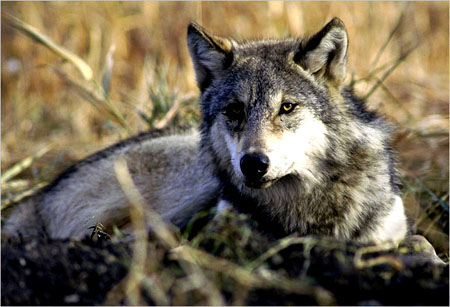 time
in decades that hunters have been allowed to pursue the gray
wolf, an animal that has come to symbolize tensions over how
people interact with wilderness in the West. time
in decades that hunters have been allowed to pursue the gray
wolf, an animal that has come to symbolize tensions over how
people interact with wilderness in the West.
On
Monday, the judge, Donald W. Molloy of Federal District Court,
will hold a hearing to determine whether to issue an injunction
sought by wildlife advocates against the hunt and reopen the
question of returning the wolf to the endangered list.
Gray wolves were taken off the list five months ago, after
being protected under federal law for more than 30 years.
More than 6,000 hunters in Idaho have bought licenses for
the chance to participate in the hunt, in which wildlife officials
will allow 220 wolves to be killed. In 2008, the population
stood at about 850. Montana will allow 75 animals to be killed,
starting Sept. 15.
The states’ hunts will be over when the limit is reached
or when the season ends, which is Dec. 31 in most areas.
“The first day is the best day when it comes to an animal
as smart as a wolf,” said Nate Helm, president of Idaho
Sportsmen for Fish and Wildlife.
The resurgence of the wolf population, rooted in a federal
effort to reintroduce the animals to the Northern Rockies
in the mid-1990s, has long angered deer and elk hunters and
cattle and sheep ranchers who say the wolves are depleting
game and killing livestock. Federal wildlife officials said
that in 2008 a record 264 wolves were killed in the region
for the legal reason of protecting livestock.
The clash illustrates a persistent divide in the West, where
environmentalists and wildlife conservationists have long
gone to court to fight laws they say favor powerful groups
like hunters, ranchers and others. Wolves have been one of
the most tangled issues of late, including in front of Judge
Molloy.
In March, the Obama administration announced it would remove
wolves from the endangered list. The Bush administration made
a similar decision the year before, but Judge Molloy, in a
lawsuit by plaintiffs including Defenders of Wildlife and
the Sierra Club, ordered wolves returned to the list last
fall.
In the years since they were reintroduced to parts of the
Northern Rockies, including Yellowstone National Park, the
wolf population had risen to more than 1,640 in Idaho, Montana
and Wyoming as of 2008. Federal officials say the population
has recovered and no longer needs protection as if it were
endangered.
Idaho and Montana game officials say their hunts will keep
the population from growing and eventually reduce it, while
the limits will make sure enough animals endure to keep them
from becoming endangered. Idaho game officials say they would
like to have a little more than 500 wolves in the state, though
the official plan calls for at least 150.
Wildlife advocates cite several reasons for wanting to stop
the hunt. They say that the state plans do not have enough
protections, that hunting will prevent the wolves from roaming
the Northern Rockies freely enough to preserve genetic diversity
and maintain access to the proper habitat.
Part of the claim is rooted in the federal government’s
continuing effort to protect wolves in Wyoming because it
has not come to terms with that state on a management plan.
“It’s a matter of whether we’re going to
have a healthy recovered population or isolated animals that
are always struggling to survive,” said Suzanne Stone,
the Northern Rockies representative for Defenders of Wildlife,
one of the parties seeking the injunction.
Doug Honnold, the lead lawyer for the environmentalists in
the case, said, “Our vision of recovery is 2,000 to
5,000 wolves in a connected population and with a legal safety
net to keep them there.”
State and federal wildlife officials overseeing the wolf population
say the number of wolves is more than enough and that multiple
studies, including those on genetic diversity, have established
that the animals are roaming widely and intermingling with
others elsewhere.
“Clearly, wolves are restored in the Rocky Mountains,”
said Ed Bangs, the wolf recovery coordinator for the United
States Fish and Wildlife Service in Helena, Mont. “They’re
always going to be here, and nobody is talking about getting
rid of all the wolves. That’s never going to happen.
The population is doing great. There are not genetic problems.
There are not connectivity problems.”
Mr. Bangs added, “But they’re starting to cause
a lot of problems, and the question is what’s the best
tool for the future management of wolves.” He said the
wolves had caused about $1 million in livestock losses and
other damage.
Photo:
United States Fish and Wildlife Service, via Associated Press
FOLLOW-UP

With No Order From Judge, Wolf Season Is Set to Begin
By WILLIAM YARDLEY
Dogust
31, 2009
BOISE, Idaho — The first legal wolf hunt in decades
in the continental United States appeared likely to begin
in Idaho on Tuesday after a federal judge did not immediately
rule Monday on an effort by environmentalists to stop the
hunt and return the animal to the endangered species list.
At
the end of a three-hour hearing on Monday morning, Judge Donald
W. Molloy of Federal District Court in Montana said he would
make a decision “as quickly as I can” but also
said he first needed to review documents filed in the case.
Some leaders of the 13 groups that filed suit had hoped Judge
Molloy would issue an injunction against the hunt from the
bench on Monday.
Now, given the uncertainty of the judge’s time frame,
said Doug Honnold, the lead lawyer for the 13 groups, “the
hunters are going to start tomorrow, and it’s up to
the judge to stop it.” He said it could be several days
before Judge Molloy ruled.
As of 2008, about 1,640 wolves were believed to be in Idaho,
Montana and Wyoming, with the largest population, about 850,
in Idaho. This month, Idaho game officials said hunters could
kill up to 220 wolves beginning Sept. 1. A hunt in Montana
that could kill up to 75 wolves is to begin Sept. 15. Members
of the Nez Perce tribe can also kill up to 35 animals.
Last year, Judge Molloy stopped a wolf hunt in Idaho many
weeks before it was to begin. This year, however, Idaho game
officials announced the details of the hunt only two weeks
in advance, leaving little time for a legal challenge.
“That squeezed the judge and the judicial review process,”
Mr. Honnold said.
In March, the Obama administration affirmed a decision by
the Bush administration to remove gray wolves from the endangered
list, where they had been protected for more than 30 years.
The resurgence of the wolf population, rooted in a federal
effort to reintroduce the animals to the Northern Rockies,
including Yellowstone National Park, beginning in 1995, has
long angered deer and elk hunters and cattle and sheep ranchers
who say the wolves are depleting game and killing livestock.
Killing wolves that have directly harmed livestock has been
legal, and federal wildlife officials said that in 2008 a
record 264 wolves were killed in the region for that reason.
Federal and state wildlife officials say multiple studies
have established that the wolf population is healthy and growing
and that the management programs put in place by Idaho and
Montana will keep the animal from becoming endangered again.
“I’m not worried at all about our ability to perform,”
said Jim Unsworth, the deputy director of the Idaho Department
of Fish and Game.
Times
Topics: Wolves
Click
√
on
image for related stories
"Beware
the beast Man, for he is the Devil's pawn. Alone among god's
primates, he kills for sport or lust or greed. Yea, he will
murder his brother to possess his brother's land. Let him
not breed in great numbers, for he will make a desert of his
home and yours. Shun him; drive him back into his jungle lair,
for he is the harbinger of death."
~ ROD SERLING
&
MICHAEL WILSON
in
THE PLANET OF THE APES

|
 Park
Raving Glad!
Park
Raving Glad!
Dog Owners Refute Run Accusations; Changes to
Come
JULIA SZABO
Dogust
30, 2009
Last week's column addressed the concerns of a group of dog
lovers and the recent renovation of their  neighborhood
dog park on East 63rd Street. They complained that the park's
new sandy gravel surface, "brownstone screening,"
creates dust in dry weather and unhealthy, muddy conditions
when wet. neighborhood
dog park on East 63rd Street. They complained that the park's
new sandy gravel surface, "brownstone screening,"
creates dust in dry weather and unhealthy, muddy conditions
when wet.
To be fair, there are park users who are quite happy with their
pups' new playground. In fact, brownstone screening has been
very well received at the city's first and largest dog run in
Tompkins Square Park, where it was installed last year.
"There are pluses and minuses," says Amy Lam, who
brings her fox terrier Jeeves to the 63rd Street run twice a
day. "It's very dusty, and when Jeeves runs through a puddle,
sometimes his paws get a little irritated, but I just wash them
when we get home and it's fine."
Sandy Paget, who also visits the run daily with her Westie Gillie
and her French bulldog Winnie the Pooh, is equally happy with
the experimental surface: "The dogs are more active,"
she says. Perhaps this is because they're less fearful of wiping
out on a hard surface like hex tile, the park's previous surface.
Robert Marino of NYCdog, a volunteer advocacy group that advises
on dog park design, suggests that a concrete surface like hex
tile puts older dogs at serious risk for orthopedic injury.
Although it's not certain that the dog run surface caused conjunctivitis
in Charlie Berns' Maltese Stella, her vet, Dr. Patrick Cotter,
says, "A dusty environment can irritate a dog's eyes."
Likewise, Andrea Diamond, who herself complained of allergic
symptoms after using the run with her three dogs, was advised
to stop visiting it by her doctor, Dr. Gerald Epstein. "It's
my opinion that the airborne dust particles will exacerbate
her symptoms," says Dr. Epstein.
With regard to bacteria and parasites thriving on the moist
surface, simply emptying the drinking water bowls at night is
not enough.
According to Dr. Andrew J. Kaplan of City Veterinary Care, "Whether
water exists in a bowl or collects as a result of a poorly draining
surface, the stagnation of such water is a perfect breeding
ground for a variety of viruses."
Part of the problem, though, stems from the fact that the surface
was poorly installed to begin with. Fortunately, that's an error
City Council Member Jessica Lappin promises to fix. In a newsletter
dated Aug. 3, Lappin wrote: "The Department of Parks and
Recreation has come to the conclusion that the difficulties
experienced at the large dog run are caused not by the surface
material itself but by the manner in which the various layers
of the surface were compacted when the surface was installed."
As a result, William Castro, Manhattan Borough Commissioner
of Parks, says they plan to re-install the surface to ensure
proper drainage.
"We're also putting in decking so that [those in wheel
chairs] can make the turn radius and bring pets in," he
says. |

150 Puppy Mill Dogs Rescued from Midwest Mills
Dogust
28, 2009
North Shore Animal League America in collaboration with Best
Friends Animal Society
rescued 150 cast off puppy mill dogs from three Midwest states.
The mill owners considered these dogs undesirable and unsellable.
These innocent
victims were destined for an inhumane death or to be sold
at auction for as little
as 25 cents each.
Lemonade is a sweet, adult Beagle with mammary gland tumors
as a result of over
breeding. She can no longer produce litters and therefore
is deemed useless by a
puppy mill breeder.
Pugsly is an adorable Pug that has ulcers in his eyes. Because
Pugsly would not
bring top dollar in a pet store, he has no value to a puppy
mill breeder.
Kisses is a stunning adult Keeshond. There is nothing wrong
with her. But Kisses is
not as in demand as a tea-cup Yorkie, so there was no reason
to keep her in the eyes
of a puppy mill breeder.
To a puppy mill breeder, the space these "defective"
dogs take up is more valuable
than the dogs themselves. The Animal League, however, sees
these magnificent
creatures as beautiful and worthy of a wonderful life that
they have been deprived
of for so long. You as an animal lover surely would agree.
Read
Full Story and Watch the Video at:
http://takeaction.nsalamerica.org/site/R?i=UbfV4uQEEA5lsduoXicMlg
|

Stepdad
allegedly tossed dog to death
Threw sick pet from third-floor porch, prosecutors
say
BY STEFANO ESPOSITO AND RUMMANA HUSSAIN Staff Reporters
Dogust
28, 2009
WICKER PARK | Some of his Wicker Park neighbors call him "mudo,"
Spanish for mute. Alfredo  Tamarit's
words often spill out in a muffled jumble, but there was one
word that the 30-year-old man always pronounced clearly --
the name of his beloved black lab, "Coco." Tamarit's
words often spill out in a muffled jumble, but there was one
word that the 30-year-old man always pronounced clearly --
the name of his beloved black lab, "Coco."
On Thursday, prosecutors told a Cook County judge that Tamarit
was among the witnesses when his stepfather allegedly threw
Coco off the family's third-floor porch Aug. 15. Coco was
found lying on the ground "shaking" just before
he died, Cook County assistant state's attorney Erin Antonietti
said in court at 26th and California.
Judge Ramon Ocasio III ordered the stepfather, Lawrence Juliano
(above), 45, held on $50,000 bail. Juliano, who later bonded
out, is charged with aggravated cruelty to animals and animal
torture, both felonies.
A law enforcement source told the Chicago Sun-Times the dog
was sick and needed to be put down, but the family couldn't
afford a trip to the vet. In court, Juliano's attorney, Barry
D. Sheppard, told Ocasio that euthanasia was a possible defense
in the case.
One of Tamarit's sisters, who did not want her name used,
said Alfredo Tamarit considered Coco "like his child."
The sister, Juliano's stepdaughter, said, "It boils down
to the fact that my stepfather needs some kind of medical
help, and we hope he gets it. "He's been under stress
because he lost his job," said the sister, who added
she didn't see the alleged incident. "Stress affects
people in different ways ... but people don't go throwing
dogs from third-floor balconies."
Depending on which neighbor you talked to Thursday, Juliano
is either a loudmouthed bully or a considerate, caring neighbor.
"I saw when they arrested him, and my heart was broken,"
said neighbor Carmen Beltran, 57. Beltran said Juliano is
a good man who helps neighbors with yard work and lets her
park her car behind his home when she goes away on vacation.
Roland Kaeser, 60, who lives in the same building as Juliano,
says his neighbor has a chronic anger-management problem.
"He's seen me picking up garbage in the backyard ...
and he'll throw a bag full of garbage back down at you,"
Kaeser said.
Others said they would often see Alfredo Tamarit out walking
Coco. Earlier this summer, Coco went missing and Tamarit,
who family members say is so hard of hearing that he couldn't
be interviewed for this story, went door to door sounding
out the word "Coco" to urge people to keep an eye
out for his missing dog.
Contributing:
Rosemary Sobol
Photo: Scott Stewart/Sun-Times
Lawrence Juliano, 45, is accused of fatally throwing Coco,
a black labrador,
off this third-floor porch in the 1300 block of North Wolcott.
|

HAREBRAINED
GREYHOUND BIT STAR'S 'BUNNY' PUG: PALS
By KIRSTEN FLEMING and SABRINA FORD
Dogust 27,
2009
Pals of dogged actor Gerard Butler (right) yesterday insisted
that his precious pug was attacked by a Queens 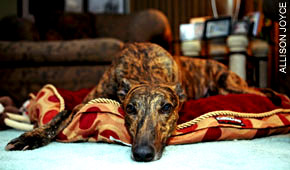  greyhound
(left), and likely for one reason -- the pug looks like a rabbit,
which the former racing dog used to chase at the track. greyhound
(left), and likely for one reason -- the pug looks like a rabbit,
which the former racing dog used to chase at the track.
"[Butler's] dog is pretty much like a fat bunny,"
said Stacey Richman, who accompanied the 39-year-old star and
his beloved pooch, Lolita, to an Upper East Side animal hospital
after Monday's dustup involving the greyhound and its elderly
owners.
"The doctors at the hospital said [such attacks were] common
when [greyhounds] retired because these dogs are trained on
small animals," Richman said.
Even Fred Varecka, who along with his wife, Maria, got into
the dispute with Butler over their greyhound, Mayfly, agreed
the scenario was possible -- to a point. "Maybe Mayfly
thought his dog was a rabbit, but he didn't touch the dog. He
growled, but he never touched the dog," insisted Fred,
67. "I'm going to be honest. The greyhounds need to be
watched in the beginning because their life is either racing
or being put down. That's a true statement. But I had complete
control," Fred said.
The Vareckas called the cops on Butler after alleging that he
flipped out when Mayfly touched noses with Lolita and then slammed
the greyhound's head into a fence during a walk near the set
of Butler's latest flick with Jennifer Aniston in Long Island
City.
Butler's camp claimed that Mayfly viciously attacked Lolita,
biting her twice on the neck.
The actor's rep yesterday said Butler may have brushed the bigger
dog away -- but only to get it off Lolita.
"Gerard was trying to protect his dog and separate the
both of them. He would never intentionally hurt another animal,"
said spokeswoman Joy Fehily.
But Maria bit back. "He's not a nice person," she
said of Butler. "I want people to know he's an ass. I don't
want anything from him. Maybe he could make a donation to Grateful
Greyhounds," the organization that places the fleet-footed
canines after their racing days, said Maria, 61, who works for
the organization with her husband. |

GAL
KOS DEAL IN PUG-LY COP SPAT
By ALEX GINSBERG
Dogust
26, 2009
 The Brooklyn dog owner who allegedly got into a shouting match
with the NYPD's first Hasidic police officer turned down a
plea deal yesterday that would have ended the case with no
jail, fines or punishment.
The Brooklyn dog owner who allegedly got into a shouting match
with the NYPD's first Hasidic police officer turned down a
plea deal yesterday that would have ended the case with no
jail, fines or punishment.
Blogger Chrissie Brodigan told a judicial-hearing officer
yesterday that she wasn't interested in his offer of an adjournment
in contemplation of dismissal -- a promise to dismiss the
whole case as long as she stayed out of trouble for six months.
Her lawyer, Jonathon Warner, would not say why his client
turned down the deal.
Brodigan was cited by Officer Joel Witriol (left) June 28
at a Williamsburg subway station for carrying her pet pug
outside a bag.
|

No
recession for pampered pets
Dogust
25, 2009
Cookie Coco Chanel's owner is feeling the sting of the recession
-- her real estate business has dropped off more than 50 percent.
But for the chocolate-colored Chihuahua, the good life goes
on interrupted -- a twice-monthly oatmeal-aloe vera bath,
doggie cheesecake, a professional blow dry.
Despite
the recession, Americans are expected to spend an estimated
$45.4 billion on their pets.

"We make little sacrifices to keep our animals in a healthy
lifestyle," explained Cookie's owner, Dominica Cece,
48, a North Sider who says she spends about $5,000 annually
caring for her two dogs and three cats.
Cookie is hardly the only pet oblivious to the worst global
downturn since the Great Depression. The A
merican Pet Products Association predicts Americans will spend
about $45.4 billion on their pets this year, up $2.2 billion
over 2008. Petco and Petsmart, which together have about 2,100
stores nationwide, both say business has been good, although
not exceptional, during the recession.
"The fact of the matter is people still love their pets,
and just because the economy changes, that doesn't change,"
said Petco spokeswoman Brooke Simon.
Joel Spainhour owns Tucker Pup's, a West Loop business that
offers dog grooming, boarding, day care and training. Last
October, business was dreadful -- but only temporarily, Spainhour
said. "We just had a huge amount of cancellations for
day care and especially for boarding, because so many people
canceled their business trips and personal trips," Spainhour
said. But people were, in fact, postponing trips, not canceling
them. "Now, [business] is stronger than it's ever been,"
Spainhour said.
Still, it isn't all good news for the family pooch. Some pet
owners, particularly those who have recently lost a job, are
cutting back on pet health care.
"We're seeing a drop in some of the preventative care,
and we're seeing an increase in some of the diseases that
could have been prevented," said Lenette DiCiaula, a
veterinarian at Portage Park Animal Hospital & Dental
Clinic.
When money's tight, DiCiaula said, patients may not be able
to afford "the gold standard." "We try to work
with people and try to address the most important issues,"
she said.
At Famous Fido and Happy Tails in Andersonville, Cookie was
experiencing the platinum standard Monday afternoon. She'd
just enjoyed a beef-carrot-and-peas entree, followed by turkey
meatballs and a slice of doggie cheesecake. But something
was making the tiny dog snarl.
"You've got a few little issues you've got to work out,"
her owner, Cece, cooed.
A few feet away, Benji, a freshly clipped and washed Wheaten
terrier, was sniffing the ground. Benji's owner, Patricia
Rollins, a 67-year-old retired banker who lives on the North
Side, said she couldn't imagine cutting back on her dog's
grooming.
"For one thing, he sleeps with me, so it keeps germs
and the dirt off the bed," Rollins said. "They clean
his ears and his butt -- and I wouldn't even know how to start
to do that."
Photo:
Brian Jackson/Sun-Times
|

DNA REVEALS MUTTS' MAKEUP
By JULIA SZABO
Dogust
23, 2009
What makes Spot run?
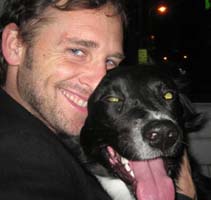
New Yorkers who adopt mixed-breed canines are now using doggie
DNA tests to gain insight into their pooches' ancestry and
personal quirks.
"It's a fun test to run," said Amy Kurowski, a veterinarian
with St. Marks Veterinary Hospital in the East Village. "[You
can] guess what the breeds are and then get the results back
and see if you were right."
The technology for decoding dog DNA was developed in the past
few years, and since then, owners have been clamoring to discover
their mutts' heritage. Vets take a small sample of the dog's
blood or a cheek swab and send it to a lab; a few weeks later,
the results are in. The tests are used most often for dogs
adopted from the pound, although some owners get their purebreds
tested to verify their pedigree.
Josh Lucas (above), the actor, said he learned a lot about
his 2-year-old dog Loki, whom he tested after adopting him
from Animal Care and Control in 2007. The shelter claimed
Loki was a border collie -- but a $125 DNA test showed he
was part German shepherd, part chow chow, part Akita and part
Irish setter.

"He's a quarter of each," said Lucas, who sees subtle
elements of each of the breeds in Loki's appearance and behavior.
"He has the black spotted tongue and crimped ears of
a chow, while his shape is that of an Akita and a shepherd,
and his face looks like a black and white setter."
Health is another reason for canine DNA tests. Some breeds
are prone to specific illnesses, so knowing more about their
pedigree can help owners stay ahead of medical problems.
West Village resident Nathaniel Garber Schoen thinks his 7-year-old
dog Kodos (right), an Animal Care and Control alum, is half
pit bull and half Rottweiler, but he wants her tested since
Rottweilers are prone to heart disease, which can be reduced
through diet.
"But I could be 100 percent wrong!" he said. "She
could conceivably be half beagle and half Doberman pinscher!"
Additional
reporting by Stefanie Cohen
|

Dog flu vaccine protects canines from influenza virus
By Leslie Mann
Dogust
23, 2009
These days 5-year-old Moose divides his time between napping,
walking with his master, Nicole Kirk, and throwing his 107 pounds
into wrestling matches with his favorite squeaky toy. But a
month ago this black Labrador was one sick pup.
Moose came down with canine flu, which has hit several major
metropolitan areas, including his hometown, Princeton, N.J.
Although most dogs recover without hospitalization, Moose's
flu progressed to pneumonia, so he had to spend a week in the
hospital with an IV and antibiotic.
Now a new vaccine from Intervet/Schering-Plough Animal Health
lets dog owners protect their four-legged friends from this
illness. Conditionally licensed in May by the U.S. Department
of Agriculture for dogs age 6 weeks and older, the vaccine includes
two injections, then an annual booster. Full licensure may follow,
pending further studies.
The vaccine was tested on 746 dogs from 30 breeds, age 6 weeks
to 10 years. No side effects resulted, Intervet says.
"It's a 'lifestyle vaccine' for dogs who are in communal
places such as dog parks, day care, shows, boarding kennels,
spas," said veterinarian Cynda Crawford, who identified
the canine influenza virus in 2004 with veterinarian Edward
Dubovi from the College of Veterinary Medicine at Cornell University.
"Dogs who stay at home and just walk around the block are
not at risk."
"Before 2004, it was thought that dogs were not susceptible
to the influenza virus," said Crawford, who is a clinical
assistant professor at the College of Veterinary Medicine at
the University of Florida in Gainesville. "Then we saw
it that year among racing greyhounds."
The virus, known among scientists as H3N8, mutated from an equine
virus, according to the U.S. Centers for Disease Control and
Prevention. Since 2004, thousands of cases have been laboratory-confirmed
in 30 states and in the District of Columbia, Crawford said.
The states that have been hit the hardest are Colorado, Florida,
New Jersey, New York and Pennsylvania.
Moose's veterinarian, Joshua Portner of NorthStar VETS in Clarksburg,
N.J., says his clinic saw 10 to 20 dogs with canine influenza
(numbers are not exact because not all owners opted for laboratory
tests) in May and June. None of his patients succumbed to the
disease. "Most of them had been with many other dogs,"
Portner said. A two-sample blood test, taken while the dog is
sick and again two to three weeks later, confirms the virus.
Despite the outbreak in his area, Portner does not recommend
the vaccine for all his patients. "It's still new, so we
don't yet know about all the side effects, and most dogs recover
from it if they do get it. So I wouldn't necessarily recommend
it for every dog," he said.
The canine virus behaves a lot like human flu viruses, Crawford
said. "The symptoms are similar -- coughing, runny nose,
sneezing. And it spreads the same way, through direct contact,"
she said. Fortunately, she added, the virus is easily inactivated
by washing hands, clothes and items such as dog bowls.
"While sick, the dog should be quarantined," Crawford
said. "You should call your vet, but you have to let it
run its course, just like when you have the flu."
Only 10 to 20 percent of dogs that acquire canine flu progress
to a more serious disease such as pneumonia, according to the
CDC. Only 5 to 8 percent die. Unlike the human flu, canine flu
is not seasonal. Dogs in communal facilities can be vulnerable
year round.
The vaccine contains a "killed," not "live"
virus, so it is a myth that it "causes the flu," Crawford
said. She said the cost of the vaccine is on par with the commonly
used distemper vaccine.
Crawford said there is no evidence that humans or other pets
can catch the canine flu. "But we know that cats can get
influenza viruses from birds, so it is prudent to keep your
cats away from your infected dog," she said, adding that
canine flu is not linked to swine flu.
Animal shelters, especially, get a bad rap during canine flu
outbreaks, said American Veterinary Medical Association spokeswoman
Kimberly May. "The recession has caused the perfect storm
-- more relinquishments of dogs [that may or may not have vaccination
histories] because people can't afford to take care of them,
and outbreaks of the flu," May said.
Bottom line, she said: "The vaccine is a critical step
in getting canine flu under control. It isn't for every dog,
but dog owners should talk to their vets about whether or not
their dogs are at risk." |

SOUL
OF A DOG
WRITER SEARCHES FOR THE ANIMUS IN HIS ANIMALS*
By DOREE SHAFRIR
August
23, 2009
Historically, dogs have been workers: hunting companions,
sled-pullers, sheep herders. It's only in the 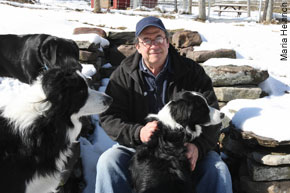 last
century or so that they've become members of the family, and
instead of thinking of them as beasts, we have assigned them
human feelings and characteristics. last
century or so that they've become members of the family, and
instead of thinking of them as beasts, we have assigned them
human feelings and characteristics.
We think we know what they're thinking and what their motivations
are. And perhaps most provocatively, we have started to think
our pets actually have souls. This is the question that consumes
author and farmer Jon Katz in his 18th book, "Soul of
a Dog."
Katz purchased Bedlam Farm in his 50s, and he takes us through
a tour of his farm as seen through the eyes of his many species
of animals, starting and ending with his three dogs -- Rose,
Izzy, and Lenore -- all the while wondering whether the special
characteristics of each beast could possibly mean it has a
soul.
We also meet the 2,000-pound steer Elvis, who was miraculously
saved from the slaughterhouse because his previous owner couldn't
bring himself to kill him. Elvis, Katz writes, seems to have
an innate ability to appeal to humans (though it could just
be his desire for the Snickers bars that Katz brings him every
day).
|
There's also a cat named Mother, who perplexes Katz with her
ability to be loving towards him but murderous towards birds,
mice and other creatures.
Katz is particularly interested in interspecies friendships.
A chicken Henrietta forms a surprising bond with a donkey
named Jeannette; Lenore, his Labrador, charms an ornery sheep
named Brutus. "Each dog responds to what's innate in
them, and also to what I ask of them," Katz writes. "Rose
works for me and Lenore loves me. That's where our souls converge."
When he invites a pastor onto the farm to discuss animal theology,
Katz discovers that his musings over whether animals have
souls don't stand up to religious doctrine.
He wonders whether one of his donkeys, Lulu -- his "most
calm and affectionate donkey" -- can truly be said to
be going to hell. The pastor looks Lulu in the eyes and asks,
"Do you accept Jesus Christ as your Lord and Savior?"
In response, Lulu snorts and rubs her nose against the pastor's
hat, and he is forced to report to Katz that, no, Lulu is
not going to heaven -- but she's probably not going to hell
either, because she doesn't have the ability to accept Christ
as her savior.
In the end, Katz writes of his farm friends: "I have
to admit how much of their behavior and motives is unknowable.
Perhaps that's part of their appeal." He's never able
to determine conclusively whether his animals have souls,
but they do seem to have the capacity to love.
*Soul
of a Dog
Reflections on the Spirit of the Animals on
Bedlam Farm
by Jon Katz
|

The
battle for autistic kids' service dogs
DOWNSTATE | Schools bar them, but judges side with
2 families
BY LINDSEY TANNER
Dogust
23, 2009
Like seeing-eye dogs for the blind, trained dogs are now being
used to help autistic children deal with their disabilities. But
some schools want to keep the animals out, and families are fighting
back.
Two autistic elementary school students recently won court orders
in Illinois allowing their dogs to accompany them to school. Parents
say the animals calm their children, ease transitions and even
keep the kids from running into traffic. At issue is whether the
dogs are true "service dogs" -- essential to managing
a disability -- or simply companions that provide comfort.
School districts say they are not discriminating when they object,
just drawing the line to protect the safety and health of other
students who may be allergic or afraid of dogs.
"The school district has 650 students, not just one. So we
have to balance," said Brandon Wright, attorney for the Villa
Grove district in central Illinois, which objected to 6-year-old
Kaleb Drew taking his Labrador retriever, Chewey, to school.
Kaleb's family won a judge's order in July allowing the dog to
go to class until a trial, set to start Nov. 10. So as Kaleb enters
first grade, Chewey is by his side.
Service dogs have long been used by the blind, but training them
to help those with autism is relatively new. While there's little
research on how these animals affect autistic children, families
like Kaleb's say they have seen marked improvement. The dogs are
trained to be a calming influence, providing a constant between
home, school and other new places.
"It's done so much more than we thought it could," said
Kaleb's mother, Nichelle Drew. "We want Kaleb to be able
to experience more of life," and the dog has helped him do
that, she said.
On Thursday, a judge sided with a family in Columbia, Ill., near
St. Louis, that sued over their school district's unwillingness
to allow an autism service dog in a special education pre-kindergarten
classroom. Five-year-old Carter Kalbfleisch's family credits the
dog with helping stop the boy from running off and keeping him
from eating things like rocks. |

Dogust
21, 2009
Nia Long Would Rather Go Naked Than
Wear Fur
 Actor Nia Long has teamed up with PeTA
to encourage people to be comfortable in their own skin and
to let animals keep theirs by baring it all in a sexy ad.
Nia believes that "all things that have been given life
deserve to live life," and she proves to her fans that
she is committed to the cause by posing naked on the subway
train with a tagline that reads, "I'd rather go naked
than wear fur."
Actor Nia Long has teamed up with PeTA
to encourage people to be comfortable in their own skin and
to let animals keep theirs by baring it all in a sexy ad.
Nia believes that "all things that have been given life
deserve to live life," and she proves to her fans that
she is committed to the cause by posing naked on the subway
train with a tagline that reads, "I'd rather go naked
than wear fur."
Nia joins a long list of gorgeous celebrities who have posed
for PeTA's
iconic anti-fur campaign. She says, "In being a responsible
adult and really understanding what happens for one fur coat
and how many animals are killed and slaughtered for one fur
coat, it just isn't worth it to me."
Animals who are raised and killed for their fur endure tremendous
suffering. Foxes, minks, coyote, and rabbits—and even
cats and dogs—are bludgeoned, electrocuted, and often
skinned alive for their fur.
Nia wants everyone to know about the cruelty behind fur. Check
out what else Nia had to say when we sat down with
her during her photo shoot.
• •
•
PeTA's
Statement on Eagles Vick Signing
PeTA
and millions of decent football fans around the world are
disappointed that the Philadelphia Eagles have chosen to sign
a man who hanged dogs from trees, electrocuted them with jumper
cables, held them underwater until they drowned in his swimming
pool, and even threw his own family dogs into the fighting
pit to be torn to shreds while he laughed. What sort of message
does this send to young fans who care about animals and don't
want to see them be harmed?
PeTA
certainly hopes that Vick has learned his lesson and
feels truly remorseful for his crimes—but since he's
given no public indication that that's the case, only time
will tell. At this point, all Eagles fans can do is cross
their fingers and hope that they won't ever have to explain
to their sons and daughters what a "rape rack" is
and why their favorite player was using one, as Falcons fans
once had to.
|
 Corporate
Partners Corporate
Partners
Dogust
2009
Furry
Fashion Shows Benefit Local Shelters
Posted: Dogust 21, 2009
Rescues
& Runways kicks off on August 26
with a major fashion show and
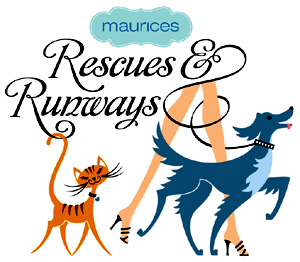 entertainment
at the maurices*
home office in Duluth, MN. entertainment
at the maurices*
home office in Duluth, MN.
Rescues & Runways is an exciting new nationwide effort by
maurices to support local shelters and the animals they help.
During the month of September, more than 700 maurices stores
in 44 states will host pet-themed fashion shows in partnership
with their local animal shelter and sell a special charm to
benefit the American
Society for the Prevention of Cruelty to Animals® (ASPCA®).
Each Rescues & Runways fashion show will feature models
from each community walking the runway with the latest fall
looks from maurices, plus a pet who is available for adoption.
Also throughout
September, people are encouraged to support their local shelters
by bringing the supplies they need to their local maurices store.
Customers who bring in a donation for the shelter will receive
a coupon for 20 percent off one regular-priced item. The campaign
goal is to collect 500,000 pounds of supplies across the nation.
In addition, maurices is introducing a limited edition Friends
for Life Charm, a celebration of the special bond people share
with their furry friends. The Friends for Life Charm is just
$5.00 and will be sold in all maurices stores beginning in mid-September
through October 31. For every charm purchased, $2.50 will go
to support the ASPCA
and its national shelter outreach program. The ASPCA
will receive a
minimum donation of $50,000 from maurices, with an ultimate
goal of raising more than $100,000.
Click
√
on image above for rescuesandrunways.com
*Maurices,
typeset as maurices,
is an American clothing retail chain based in Duluth, Minnesota
. Founded in 1931, the chain comprises more than 500 stores
in 43 states, primarily located in shopping malls and smaller
towns.
 NEWS
NEWS
Only in New York
A One-Woman Show to Help Save Animals’
Lives
Posted: Dogust 21, 2009
Long before TMZ, Entertainment Tonight and Access Hollywood,
there was the nation’s indisputable  Queen
of Celebrity Gossip, Cindy Adams! Queen
of Celebrity Gossip, Cindy Adams!
You’ve heard her dish on celebrities in the New York Post
for almost 30 years. Now is your chance to learn this legendary
columnist’s own unique and almost unbelievable story of
becoming the media’s authority on celebrity news. Only
in New York, Cindy Adams’s bitingly humorous one-woman
performance, offers an inside glimpse into the world of celebrity
news, gossip and scandals she’s written about since 1981.
Four performances will be held in Ms. Adams’s historic
private residence on Park Avenue in New York City, with an intimate
Q&A for guests after each show. (Get ready for celeb tidbits
she’s never revealed before!)
“We are so honored that Cindy is dedicating her upcoming
performances to such an important cause,” says Jo Sullivan,
ASPCA’s
Executive Vice President of External Affairs. “As an ASPCA
Board Member, Cindy has already devoted herself to saving animals’
lives—now this allows people in the Only in New York audience
to do their part.”
“Animal welfare is a cause that is very important to me,”
said Ms. Adams. “I am delighted that I can debut this
exclusive show and help the ASPCA
at the same time.”
Each performance seats only 50 people. All net proceeds will
benefit the ASPCA.
What: A one-woman show by legendary gossip columnist & ASPCA
Board Member Cindy Adams
When: Tuesday, September 29 through Friday, October 2—four
performances only!
Where: Ms. Adams’s historic penthouse apartment on Park
Avenue
What Time: Pre-show penthouse tour begins at 7:00 P.M., show
starts at 7:30 P.M.
Why: To benefit the ASPCA’s
mission to end animal cruelty
How Much: $250 per ticket, includes penthouse tour and Q&A
To
purchase tickets
please contact Rachel Herman in the ASPCA’s
Special Giving Department
at (212) 876-7700, ext. 4564 or via email at onlyinnewyork@aspca.org.
• •
•
Brooklyn
Man Arrested for Neglecting Aging Pet
On August 11, Brooklyn resident Vincent Turzio, 43, was arrested
by ASPCA
Special Agent Kristi Adams for severely neglecting his 12-year-old
German Shepherd, Bella.
Covered in urine and feces, Bella was brought to the Bay Ridge
Animal Hospital, where veterinarians contacted the ASPCA
about the dog’s deplorable condition. Emaciated and too
weak to stand on her own, Bella was also suffering from an open
wound on her hind leg that was the size of a large grapefruit.
The wound was infected, and blood, bone and tissue were fully
exposed.
“By the time we arrived, the vet had already made the
decision to humanely euthanize the suffering dog,” explains
Special Agent Adams. “Bella’s old age, coupled with
the severity of her body condition and open leg wound, left
the vet little choice. She had been in pure agony for some time.”
The vet estimated the dog had been in this terrible state for
over a month.
Turzio was charged with one count of misdemeanor animal cruelty.
He faces up to one year in jail and a $1,000 fine.
• •
•
ASPCA.org
Launches Web Pages in Spanish
We are happy to announce that ASPCA.org/espanol
is up and running! Twenty of our website’s informative
pages have been translated into Spanish, and more are on the
way. Most of the newly translated pages cover our New York City-based
services, like how to adopt a pet at the ASPCA
or where to get your pet spayed or neutered—but many will
interest our national readers, too, including how to recognize
and report animal cruelty.
¡Bienvenidos!
|

BRUTE BASHED 5-LB. DOG TO DEATH: COPS
CHIHUAHUA WAS GAL PAL'S
By PHILIP MESSING and LUKAS I. ALPERT
Dogust
20, 2009
A depraved Staten Island bruiser was busted yesterday for
unleashing a savage beating on his   girlfriend's
defenseless Chihuahua, killing the 5-pound pooch days after
the animal bit him, authorities said. Frank Coppola (left),
28, allegedly took out his rage on the 3-year-old bitch named
Bella (above) on Feb. 28 at the Annadale apartment he shared
with his girlfriend, throttling the poor animal while the
woman was away, investigators said. girlfriend's
defenseless Chihuahua, killing the 5-pound pooch days after
the animal bit him, authorities said. Frank Coppola (left),
28, allegedly took out his rage on the 3-year-old bitch named
Bella (above) on Feb. 28 at the Annadale apartment he shared
with his girlfriend, throttling the poor animal while the
woman was away, investigators said.
It
took investigators nearly six months to get their man, as
girlfriend Melissa DePietro was initially reluctant to testify
against Coppola. "The boyfriend was trying to convince
her that the cops would lock her up," said ASPCA assistant
director Joseph Pentangelo. Prosecutors eventually convinced
her to testify before a grand jury, which, along with graphic
medical evidence, proved enough for an indictment.
A necropsy performed on Bella showed the dog had suffered
severe trauma to its chest, internal bleeding, several broken
ribs, a ruptured jugular vein and bruised lungs, investigators
said.
The day of the heinous assault, Coppola phoned DePietro and
told her he had no clue what had happened. "There's a
problem with the dog. I don't know what happened," Pentangelo
quoted Coppola as saying.
DePietro, 25, raced back home and rushed Bella to the Richmond
Valley Animal Hospital, where the animal -- which had hemorrhaging
in its eyes and blood coming from its mouth -- was declared
dead. When asked by the veterinarian what had happened, Coppola
claimed the dog had run into a wall and collapsed.
Sources said the sweet-natured dog -- the same breed made
famous in a series of Taco Bell ads -- got along with everyone
except Coppola, and had bitten him days before the fatal beating.
"My dog didn't like him," DePietro told the Staten
Island Advance. "A lot of people kept telling me that
he's jealous of the dog."
Coppola, reportedly on probation in an insurance-fraud case,
was charged with animal cruelty, and faces up to four years
in prison. He was released on $2,500 bail.
"This is a very serious crime. It's not every day that
an animal-cruelty charge goes before a grand jury, but obviously
we thought this case was serious enough to take that step,"
said Bill Smith, a spokesman for District Attorney Daniel
Donovan.
Coppola's lawyer, Joseph Sorrentino, said his client "vehemently
denies that he ever hurt the dog."
"Shortly before this dog's death, the dog had gotten
loose and ran out of the house, and was gone for the better
part of the day," he said. "When Mr. Coppola found
the dog, it was exhibiting strange behavior, and they took
it to the vet."
|

2008
Law Leading to Crackdown on Pennsylvania Puppy Mills
By JON HURDLE
Dogust
18, 2009
PHILADELPHIA — At the Almost Heaven kennel, a commercial
dog breeder in Emmaus, Pa., more  than
200 dogs lived in wire-floored cages and suffered from matted
fur, ear infections and mange because of dirty conditions
and a lack of veterinary care, according to state officials. than
200 dogs lived in wire-floored cages and suffered from matted
fur, ear infections and mange because of dirty conditions
and a lack of veterinary care, according to state officials.
After reports from a former employee about inhumane conditions
at the kennel, the owner, Derbe Eckhart, lost his state license.
The kennel continued to operate, however, and in June, state
officials shut it down and moved 218 dogs to temporary shelters.
The action represented the largest closing so far under a
2008 law intended to crack down on what critics say are cruel
conditions in hundreds of commercial kennels that have given
Pennsylvania a reputation as the “puppy mill”
capital of the East.
In July, a kennel in Tioga County was shut down because dogs
were kept in unsanitary conditions. Eighteen dogs were taken
to animal-rescue centers, and the owner was cited for 57 violations
of the law.
Since last December, officials have revoked or refused 11
kennel licenses, and they are in the process of revoking three
more. Before the 2008 law was passed, officials had already
stepped up efforts to regulate the kennels, revoking 41 licenses
in 2007 and in early 2008, compared with only 3 in 2006.
The law increases minimum cage sizes, requires veterinary
care and exercise periods, and bans wire flooring, all changes
that take effect in October. Provisions that allowed the closing
of the Emmaus kennel are already in effect.
Thousands of dogs spend their lives in small wire cages where
confinement and boredom leads some to spin in circles for
long periods, said Jessie L. Smith , the state’s special
deputy secretary for dog law enforcement.
The dogs never exercise, are subjected to extremes of heat
and cold, lack veterinary care and suffer from splayed paws
as a result of having to stand on wire mesh rather than a
solid floor. At some kennels, cages are stacked, causing dogs
in lower cages to be covered in feces and urine from those
above.
When a female dog can no longer breed, it might be given away
or killed, Ms. Smith said. One breeder in Kutztown, Pa., shot
70 dogs rather than provide veterinary care for flea and horsefly
bites identified by state inspectors, she said.
Pennsylvania officials estimate that 84,000 dogs and puppies
are kept in kennels or sold each year, the majority of which
are kept in facilities with 250 or more animals. The state
has 297 licensed commercial kennels that sell or transfer
at least 60 dogs a year.
Stephanie Shain, who heads an anti-puppy-mill campaign for
the Humane Society of the United States , said the new law
gave Pennsylvania one of the strictest dog-breeding laws in
the nation. The commercial kennel industry, represented by
the Professional Dog Breeders Advisory Council, has sued the
State Department of Agriculture over the new law, saying it
violates the interstate commerce clause of the federal Constitution
by charging out-of-state operators higher fees for kennel
licenses than Pennsylvania breeders.
The breeders also accuse the state of breaching the Constitution
by allowing inspectors to enter breeders’ homes without
probable cause and by eliminating due-process rights. “The
law is designed to put them out of business,” said Bob
Yarnall Jr., a board member of the dog breeders’ advisory
council.
Mr. Yarnall said the law imposed the strictest dog-breeding
regulations of any state, and he predicted that 70 percent
of Pennsylvania breeders would immediately shut down if the
law was fully put in place because they would not be able
to afford the costs of compliance. New regulations on kennels’
air quality, for example, would require breeders to install
multiple ventilation units and result in sharply higher electricity
costs, Mr. Yarnall said. A court ruling is expected before
October, he said.
Mr. Yarnall denied accusations of widespread abuses in Pennsylvania
kennels and said any reports of cruelty could be dealt with
by the effective enforcement of existing law.
|

Matchmaking in India: Canine Division
By LYDIA POLGREEN
Dogust 17,
2009
NEW DELHI — Their lonely-hearts faces peer out of the advertisements,
hangdog and looking for love.
“Hi,
I am Musti,” one poster reads. “I am a well-mannered,
good-looking and considerate hunk. I am  very
health conscious and love my carrots. I am a one-woman man and
promise to take good care of you.” very
health conscious and love my carrots. I am a one-woman man and
promise to take good care of you.”
And then there is Foster (left), all jowls and hooded eyes.
“Foster refuses to eat till we find him a girlfriend!”
the poster declares.
In matrimony-mad India, where marriage is the central event
of a lifetime, these posters could easily be for lovelorn, small-town
bachelors, pasted up by anxious parents seeking a bride. But
the suitable girl these single fellows seek is of the furry,
four-footed variety. Finding one, though, is not easy.
“I have been searching for months, but no luck,”
said Kunal Shingla, who is looking for a mate for Foster, his
2-year-old basset hound.
New Delhi’s elite has long treasured purebred dogs, and
as more Indians enter the middle class, having a Pomeranian,
Shih Tzu or Neapolitan mastiff at the end of the leash has become
a symbol of new wealth and status.
Unlike backyard Indian mutts of old, these dogs, like the pampered
pets of affluent Westerners, are part of the family. With young,
middle-class Indians waiting longer to get married and have
children, and with would-be grandparents impatient for grandchildren,
designer dogs have filled a void created by the realities of
modern urban life.
“Families are smaller now, just a husband and wife, and
they have nobody to talk to,” said Partha Chatterjee,
a well-known dog show judge in India. “And then they have
access to all these television programs where they see how dogs
are being treated abroad. They want that kind of symbol of affluence.”
But the pups of India’s surging middle class have a problem.
Everyone, it seems, wants a male dog. This being India, everyone
also wants his or her dog to have a mate. Sterilization is simply
out of the question.
“He is a good dog,” Mr. Shingla, a well-to-do marketing
executive at his family’s manufacturing company, said
of Foster. “I want him to have every happiness in life.”
Three months ago he posted advertisements with Foster’s
tongue-wagging visage at pet shops across Delhi, and on popular
pet message boards, searching for a female basset hound. But
he has had no takers.
Indians’ penchant for male dogs is partly a result of
a societal preference towards all things male, breeders here
say. In parts of India, sons are treasured far more than daughters.
This fact is reflected in the skewed ratio of boys to girls
in some states, evidence of the illegal but still prevalent
practice of aborting female fetuses.
There is also the perception, false for the most part, that
females are more trouble to keep than males as a result of their
menstrual cycles. And in the past, when most people got dogs
to guard their homes, the perception that male dogs were more
aggressive gave them an edge.
Sandeep Chopra, whose company, Classic Kennels, provides dogs
to pet shops across the country, said he personally preferred
female dogs for their easy temperaments. His clients are another
matter.
“When a customer goes and buys a dog, 99 percent go for
a male, and down the road when they need a mate, they face a
problem,” Mr. Chopra said.
He tried his hand at pet matchmaking, linking males and females
of the same breeds, but it was simply impossible to find matches.
Most of the females remain with breeders, he said, who prefer
professional stud dogs. This also helps keep the supply of popular
breeds tight — if people cannot breed dogs in their backyard
they cannot cut into breeders’ profits.
Particular breeds go in and out of fashion. These days pugs
are all the rage. Vodafone, a cellphone company, featured one
of the small smushy-faced dogs in a popular advertising campaign.
The quizzical little pup of the advertisement, with its pointy
ears, wrinkly jowls, and head cocked at a jaunty angle, sent
the price for a pug puppy skyrocketing upward of $400.
Vidushi Sinha, a 23-year-old actress, loved her female dog,
Betsy, the puppy of a neighborhood mutt. But a few years ago
her mother spotted a pug puppy that melted her heart at a pet
shop. “He was just so cute,” Ms. Sinha said. They
named the puppy Julian. He is still adorable, Ms. Sinha said,
but the family quickly learned the disadvantages of potty training
a male.
“Male dogs just lift their leg anywhere,” she said.
And now there is another problem: Julian likes to get amorous
with both furniture and people — closer than many would
like.And so a year ago she put up a poster in an upscale market
in New Delhi. A few calls have trickled in, but so far none
of the matches have worked out.
“I have already got him about two or three girlfriends,
and he is not interested,” she said. “I think he
is already committed. There is no point looking for a girlfriend
because he already has a boyfriend. I hear that a lot of small
dogs are gay.” Julian has become very fond of another
pug down the street named Chotabhai, Hindi for little brother.
“I am fine with it,” Ms. Sinha said, a nonchalant
note of resignation in her voice. “As long as he is happy.”
Photo:
Adam Ferguson/VII Mentor, for The New York Times
"I want him to have every happiness in life," said
Kunal Shingla, who is looking for a mate for Foster, his 2-year-old
basset hound. |

VLADIMIR
POOCHY
By ANDY SOLTIS
Dogust
15, 2009
They make quite a couple! Russian Prime Minister Vladimir
Putin (right in both photos) and President Dmitry Medvedev
are spending some serious quality time together.
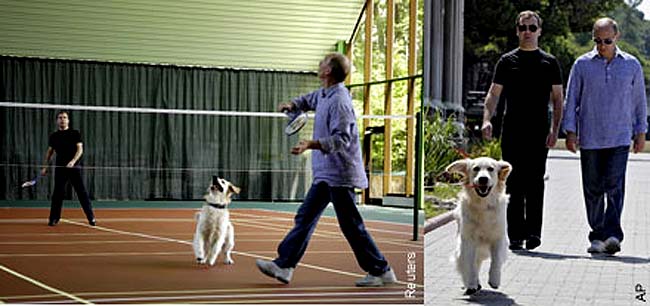
The
pals strolled near the Black Sea beachfront (right) with Medvedev's
golden retriever, Aldo. Later, they pranced around on the
badminton court -- also with the dog.
The shots, taken at the president's official vacation home,
show a different side to the leaders' relationship -- as well
as to Putin, whose vacations are usually macho, bare-chested
affairs.
|
 Wire
Services Wire
Services
Weird but True
By
LUKAS I. ALPERT
Dogust 22,
2009
She's
Britney's bitch now.
A man who dressed his beloved pet Chihuahua in pink was devastated
when a man with a Britney Spears tattoo stole the pooch from
a party at a Fort Lauderdale gay bar.
Brian Dortort said he let the Spears-loving thief hold his pet,
Hudson Hayward Hemingway, for a second, but the man darted off
with the dog. |

In a
Surprise, Vick Signs With the Eagles
By JUDY BATTISTA
Dogust
14, 2009
Michael
Vick , exiled from football for two seasons,
finally has a new team, and it is not one anyone expected.
The Philadelphia Eagles , who have Donovan McNabb as their
starting quarterback, sent a shock wave through the preseason
Thursday night by signing Vick. He will give them a versatile
backup who can run as well as pass, but who could also eventually
compete for McNabb’s job.

 Coach
Andy Reid (left) benched McNabb briefly
last season during a poor performance against the Ravens .
McNabb chafed at the move. But he rallied after that and led
the Eagles to the National Football Conference championship
game, where they lost to the Arizona Cardinals . Coach
Andy Reid (left) benched McNabb briefly
last season during a poor performance against the Ravens .
McNabb chafed at the move. But he rallied after that and led
the Eagles to the National Football Conference championship
game, where they lost to the Arizona Cardinals .
The N.F.C. East may be the N.F.L. ’s most treacherous
division, and the addition of Vick could help the Eagles establish
supremacy over the Giants .
“I’m a believer that as long as people go through
the right process, they deserve a second chance,” Reid
said Thursday night after the Eagles lost to the Patriots
, 27-25, in a preseason game. “You’re talking
about one of the top quarterbacks in the league when he was
playing,” Reid added. “I talked to Michael and
he’s in a good place.”
...Vick, who was reinstated last month after serving 18 months
in federal prison for his role in a dogfighting ring , can
begin practicing immediately, and he could play in the final
two preseason games. But Commissioner Roger Goodell will
decide by the sixth week of the season when Vick can play
in a regular-season game.
“I pretty much lobbied to get him here,” McNabb
said. “I believe in second chances and what better place
to get a second chance than here with this group of guys.”
McNabb added, “We had the opportunity to add another
weapon to our offense."
The Eagles’ decision to sign Vick drew
a quick response from People for
the Ethical Treatment of Animals , the animal-rights
group.
 said in a statement:
said in a statement:
“What
sort of message does this send to young fans who care about
animals and don’t want to see them be
harmed?
PeTA
certainly hopes that Vick has learned his lesson
and feels truly remorseful for his crimes — but since
he’s given no public indication that that’s the
case, only time will tell.”
The
Eagles will most likely use Vick as a backup and perhaps in
a small package of plays that will take advantage of his ability
to keep defenses guessing, perhaps in Wildcat-style formats
where he could run or pass.
...Vick
agreed to a one-year contract, with a one-year option, making
this essentially a tryout and a chance for him to get reacclimated
to the N.F.L.
 Tony
(Dung-heap) Dungy
(left), the former coach of the Colts , has acted
as Vick’s mentor. Dungy has said that he spoke with
several coaches about Vick, but that only a small number of
teams were a good fit, particularly because owners feared
an adverse reaction from fans. Tony
(Dung-heap) Dungy
(left), the former coach of the Colts , has acted
as Vick’s mentor. Dungy has said that he spoke with
several coaches about Vick, but that only a small number of
teams were a good fit, particularly because owners feared
an adverse reaction from fans.
The
Eagles provide Vick with a stable organization to insulate
him during what is sure to be a tumultuous return....The Falcons
once made Vick the highest-paid player in the N.F.L., but
his new contract will pay him $1.6 million in 2009, with
an option for $5.2 million, according to FoxSports.com.
Full
article @ http://www.nytimes.com/2009/08/14/sports/football/14vick.html?ref=sports
 PHILADELPHIA
EAGLES
PHILADELPHIA
EAGLES
Chairman/CEO
Jeffrey Lurie |
|

PHILADELPHIA
EAGLES
General Manager
Tom Heckert |
|
I'LL
HAVE HIS HEAD
Rodin Coane
2007
√
click on image for more of
Rodin Coane's
VICK-TORY MEMORIAL WORKS |
|
To
contact the PHILADELPHIA EAGLES -- http://www.philadelphiaeagles.com/fanzone/contactus.asp
To
contact the NFL -- http://www.nfl.com/contact-us
To
learn about and CONTRIBUTE to the rehabilitation of the
VICK•TORY
DOGS
click √
 here
here
RELATED STORY
•
Justice
Department honors Best Friends Animal Society
|

Tax
Deductions for Pet Owners!
Michele McCaffrey
Fri,
Dogust 14, 2009
During these difficult economic times, more and more people
find that the financial cost of giving pets the care they
deserve becomes a burden, or worse, unbearable.
Urge New York's representatives to support the tax deduction
for pet care expenses >> http://www.care2.com/go/z/e/AFO_W/zJMa/Uci0
The Humanity and Pets Partnered Through the Years (HAPPY)
Act (H.R. 3501) was just introduced to the U.S. House of Representatives
and referred to the House Committee on Ways and Means.
The Act would amend the Internal Revenue Code to allow an
individual to deduct up to $3,500 for "qualified pet
care expenses" - including veterinary care - for a legally
owned, domesticated, live animal.
Even a small tax deduction for responsible pet owners will
go a long way to meet the needs of companion animals, ease
the tax burden of those who own a pet (63 percent of all households)
and may even encourage more people to provide loving homes
to the countless animals filling
America's shelters.
Urge your representatives to co-sponsor the HAPPY Act! >>
< http://www.care2.com/go/z/e/AFO_W/zJMa/Uci0 >
As you, family members or neighbors may be trimming budgets
to make ends meet, innocent animals should not have to go
without adequate care! On behalf of all the companion animals
who do not have a voice.
Take action link: http://www.care2.com/go/z/e/AFO_W/zJMa/Uci0
|
 Wire
Services Wire
Services
Weird but True
By
LUKAS I. ALPERT
Dogust 14,
2009
Moscow has a dog race as well as the rat race.
Scientists discovered that stray dogs in Russia's capital have
mastered the subway system, riding the rails from their homes
in the outskirts of town to the city center, where food is more
plentiful.
"They seem to have learned how long they need to stay on
the train and to leave at the right station," said professor
Andrew Poyarkov. |
 NEWS
NEWS
Dogust
14, 2009
ASPCA
Asks Court to Direct Helmsley Money Back to Dogs
The ASPCA,
along with the Humane Society of the United States (HSUS)
and Maddie’s Fund, filed suit  this
week in New York Surrogate’s Court to intervene in the
matter of the late Leona Helmsley’s $5 billion estate.
The suit seeks to overturn an earlier ruling that allows the
Helmsley Trustees—those responsible for issuing charitable
grants from the estate—to disregard Mrs. Helmsley’s
specific instructions that her wealth be used to help dogs. this
week in New York Surrogate’s Court to intervene in the
matter of the late Leona Helmsley’s $5 billion estate.
The suit seeks to overturn an earlier ruling that allows the
Helmsley Trustees—those responsible for issuing charitable
grants from the estate—to disregard Mrs. Helmsley’s
specific instructions that her wealth be used to help dogs.
“Just a fraction of the money involved in Mrs. Helmsley’s
estate is a game-changer for animal welfare,” says Marsha
Perelman, ASPCA
Board Chair. “The fate of dogs in this country could
very well rest on the decision of this lawsuit—it is
that critical.”
No nonprofit groups involved with animal welfare were contacted
or given an opportunity to register formal objections prior
to the court’s controversial ruling last fall. As a
result of that ruling, and in clear violation of Mrs. Helmsley’s
wishes, less than 0.1% the trust’s initial round of
grants was allocated to dog welfare-related charities.
“Dog fighting, puppy mills, pet homelessness and overpopulation
are not $100,000 problems. But they’re not billion-dollar
problems, either,” says Ed Sayres, President and CEO
of the ASPCA.
“Mrs. Helmsley understood the importance of animal welfare.
She wanted her worldly estate to make our society better for
dogs and animals—and if distributed as she intended,
it definitely has the power to do so.”
This case has larger implications beyond the fate of the Helmsley
estate. The three organizations believe that the court system
has a responsibility to protect the wishes of any decedent,
and also to protect the charity world from the whims of trustees
who wish to ignore estate planning instructions. The misdirection
of the Helmsley fortune should be of interest to everyone
who hopes to provide for beloved pets after death, as well
as to the multitude of organizations, from nonprofits to universities,
that rely on bequests.
The groups involved in the lawsuit are not seeking grants
for themselves, but do hope to work with the Helmsley Trustees
in an advisory capacity to award grants to animal welfare
groups of various size and scope around the country. “There
has been a sea change in recent years in how we treat animals.
It’s a shame that the Helmsley Trustees don’t
understand or respect that change,” says Sayres.
•
• •
Teen
Indicted for Throwing Dog from Roof
On Dogust 10, Brooklyn resident Fabian Henderson (left),
who was arrested last month by ASPCA
Special  Agents
for throwing his one-year-old Pit Bull, Oreo, from the roof
of his housing project, was indicted by the Brooklyn D.A.’s
office. The charges handed down include aggravated cruelty
to animals, which is a felony, the misdemeanor charge of animal
cruelty, as well as criminal trespass in the third degree.
If convicted, he could face more than two years in jail. Henderson,
19, pleaded not guilty to the charges. Agents
for throwing his one-year-old Pit Bull, Oreo, from the roof
of his housing project, was indicted by the Brooklyn D.A.’s
office. The charges handed down include aggravated cruelty
to animals, which is a felony, the misdemeanor charge of animal
cruelty, as well as criminal trespass in the third degree.
If convicted, he could face more than two years in jail. Henderson,
19, pleaded not guilty to the charges.
“On June 18, the ASPCA
received a complaint that an animal was being beaten on the
third floor of 28 W. Ninth St., where Henderson lives with
his family,” says Joseph Pentangelo, Assistant Director
of ASPCA Humane Law Enforcement (HLE). “A few minutes
later, HLE received two more calls from people reporting a
dog had been thrown off the roof.”
Upon their arrival, ASPCA
officers found Oreo on the ground six floors below, badly
broken, but alive. “We couldn’t believe the dog
survived the six-story fall,” says ASPCA
Special Agent Rivas. “We immediately took her to the
nearest animal clinic, where she received emergency care.”
As soon as she was stabilized, Oreo was transferred to the
ASPCA
Bergh Memorial Animal Hospital where veterinarians treated
her shattered legs, bruised lungs and severe internal bleeding.
Surgery was also performed to reconstruct her front legs,
using plates and screws.
“She's showing a lot of resilience. She's eating on
her own, she's standing and she’s walking,” confirms
Pentangelo. “But she has a long road ahead of her before
a decision will be made regarding adoption.”
|
UPDATE
 
Coney Island Freak Show Owner Gets $ --
Not 5-Legged Pup
Thursday,
13 Dogust 2009
CHICAGO -- Thanks to a TV judge, a Coney Island freak
show operator is up $4,000 but down a five-  legged
puppy. legged
puppy.
Judge
Jeanine Pirro (left) ruled during a taping
of her show Wednesday that freak show owner John Strong is
entitled to the cash after the dog's owner backed out of a
contract to sell the Chihuahua-terrier mix to him.
Calvin Owensby agreed to sell the five-legged puppy formerly
known as Precious to Strong on June 29. Strong sent Owensby
$1,000, with a promise to deliver $2,000 more when Precious
got to New York. But Owensby, an unemployed electrician from
Gastonia, N.C., balked days later after researching Strong
online.
"I didn't know it was a freak show,'' a tearful Owensby
told Pirro. "He said it was an amazing animal show.''
After a flurry of media attention, Owensby said he got threatening
phone calls, including one from a New York man who said only
a freak would sell his dog to a freak show.
Strong's show has 27 odd animals, including a two-headed turtle
named Pete and Repeat, a six-legged cow and an eight-legged
pig.
Owensby was so spooked that when Allyson Siegel of Charlotte,
N.C., offered to buy Precious for $4,000 to keep the dog from
going to Strong, he accepted. Siegel took Precious, renamed
her Lilly and quickly had the extra leg removed. Owensby returned
Strong's $1,000.
But Strong still wanted the dog -- or what Owensby was paid
for her -- and sued for breach of contract. Pirro agreed Strong
was wronged. "We've got a contract, and the defendant
broke it, pure and simple,'' Pirro said. She also sided with
Strong in Owensby's countersuit for intentional infliction
of emotional distress, ruling that while the situation was
undoubtedly stressful, Strong couldn't be blamed.
Strong said after the taping that he's thrilled with the decision.
"This is such an emotional case, and it could've gone
either way,'' he said. "I just wish I'd met Calvin before
all this happened.''
Owensby said he doesn't harbor any hard feelings and understands
Strong is just doing his job.
Strong said once Pirro's show airs on Sept. 8, he'll sue Siegel
to reclaim the dog -- despite her lack of an extra paw. "I
certainly am not chasing four-legged dogs around the world,''
he said. "Because of the cuteness of the dog ... I would
still like to have the dog.''
It probably also helps that he said his business has increased
60 percent since the story hit the news.
Lilly, meanwhile, is doing well at her new home. "She
is just a ball of fire,'' Siegel told a North Carolina TV
station. "I hope she is going to have a normal life.''
|

LEONA'S TRUST JOINS DOGFIGHT
By JESSICA SIMEONE and DAREH GREGORIAN
Dogust
12, 2009
The trustees of Leona Helmsley's multibillion-dollar estate
are biting back.

A day after three animal-welfare groups accused them of ignoring
the late hotel queen's last wishes by not spending more of
her money on dogs, the trustees' rep, Howard Rubenstein, accused
the groups of leveling "a broadside attack against the
trustees, against the Surrogate, and against the New York
State Attorney General." The latter two approved the
trust's charitable giving.
The trust's Web site also noted that of $55 million Helmsley,
herself, contributed to charitable causes in her last eight
years "she made only one gift to a dog-related charity,
for one thousand dollars."
Since the real-estate baroness died in 2007, her own dog,
Trouble (left), has been living on a $2 million
trust fund in Florida.
|

Dog hailed as hero for guiding rescuers to owner's body
Reporting by Pauline Askin, Editing by Miral Fahmy
Tue Dogust 11,
2009
SYDNEY (Reuters Life!) – A mongrel has proven that dogs
really are man's best friend when he helped rescuers find the
body of his owner who was killed in a car crash in Australia.
Moja, a small mixed breed, was in the truck with his owner Henry
Drew when it crashed off a highway in Queensland and landed in
dense shrubs.
The animal sat by Drew's body, which was hidden by trees, barking
incessantly for two days until a farmer went to investigate the
cause of the noise.
"If it was not for the man's dog, he may not have been found
for some time because his truck was completely covered by trees
and our helicopter couldn't see it," a spokesperson for AGL
Action Rescue told Reuters.
"This bloke heard the dog barking , it was literally sitting
by the man's side," the spokesperson said.
Drew had been reported missing by his wife after he did not answer
his mobile phone. Rescue helicopters worked with police to search
for the him until the farmer called. |

Dogs as Smart as 2-year-old Kids
Jeanna Bryner, Senior Writer
Dogust 8,
2009
The canine IQ test results are in: Even the average dog has
the mental abilities of a 2-year-old child.
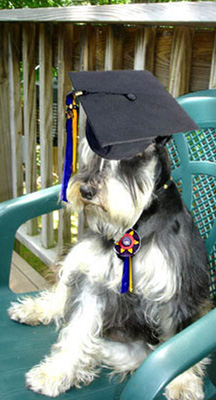 The
finding is based on a language development test , revealing
average dogs can learn 165 words (similar to a 2-year-old
child), including signals and gestures, and dogs in the top
20 percent in intelligence can learn 250 words. The
finding is based on a language development test , revealing
average dogs can learn 165 words (similar to a 2-year-old
child), including signals and gestures, and dogs in the top
20 percent in intelligence can learn 250 words.
AND THE SMARTEST?
Border collies, poodles, and German shepherds, in that order,
says Stanley Coren, a canine expert and professor emeritus
at the University of British Columbia. Those breeds have been
created recently compared with other dog breeds and may be
smarter in part because we've trained and bred them to be
so, Coren said. The dogs at the top of the pack are on par
with a 2.5-year-old.
BETTER AT MATH AND SOCIALIZING
While dogs ranked with the 2-year-olds in language, they would
trump a 3- or 4-year-old in basic arithmetic, Coren found.
In terms of social smarts, our drooling furballs fare even
better.
"The social life of dogs is much more complex, much more
like human teenagers at that stage, interested in who is moving
up in the pack and who is sleeping with who and that sort
of thing," Coren told LiveScience .
Coren, who has written more than a half-dozen books on dogs
and dog behavior, will present an overview of various studies
on dog smarts at the American Psychological Association's
annual meeting in Toronto.
"We all want insight into how our furry companions think,
and we want to understand the silly, quirky and apparently
irrational behaviors [that] Lassie or Rover demonstrate,"
Coren said. "Their stunning flashes of brilliance and
creativity are reminders that they may not be Einsteins but
are sure closer to humans than we thought."
MATH TEST
To get inside the noggin of man's best friend, scientists
are modifying tests for dogs that were originally developed
to measure skills in children.
Here's one: In an arithmetic test, dogs watch as one treat
and then another treat are lowered down behind a screen. When
the screen gets lifted, the dogs, if they get arithmetic (1+1=2),
will expect to see two treats. (For toddlers , other objects
would be used.)
But say the scientist swipes one of the treats, or adds another
so the end result is one, or three treats, respectively. "Now
we're giving him the wrong equation which is 1+1=1, or 1+1=3,"
Coren said. Sure enough, studies show the dogs get it. "The
dog acts surprised and stares at it for a longer period of
time, just like a human kid would," he said.
These studies suggest dogs have a basic understanding of arithmetic,
and they can count to four or five.
BASIC EMOTIONS
Other studies Coren notes have found that dogs show spatial
problem-solving skills. For instance, they can locate valued
items, such as treats, find better routes in the environment,
such as the fastest way to a favorite chair, and figure out
how to operate latches and simple machines.
Like human toddlers, dogs also show some basic emotions, such
as happiness, anger and disgust. But more complex emotions,
such as guilt, are not in a dog's toolbox . (What humans once
thought was guilt was found to be doggy fear, Coren noted.)
And while dogs know whether they're being treated fairly,
they don't grasp the concept of equity. Coren recalls a study
in which dogs get a treat for "giving a paw."
When one dog gets a treat and the other doesn't, the unrewarded
dog stops performing the trick and avoids making eye contact
with the trainer. But if one dog, say, gets rewarded with
a juicy steak while the other snags a measly piece of bread,
on average the dogs don't care about the inequality of the
treats.
TOP DOGS
To find out which dogs had the top school smarts, Coren collected
data from more than 200 dog obedience judges from the United
States and Canada .
He found the top dogs, in order of their doggy IQ are:
Border collies Poodles German shepherds Golden retrievers
Dobermans Shetland sheepdogs Labrador retrievers.
At the bottom of the intelligence barrel, Coren would include
many of the hounds, such as the bassett hound and the Afghan
hound, along with the bulldog, beagle and basenji (a hunting
dog ).
"It's important to note that these breeds which don't
do as well tend to be considerably older breeds," he
said. "They were developed when the task of a hound was
to find something by smell or sight."
These dogs might fare better on tests of so-called instinctive
intelligence, which measure how well dogs do what they are
bred to do.
"The dogs that are the brightest dogs in terms of school
learning ability tend to be the dogs that are much more recently
developed," Coren said. He added that there's a "high
probability that we've been breeding dogs so they're more
responsive to human beings and human signals." So the
most recently bred dogs would be more human-friendly and rank
higher on school smarts.
Many of these smarty-pants are also the most popular pets.
"We like dogs that understand us," Coren said.
We also love the beagle, which made it to the top 10 list
of most popular dog breeds in 2008 by the American Kennel
Club . That's because they are so sweet and socialable, Coren
said. "Sometimes people love the dumb blonde," Coren
said.
And sometimes the dim-wits make better pets. While a smart
dog will figure out everything you want it to know, your super
pet will also learn everything it can get away with, Coren
warns.
Photo
©
Robert Coane: RODIN SCHNAUZER COANE, GRADUATE
|

CIARA'S
PRECIOUS PUPS
Dogust
8, 2009
CIARA will do anything for her dogs.
The
pop starlet was stranded at Newark Airport after Continental
Airlines mixed up her first-class ticket order.
"She
was in town for the 'Do Something' campaign shoot and tried
to board a flight to LAX with her two small puppies,"
said our source. " But Continental gave away the two
seats she purchased for her dogs to other passengers."
Rather
than put her Maltipoo and miniature Schnauzer in cargo, Ciara
waited for the next flight, signing autographs and posing
for pictures with fans in the terminal.
|

America's Best Dance Crew 's Layla Kayleigh Stars in Sexy
PETA Ad
Dogust
7, 2009
 Layla
Kayleigh wants you to stop and think before making your next
purchase at the cosmetics counter. Layla
Kayleigh wants you to stop and think before making your next
purchase at the cosmetics counter.
The sexy co-host of MTV's America's Best Dance Crew feels
so strongly about stopping product tests on animals that she
posed for PETA's first-ever "Animal Testing Breaks Hearts"
ad.
Every
year countless animals are poisoned, blinded, and killed in
cruel and outdated product tests that are not required by
law and often produce inaccurate results. These animals suffer
and die alone, without ever experiencing an ounce of kindness,
so chemicals in things like shampoo, makeup, deodorant, toothpaste,
and household cleaners can be tested. Animal testing breaks
hearts!
The good news is that more than 950 companies have banned
animal tests forever! There is no reason that anyone should
be buying products that blinded bunnies or poisoned mice when
there are plenty of cruelty-free options out there. All you
have to do is read those labels!
Says Layla , "I don't think people are purposely buying
cosmetics and household products that are tested on animals.
I just don't think they think twice. … It really takes
such a small thing to make such big impact, you know, and
I feel like the more people get involved, the more it can
make a difference."
|
 Brooklyn
Woman Assaults Two ASPCA Agents
Brooklyn
Woman Assaults Two ASPCA Agents
Published:
Dogust 7, 2009
On July 23, ASPCA Supervisory Special Investigator Annemarie
Lucas and Special Agent Kristi Adams  arrested
Brooklyn resident Andrea Stewart, age 39, after the 260-pound
woman attacked the two Agents. arrested
Brooklyn resident Andrea Stewart, age 39, after the 260-pound
woman attacked the two Agents.
Responding to an anonymous tip about a neglected cat, the Humane
Law Enforcement agents arrived at Stewart’s residence
to find a seven-week-old, one-pound orange tabby with his whiskers
cut off and a serious injury to his right front paw. “The
kitten’s leg was broken,” says Supervisor Lucas.
“As of now, he might lose his paw and is suffering from
a rib fracture as well.” It was determined that Stewart
had failed to get medical attention for her cat.
Says Joseph Pentangelo, Assistant Director of ASPCA Humane Law
Enforcement, “In response to the agents’ decision
to seize the kitten, Stewart choked and knocked down one of
the ASPCA uniformed officers and punched the other."
Stewart was arrested by ASPCA Special Agent Kristi Adams and
taken to Kings County Hospital for observation. The agents were
treated for injuries at local hospitals, while the kitten, named
Macaroni by officials, was taken to the ASPCA Bergh Memorial
Animal Hospital, where he’s expected to recover and be
readied for adoption.
Since it is a felony to assault a New York State Peace Officer,
Stewart could receive two counts of felony assault and one count
of animal cruelty. |

Handsome Dan Goes Home
Story by David Dickson
Dogust
7, 2009
Handsome Dan, one of the Vicktory
Dogs, has left the building! And he couldn’t
have  landed
in a better home. Heather and Mark from New England run a
kenneling service, doggie day care, animal rescue group, and
more. They specialize in rescuing and placing pit bulls, among
other breeds. landed
in a better home. Heather and Mark from New England run a
kenneling service, doggie day care, animal rescue group, and
more. They specialize in rescuing and placing pit bulls, among
other breeds.
By law, the screening process is super intense for this group
of dogs—way beyond the already detailed adoption process
at Best Friends. For any Vicktory dog, there’s a huge
checklist to go through, including background checks and everything.
Says adoption coordinator Kristi Litrell, "I do have
to admire anyone who goes through all this!"
The funny thing is, Mark and Heather are usually on the other
end of that process. The rescue group they work with has around
80 dogs in a foster network, and they’re the ones who
screen potential homes for the dogs, often pit bulls. These
two know all the questions to ask and where to probe and how.
It should come as no surprise then, that they passed the process
with flying colors. These folks know dogs inside and out.
Once they were cleared to foster, all that remained was to
find the right Vicktory dog.
They came out to Best Friends with a couple names in mind,
but the short list was narrowed down to only one dog as soon
as they met Handsome Dan. They could tell he needed them.
Like many of the Vicktory dogs, Handsome Dan is still not
the most confident in new situations.
All during his time at the sanctuary, Handsome has been working
on getting used to new situations. Even so, he still had his
comfort zone: going on walks or running in his exercise area—and
he was in his element. But a meet and greet over at the Dogtown
staff room? The poor guy wasn’t exactly feeling too
confident when he first met them. Yet Heather and Mark could
see what a sweetheart he was underneath. One sleepover later
and they were in love! They knew they could help him.
Best Friends staffer Ann Allums flew out to personally deliver
Handsome Dan to Mark and Heather (another requirement for
the Vicktory dogs). Everything went smoothly and Handsome
Dan’s new chapter in life began. It should come as no
surprise though, that Handsome Dan was nervous all over again.
After all, if new things haven’t always been his strong
point, try this schedule on for size.
Heather and Mark run doggie day trips all around their area.
Each day, they take a different group of dogs to a different
area. And Handsome Dan has been along every step of the way.
Talk about a whole host of new things to take in! Yet a funny
thing happened. Before long, Handsome Dan started to enjoy
himself. He’s always been great with other dogs, and
that’s what made the difference in the end.
After a few days of moping around, Handsome Dan decided it
was time to play. A little dog who looks like a mix between
a corgi and a golden retriever (try to picture that!) convinced
Handsome Dan to run and romp around. Heather says she cried
when Handsome finally let go of his fears that first time
and had some fun. After all, this is a dog who knows darn
well how to have a good time when he’s feeling like
himself.
Ever since that first time, Handsome has been getting better
and better. He even does a little happy dance when he sees
the leash! Those daily adventures are just what the doctor
ordered for getting him past his jitters. He’s still
cautious around strangers and sometimes tries to hide out
of habit, but Heather and Mark gently and consistently encourage
and help him past those fears. They know he’ll get there.
It’s onward and upward from here on out.
Per the court order, Handsome can’t be considered for
adoption until he has lived with them for six months. Make
no mistake, though, they are in this for the long haul. They
want him to be with them forever. "We just love him,"
Heather says.
So here’s the nutshell version. Handsome Dan is in a
home with a family who loves him unconditionally. He lives
with people who know how to help him. He loves other dogs
and gets to meet new dogs on a daily basis. He goes on adventures
every single day, where he will improve his confidence issues
without even realizing it. Um, is there a downside here? Congrats,
Handsome Dan! You deserve such a happy ending.
Photo
by Molly Wald: Handsome Dan and family
|
 Wire
Services Wire
Services
Weird but True
By
LUKAS I. ALPERT
Dogust 6,
2009
Oh,
the doggone irony!
A woman who tried to break into an animal shelter to free her
beloved pooch has been sentenced to 45 days in jail.
Jessica Johnson, 26, of Casper, Wyo., told the judge she felt
her pit bull had been unfairly deemed a vicious animal, and
feared that it was going to be put down.
She pleaded guilty to destruction of property and criminal entry.
|

Research Undermines Dog Domestication Theory
By NICHOLAS WADE
Dogust
3, 2009
Few people spend their honeymoon catching and drawing blood
from village dogs up and down Africa. But Ryan and Corin Boyko,
two anthropologists at the University of California, Davis,
chose this way to collect valuable genetic data that is casting
a new light on the domestication of dogs.
The opportunity to combine love with science arose when Ryan’s
brother Adam Boyko, a biologist at Cornell University, was discussing
dog genetics with his professor, Carlos Bustamente. Dr. Bustamente,
just back from a visit to Venezuela, remarked on how small the
street dogs there were.
The two researchers wondered if the dogs carried a recently
discovered gene that downsizes dogs from wolves and is found
in all small dog breeds. Dr. Bustamente said the idea could
be explored by collecting street dogs from up and down South
America. Dr. Boyko, knowing his brother was planning a honeymoon
in Africa but lacked the money to go far, proposed that the
survey be done in Africa instead. “I paid for half their
honeymoon,” Dr. Bustamente said.
Ryan and Corin Boyko collected 223 samples of village dog blood
from Egypt, Uganda and Namibia. The small gene question has
not yet been assessed, but their samples, reported in the current
issue of the Proceedings of the National Academy of Sciences,
have called into question a finding on the origin of dog domestication
from wolves.
 The
origin is thought to be East Asia, based on a 2002 survey of
both village dogs and breed dogs. But most of the village dogs
in that survey came from East Asia, which could have tilted
the outcome. The African village dogs turn out to have much
the same amount of genetic diversity as those of East Asia.
This is puzzling because the origin of a species is usually
also the source of greatest genetic diversity. The
origin is thought to be East Asia, based on a 2002 survey of
both village dogs and breed dogs. But most of the village dogs
in that survey came from East Asia, which could have tilted
the outcome. The African village dogs turn out to have much
the same amount of genetic diversity as those of East Asia.
This is puzzling because the origin of a species is usually
also the source of greatest genetic diversity.
The Boykos and Dr. Bustamente do not think dogs were domesticated
in Africa — there are no wolves in Africa now, apart from
the Ethiopian wolf — but they say the origin may not be
East Asia. The issue is better addressed by looking just at
village dogs, they think, and by excluding European breeds,
which are mostly of recent origin.
They are now collecting samples from village dogs throughout
the world — Ryan and Corin Boyko are at present catching
dogs in New Guinea — in hope of tracing not just the place
or places where dogs were first domesticated, but also the travels
that dogs then took around the world with their masters.
The lack of any sharp gradient of genetic diversity between
East Asian and African village dogs could mean that once domesticated,
dogs spread very quickly from their point of origin. Another
explanation, Dr. Boyko said, is that they originated at some
point halfway between the two regions, like in the Caucasus
mountains.
Robert Wayne, a biologist at the University of California, Los
Angeles, said the new report “leaves in disarray”
the thesis that dogs evolved in East Asia. But they could not
have evolved in sub-Saharan Africa, which has no wolves, and
“so must have evolved somewhere else, maybe in the Middle
East,” Dr. Wayne said.
The solution to the origin of the dog will come from sampling
wolves throughout the world as well as village dogs, Dr. Wayne
said. A genome-scanning chip, similar to those developed for
studying the human genome, has been developed for dogs. Dr.
Wayne, working with Dr. Boyko and colleagues, has used the chip
to scan wolf genomes. He said they were now working on a report
that might resolve the current quandary as to where the first
dogs originated.
Photo:
ONCE A WOLF Scientists had thought that dogs, like these in
Tibet, were domesticated from wolves in East Asia, but new
work calls that into question -- Agence France-Press
|


Snuggie
for Dogs:
The Blanket with Sleeves is
coming to a dog near you very soon
By William Hageman | Tribune Reporter
Dogust
1, 2009
Not content with conquering the world of human
fashion, the folks who brought us the Snuggie ("The Blanket
with  Sleeves!")
are now taking aim at man's best friend. Sleeves!")
are now taking aim at man's best friend.
The Snuggie for Dogs -- available in two colors and four sizes
-- has just hit the market. And it promises to do for Little
Spanky what the original Snuggie did for Little Spanky's owner
last holiday season.
"The original Snuggie blanket was such a success, we
decided to extend the product line to include the entire family,
which, for many of us, means a dog," said Anne Flynn,
director of marketing for Allstar Products Group, the Hawthorne,
N.Y., firm that sells all things Snuggie.
The Snuggie for Dogs is $14.95 plus $7.95 shipping and handling.
A second one is free if you pay for shipping.
Get your Snuggie on Photos A video at snuggiefordogs.com lays
it all out, from the ease of slipping one onto your pet to
the warmth and comfort the fleecy garment provides. Machine
washable too.
As a bonus -- yes, there's always a "bonus" -- you
get two free talking dog tags, on which you can record a message.
The Web site suggests recording contact information in case
your dog runs off.
Makes sense. Any dog that has to wear a Snuggie in public
might be looking to escape.
PRNewsFoto/Allstar
Products Group, LLC
|

Sullivan
pet owner snared by law for having too many pooches
Third
dog puts her over limit set by Sullivan town
By Steve Israel
Dogust
01, 2009
NORTH BRANCH — She's 11 inches long from her moist button
nose to her tiny twist tail. She weighs 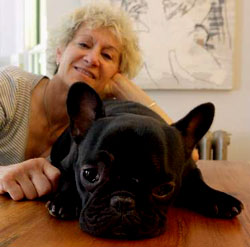 16
pounds — a tad more when she holds her favorite toy,
a "Mickey" doll, in her wrinkled mouth. Her name
is Ruby. She's a French bulldog. She's breaking the law. 16
pounds — a tad more when she holds her favorite toy,
a "Mickey" doll, in her wrinkled mouth. Her name
is Ruby. She's a French bulldog. She's breaking the law.
Here in this no-stoplight hamlet nestled in the mountains
of western Sullivan County, the law says you can only have
two dogs in a "settlement or business district."
Ruby's owner, Victoria Lesser, has two other dogs, Baxter,
a pug, and Roxie, a Great Dane, who live with her in her Old
North Branch Inn, putting her one pooch over the limit.
The sage-colored inn, which rents rooms, serves fare ranging
from organic coffee to chili and has two immaculately restored
set-your-own pins bowling lanes, looks like the only business
on its street of neat homes. There is, however, a post office
across the street. Mel's Garage and the volunteer firehouse
sit around the corner. It's safe to say that North Branch
— in the Town of Callicoon — has more animals
than people (estimated population, 300).
No
matter. The pet law — which also forbids howling, roaming
and property destruction — has sharper teeth than Ruby.
An owner can face fines of up to $300 for a third offense,
or up to 15 days in jail. It was passed eight years ago, after
complaints in the same hamlet about one resident with 150
dogs and cats and another with 17 dogs.
Still, the notion that little Ruby — who is as silent
as a mouse (and almost as small) — could feel the bite
of this law strikes some as ridiculous.
Take Robert Pisall, who paused from walking his dogs the other
day to say, "C'mon, we're in the country. You can have
50 cows but you can't have three dogs?"
Lesser — a designer who designed pajamas for Bill Cosby
— learned that the hard way. After she got Ruby, she
wanted to make her legal. When Town Clerk Janet Brahm realized
Lesser had three dogs, she says she checked with Callicoon
Supervisor Linda Babicz.
"The law's the law," said Brahm, adding that she
"feels bad" for Lesser. "But if you make an
exception for one ."
To which Lesser says, "I wanted to play by the rules,
but how was I to know?"
So there Ruby stands, on her tiny paws. But she can free her
11-inch body from the long leash of the law by tangling herself
in something else that's all too human — applying for
a variance.
Photo:
Victoria Lesser with her French bulldog, Ruby, at her home
at the North Branch Inn in the Town of Callicoon.
Times Herald-Record/MICHELE HASKELL
|
  
Brooklyn Man Threw Dog Off 6th-Floor Roof
Friday,
1 Dogust 2009
NEW
YORK (AP) -- A New York City man has been accused
of throwing his dog from the roof of a six-floor city housing
project in Brooklyn, critically injuring the animal.
  Joseph Pentangelo (right),
assistant director at the American Society for the Prevention
of Cruelty to Animals, says surgeons reassembled the one-year-old
terrier mix's front legs. The 45-pound dog, named "Oreo''
is able to walk.
Joseph Pentangelo (right),
assistant director at the American Society for the Prevention
of Cruelty to Animals, says surgeons reassembled the one-year-old
terrier mix's front legs. The 45-pound dog, named "Oreo''
is able to walk.
ASCPA officers arrested 19-year-old Fabian Henderson (left)
on Friday on felony charges of aggravated cruelty to animals
and reckless endangerment. His lawyer's name was not immediately
known.
Residents of the Red Hook Houses called the ASCPA last month,
saying a dog was being beaten inside an apartment. Neighbors
later called to say a dog had been thrown off a building's
roof.

YOU
PLUCKY DOG!
SURVIVES 'THROW' OFF 6-STORY BLDG.
By PHILIP MESSING, CANDACE AMOS and LUKAS I. ALPERT
Dogust
1, 2009
A 1-year-old wonder dog miraculously survived a six-story
plunge off a housing-project roof after being tossed by a
heartless Brooklyn teen, who was arrested yesterday, authorities
said.
 Oreo's legs were shattered, and she suffered internal injuries,
but the female, black-and-white terrier mix is expected to
pull through.
Oreo's legs were shattered, and she suffered internal injuries,
but the female, black-and-white terrier mix is expected to
pull through.
Fabian Henderson, 19, grabbed the dog and savagely hurled
her from the building in the Red Hook Houses on June 18, said
Special Agent Joe Pentangelo of the ASPCA.
"This was unquestionably an act of cruelty," he
said.
Several people called 911 saying a dog had gone off the roof,
and police found the maimed pup on the ground six floors below,
clinging to life.
All four of the dog's limbs had to be surgically repaired
with plates and screws. She also suffered internal bruising
and damage to her lungs.
Investigators have named her Oreo for her black-and-white
markings.
"She is healing, but it is a long road ahead," Pentangelo
said.
It was unclear whom the dog belongs to. While Henderson's
family said Oreo did not belong to them, NYPD Housing Police
issued Henderson a summons for walking a dog off-leash that
fit Oreo's description 12 days before the incident, sources
said.
ASPCA Special Agent Peter Rivas spent two weeks conducting
interviews before Henderson was arrested.
The teen didn't comment to reporters when he was brought into
the 76th Precinct station on charges of animal cruelty, reckless
endangerment and criminal trespass. At first, Henderson, who
has a prior robbery arrest, allegedly admitted to the crime.
But he later claimed the dog jumped off the roof, though investigators
say a large ledge made it unlikely the dog could have just
fallen, sources said.
Henderson's stunned family insisted that he "loved animals,"
noting their own dog, Diamond.
"I can't believe it. My son wouldn't do anything like
that," said his mother, Samantha, 41. "He is around
the dog all the time, and he has shown no signs of abuse with
the dog or any family member."
Henderson's girlfriend, Laniya Walker, 16, said, "It
was raining that day. We weren't even outside. I never saw
the dog."
|

U.S. Justice Department honors Best
Friends Animal Society for rehabilitative
work with Michael Vick’s fighting dogs
Dogust
1, 2009
Best Friends Animal Society received a 2009 Asset Forfeiture
National Award from the U.S. Justice Department for its “outstanding
work with the dogs on the Bad Newz Kennels (the Michael Vick
case).”
This award to Best Friends is in conjunction with 2009 National
Leadership Conference for the U.S. Justice Department’s
Organized Crime Drug Enforcement Task Forces (OCDETF) and
the Asset Forfeiture Program. The conference focused on the
essential role the OCDETF and Asset Forfeiture Programs play
in disrupting and dismantling illegal enterprises, depriving
criminals of the proceeds of illegal activity, deterring crime,
and restoring property to victims of crime.
 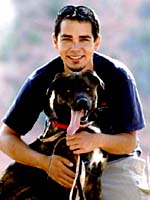
For the last 19 months, Best Friends has been in the national
spotlight for its care of nearly half the animals seized from
Michael Vick’s dog fighting operation. Considered the
most challenging cases, these dogs would have been destroyed
if Best Friends had not accepted them. During that time, the
dogs have made steady progress, with one dog being recently
adopted and another in foster care.
Co-managers of DogTown, Michelle Beshmehn (far left)
and John Garcia (left), accepted the award
on behalf of Best Friends.

“We are honored to receive this award,” said Gregory
Castle (right), interim chief executive officer
for Best Friends Animal Society. “This honor comes just
weeks after what is probably the single largest bust of dogfighting
rings in the country and it drives home the complexity of
the issues surrounding American pit bull terriers and other
‘bully breeds.’”
“It is our hope that across the country people will
step forward, as they did for the Michael Vick dogs and say
‘these dogs deserve a chance at life and here’s
what we can do to help.’”
This award arrives at a monumental time when Halle,
a dog rescued from Bad Newz Kennels, is being adopted into
her forever home.

|

SPLITSVILLE DUO IN 3RD TUG FOR PUG
DOGGED CUSTODY WAR
By JEANE MacINTOSH
July
31, 2009
The wedding was called off years ago, but a New Jersey couple
is still engaged in a pug of war over their dog.
Eric Dare, 36, and Doreen Houseman, 35, squared off Wednesday
in Salem County Family Court --  each
hoping to be named the permanent keeper of the leash for Dexter
(left), a 6-year-old Pug they got before
their relationship imploded in 2006. each
hoping to be named the permanent keeper of the leash for Dexter
(left), a 6-year-old Pug they got before
their relationship imploded in 2006.
It marked the third time that Dare, a South Jersey cop, and
former fiancée Houseman, a customer-service manager,
have gone to court over Dexter. The dogfight has cost $40,000
in legal fees so far.
Dare, who claims he let Houseman share the dog with him after
their 13-year relationship ended, was originally awarded custody
of Dexter last year by Salem County Judge John Tomasello.
But Houseman -- who had sued for custody in March 2007, contending
that Dare gave Dexter to her after the split -- appealed.
Last March, she won a precedent-setting reversal. An appellate
court ruled that pets have "special subjective"
and "sentimental value" that should have been considered
in the initial decision.
During the appeal, lawyers for the Animal Defense League and
Lawyers in Defense of Animals filed briefs, asking the appellate
court to adopt a rule "that requires consideration of
the best interest of the dog," court papers say. Dare
and Houseman were ordered back in front of Tomasello this
week.
"I'm not inclined to be Solomon and cut the dog in half,"
Tomasello told the warring exes Wednesday, according to the
Philadelphia Inquirer. "That dog has to go somewhere."
During testimony, Dare said he paid for the dog and footed
the veterinary bills. But he said he shared Dexter with Houseman
after they split to be civil, "just like people with
children have to share custody."
Houseman testified that she was "blindsided" when
Dare broke up with her and asked her to move out. But she
contended he told her she could have their precious, pedigreed
pooch.
She said the once-happy couple had referred to Dexter as "our
son."
During testimony, Tomasello sometimes appeared annoyed, rolling
his eyes and cutting Houseman short as she recounted how she
had pampered the pooch and showered it with gifts.
Tomasello
did not make a final custody decision. He ordered the dog-crazy
duo and their lawyers back to court in September. The judge
said there are three options: sole custody for either of the
two parties, or a joint visitation pact.
With
AP and
Post Wire Services
|
EXTRA

MICHAEL VICK REINSTATED BY NFL
Contact
NFL Commissioner Roger Goodell
Logon to http://www.nfl.com/contact-us
and protest
Contact DeMaurice Smith
Executive Director of the N.F.L. Players Association
nflpaexecutivedept@nflplayers.com
N.F.L.
Opens Door to Vick, Though Not All the Way
By
JUDY BATTISTA
Published:
July 27, 2009
A few years ago, Michael Vick was the highest-paid player
in the N.F.L. , adored by  fans
across the country who wore his Atlanta Falcons jersey, his
legend growing with each highlight-reel gallop across the
field. fans
across the country who wore his Atlanta Falcons jersey, his
legend growing with each highlight-reel gallop across the
field.
Now, Vick waits for a call as if he were the lowliest undrafted
free agent, hoping that a team will give him a chance to restart
his career after his involvement in a dogfighting operation.
Vick, the former star quarterback who served a 23-month prison
sentence for bankrolling the dogfighting ring, was conditionally
reinstated by the league Monday. The decision makes Vick,
29, eligible to sign with a team, join it during training
camp and play in the final two preseason games.
But Commissioner Roger Goodell has not determined when Vick
can return to  regular-season
games. That ruling is to come no later than Week 6, in mid-October,
although it could come much sooner if Vick’s behavior
is exemplary. regular-season
games. That ruling is to come no later than Week 6, in mid-October,
although it could come much sooner if Vick’s behavior
is exemplary.
The kind of market awaiting Vick , the first overall pick
in the 2001 draft, remains to be seen. While Vick was incarcerated,
several teams — including the Giants and the Jets —
said they would not be interested. But with training camps
opening this week and teams getting a close look at their
quarterback prospects, Vick is likely to find a few suitors.
Several people who have seen Vick say he is in fine physical
shape, and he will work out with a trainer.
Still, he is unlikely to be sought as an immediate starter,
but rather as a backup or as a situational quarterback for
formations like the Wildcat, which would take advantage of
his superb scrambling ability. Then perhaps next year, Vick’s
tortuous journey back to stardom and the riches that accompany
it will be complete. Vick needs that journey to be successful:
he has filed for bankruptcy and is deeply in debt.
But first, Vick must again convince Goodell — and owners
considering taking an enormous risk on him — that he
is prepared to reimmerse himself in the N.F.L. without drowning
in the bad decisions that pulled him down. Goodell said he
met with Vick for about four and a half hours, including two
one-one-one meetings in which they discussed Vick’s
past, the fact that he lied to Goodell when initially confronted
with the dogfighting allegations and the challenges Vick faces
off the field. Goodell said they did not discuss football.
“I believe he is sincere in his remorse,” Goodell
said in a conference call. “He recognizes what he was
engaging in was horrific and cruel. He wanted an opportunity
to prove that was not Michael Vick. He really didn’t
focus significantly on the loss of career and the loss of
money.”
In a letter to Vick on Monday, Goodell noted that Vick’s
margin for error was “extremely limited.” He wrote:
“My decision at that time will be based on reports from
outside professionals, your probation officer, and others
charged with supervising your activities, the quality of your
work outside football, the absence of any further adverse
involvement in law enforcement, and other concrete actions
that you take that are consistent with your representations
to me.”
 Tony
Dungy (left), the former Indianapolis Colts
coach, visited Vick during his time at a federal prison in
Leavenworth, Kan., and will be his mentor. Tony
Dungy (left), the former Indianapolis Colts
coach, visited Vick during his time at a federal prison in
Leavenworth, Kan., and will be his mentor.
Vick, who has been suspended since August 2007, was released
from federal custody on July 20. He is serving three years
of probation. In a statement Monday, Vick recalled the “terrible
mistakes” he had made in the past and referred to the
maturation he had since experienced.
“I would like to express my sincere gratitude and appreciation
to Commissioner Goodell for allowing me to be readmitted to
the National Football League,” Vick said. “I fully
understand that playing football in the N.F.L. is a privilege,
not a right, and I am truly thankful for the opportunity I
have been given.”
Goodell interviewed Vick’s family members and associates,
and Vick’s ability to show that he has severed ties
with some of the people who exerted a bad influence on him
at home in Virginia will probably be scrutinized by the league
before he is allowed back on the field. Vick also had to submit
a written plan concerning his proposed living arrangements,
management of his finances, counseling and mentoring plans
and his proposed work with the Humane Society of the United
States .
Goodell said that while considering Vick’s future, he
consulted with current and former players and coaches, as
well as community leaders, and encountered a broad spectrum
of reaction. Goodell spoke repeatedly with DeMaurice Smith,
the head of the N.F.L. Players Association, and on Monday,
Smith pledged to support Vick.
“We are pleased that he is on the right path to return
not only to the field, but as a contributing member of his
community,” Smith said in a statement.
Still, Goodell said some fans would be outraged by the decision
to allow Vick back into the league. The team that signs Vick
will almost certainly find animal-rights protesters greeting
it at training camp, which may deter a franchise that is not
a well-respected community presence, no matter how dire its
quarterbacking situation.
“I’m a believer personally that if somebody recognizes
either mistakes in judgment or things, they can do better
going forward, that the general public will recognize that
and give people an opportunity to prove themselves,”
Goodell said. “I’m trying to give Michael the
opportunity to prove himself to play in the N.F.L. again.
It’s in his hands now.”
• • •
Vick
Now Has to Deal With How Teams and Public Receive Him
By
WILLIAM C. RHODEN
Published:
July 27, 2009
Ingrid Newkirk was the first person who came to mind Monday
when N.F.L. Commissioner Roger Goodell  announced
Michael Vick ’s transition plan for reinstatement. announced
Michael Vick ’s transition plan for reinstatement.
Newkirk is the tenacious president and co-founder of People
for the Ethical Treatment of Animals . Her sprawling organization,
which is capable and quite willing to create havoc, will set
the tone for the reception Vick receives if he signs with
a team.
Now that Goodell has announced his soft re-entry plan for
Vick — conditional reinstatement and possible full reinstatement
no later than Week 6 based on progress he makes — will
Newkirk unleash a firestorm against the N.F.L. with legions
of pickets?
During a conversation on Monday, Newkirk seemed undecided
on what course of action she would take. “We’re
not encouraging it,” Newkirk said when asked about PETA’s
plans to picket. “We’re not in a picketing mood.”
Then in an about-face she said: “We may, I can’t
really say. There are so many strong sentiments. It’s
on the table, but we’re not encouraging it.”
Last year, PETA implied that it might work with Vick, who
attended the group’s sensitivity training. But Newkirk
suddenly backed off a partnership, perhaps because of internal
pressure, perhaps out of more pragmatic consideration. If
PETA forged a relationship with Vick, what justification would
the organization have for launching spectacles this fall at
stadiums where Vick plays — if he plays?
What Newkirk did was encourage the N.F.L. to probe Vick’s
psyche.
“We continue to ask Mr. Goodell to put him through psychological
counseling and testing to see if he can be remorseful,”
Newkirk said. “We still want cruelty to animals to be
part of the personal conduct policy for the N.F.L.”
Goodell said Monday that Vick had been tested, though apparently
not by PETA people. “We worked with animal-rights activist
groups,” he said. “Michael fully cooperated with
all of those tests; those tests did not indicate that there
was any reason he couldn’t make a transition forward.”
The other people who came to mind were N.F.L. general managers,
men whose lifeblood is providing their franchises with on-the-field
weapons. Publicly, most have made comments that sound like,
No way do we want Vick, or We like what we’ve got.
Even the Lions , the worst team in N.F.L. history, say they
are trying to build something.
Right.
Give general managers three weeks to see what they’ve
got. They all know in their hearts that Vick is better than
half the quarterbacks on rosters right now. But talent isn’t
the issue. Public relations is. How will signing Vick play
to a fan base? Under the terms of his conditional reinstatement,
Vick can sign with a team, join it in training camp and play
in the final two preseason games, but will have to wait until
Week 6 at the latest to play in regular-season games.
“This gives him the best chance for success,”
Goodell said. “We are not looking for a failure here.
We are looking to see a young man succeed.”
Maybe as part of the plan, Goodell has been twisting a few
arms, encouraging a couple of teams to take a chance on someone
who was once the N.F.L.’s most exciting player.
Goodell said Monday that the former Indianapolis coach Tony
Dungy had agreed to continue working with Vick as an adviser
and mentor.
Dungy may be the most important person on Vick’s rehabilitation
team, possibly in his life right now. One thing the two men
share is a deep sense of loss. Vick lost two years of his
life; three years ago, Dungy and his wife lost their son.
If anyone can show Vick the way from darkness to light, it’s
Dungy.
Loss often puts life in perspective and perhaps Vick will
come to see, if he hasn’t already, that this really
isn’t about football. It’s not about controversy,
boos, cheers or getting back to the roar of the crowd.
He had all of that and look where it got him.
Goodell calls this a transition plan. For Vick, one hopes
it’s the beginning of a great transformation.
|

PORT-ABLE PET LAND
OREGON'S BIG CITY IS A DREAM DESTINATION
FOR FIDO
Julia
Szabo
July 26, 2009
It's tough to find a dreamier destination for dogs and the
people who love them than Portland, Oregon, 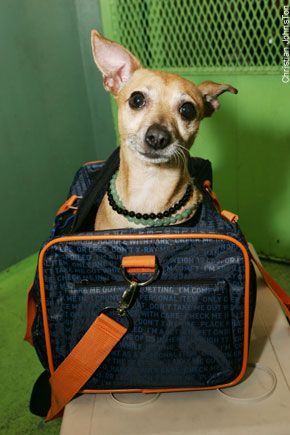 which
earned the title "Dog Town USA" from Dog Fancy magazine. which
earned the title "Dog Town USA" from Dog Fancy magazine.
JetBlue offers nonstop service for dogs -- provided the pooch
is small enough to fit inside an under-seat pet carrier. Conveniently,
the airline sells a stylin' blue-and-orange carrier that looks
right at home in JFK's swank new Terminal Five. They've even
got the "JetPaws" program, featuring frequent-flyer
miles for pets!
Once your plane touches down, the serious fun begins. Portland
International Airport has a spacious, grassy area equipped
with free poop-pickup bags so dogs can get comfortable right
before and after the nearly five-hour flight.
In addition to pet-friendly outdoor spaces like gorgeous Washington
Park, Portland is home to many dog-oriented businesses. Lucky
Labrador Brewing Company (luckylab.com) has three locations
where beer lovers can tap a keg with their best friends: Lucky
Labrador Brew Pub, Lucky Labrador Public House and Lucky Labrador
Beer Hall.
Another "lucky Lab" of sorts is Art, whose day job
is "director of pet relations" at the swank Hotel
Monaco (monaco-portland.com), where he greets guests in the
lobby. Meanwhile, at the nearby Hotel Vintage Plaza (vintageplaza.com),
the "diva of pet relations" is Georgie, a female
Havanese. Both dogs extend tail-wagging hospitality to human
and canine visitors.
Free four-footed features at both hotels include cushy dog
beds, toys, bowls and a mat, treats and pets' names chalked
on the welcome board at reception. There's even a pet portraitist,
pet masseuse and pet psychic. But those cost extra, along
with hiring a dog walker.
The Monaco's mouthwatering Red Star Restaurant and Pazzo Ristorante
at the Vintage Plaza both offer outdoor seating for diners
with dogs, and wine hounds may order a bottle of Rascal Pinot
Noir from the Great Oregon Wine Company, whose label features
a handsome, haloed hound.
Meanwhile, Portland's Gemisphere (gemisphere.com) offers healing
gemstone necklaces worn by Richard Gere, Sheryl Crow, Clint
Eastwood and Halle Berry. For stressed-out K9s adopted from
animal shelters, such as Humane Society rescue Gordon (pictured)
or any pet experiencing travel-related stress, Gemisphere's
Dr. Ada Gonzalez prescribes "grounding" Onyx and
"physically soothing" Light Green Aventurine.
On a sad note, the popular downtown Portland gift shop Funny
Bone (funnybonestore.com) is offering a whopping $5,000 reward
for the safe return of its beloved store mascot, a miniature
Yorkshire terrier named Veronica, who went missing in June.
Even in America's dog-friendliest city, bad things can happen.
But the good news is that Portland's entire K9 community has
rallied to help find Veronica. Now that's a city any dog would
be happy to visit.
Photo:
Christian Jhonston
|

Chicago's
dog beaches
Zak Stambor, Special to the Tribune
July
26, 2009
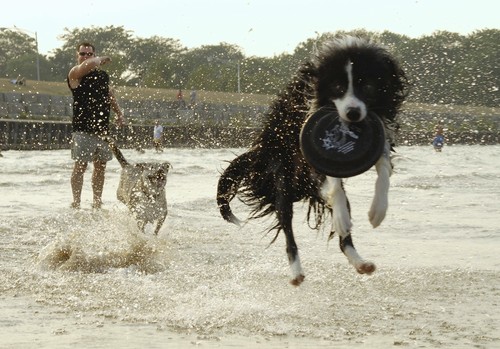
Rare
a decade ago, dog-friendly sections of the lakefront now number
six in the Chicago area, from Belmont Harbor in the city to
north suburban Lake Bluff.
Not all dog beaches are alike. Some are tranquil spots hidden
below scenic bluffs. Some are little more than a tiny strip
of sand.
|
 Wire
Services Wire
Services
Weird but True
By
LUKAS I. ALPERT
July 25,
2009
A blind British border collie has his own seeing-eye dog.
Clyde relies entirely on Bonnie to guide him to food and water
and take him on walks. The two have become inseparable, with
Clyde refusing to move unless Bonnie is there to help.
"He totally relies on her," said Cherie Cootes, who
rescued the former strays.
• • •
A
Chinese Alsatian has become the coolest dog in town by refusing
to leave the house without his signature sunglasses.
Fei Fei's owner said he bought the pooch the shades to protect
his eyes from the strong sun in Chongqing and he grew to love
them.
"If I don't put his sunglasses on before we go out, he
barks at me until I do," the owner said. |

Pet project more than puppy love
BRIGHTON PARK | Lifelong passion fuels big
plans to help strays
BY SANDRA GUY
July 25,
2009
As a little girl, Estela Michelle Bustos Flores sought out
animals in distress, and brought home 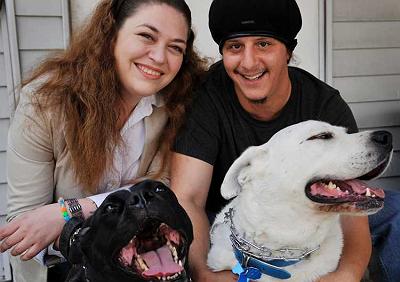 abandoned
animals and tried to hide them. When her parents let her pick
a pet goldfish, she chose the fish with one eye. abandoned
animals and tried to hide them. When her parents let her pick
a pet goldfish, she chose the fish with one eye.
Now, at 34, Bustos, who works as a waitress in her dad's Argentinian
restaurant, El Nandu, obsessively eyeballs every alley she
passes, saving stray dogs and abandoned animals she spots
in her Brighton Park neighborhood. One time, she even jumped
from a moving car to keep a dog from trying to cross busy
Archer Avenue.
"She feels such a deep need to protect these animals
because they cannot defend themselves," said neighbor
Eduardo Garcia.
Her fiance, Paul Calcano, said of her: "She sacrifices
everything for these animals. She even refuses to buy new
clothes so she can use the money she saves for the animals."
Bustos said she was "rebellious and angst-ridden"
as a teenager, then found her calling and a sense of peace
in rescuing abused, abandoned and neglected animals.
Her passion reached its zenith after her beloved American
pit bull terrier, T-Bone, died eight years ago on Bustos'
birthday. Her sister Tania had saved the dog from an owner
who tied him to a radiator, beat him and denied him food.
Michelle Bustos credits T-Bone for her dedication to changing
the lives of animals in need.
"We're a bunch of people with no money," Bustos
said. "How do we start something?"
Bustos' mom, Rita, a former Chicago community organizer, came
up with an idea: Rita would allow her longtime artist-friends
to teach her how to create art in a variety of disciplines
-- pastels, sketches, oils and acrylics and more -- and she
would auction off her handiwork. Michelle's mom is being joined
by eight professional artists who are contributing their work
to a fund-raiser Sunday.
The fund-raising "Artists 4 Life" exhibition will
be held from noon to 4 p.m. Sunday at El Nandu restaurant,
2731 W. Fullerton. Bustos said the money raised will be used
for veterinary care for her rescued animals and to help create
a nonprofit organization. She dreams of opening a no-kill
shelter and a dying-animal hospice.
Photo
(Jean Lachat/Sun-Times): Estela Michelle Bustos Flores with
fiance Paul Calcano, and dogs Lucy and Ace, two of their many
rescued pets.
|

It's official! Halle’s “Vick~torious”!
The first Vicktory dog is being adopted!
by David Dickson
July
25, 2009
Woohoo! Sound the bells, toss the confetti! Halle the Vicktory
dog proves once and for all that not only  does
every dog deserve a second chance, but she can take that chance
and run with it to a happy ending of epic proportions. Her
life now is totally backwards and opposite in every possible
way from her days before as part of Michael Vick's dogfighting
ring. Good for her! does
every dog deserve a second chance, but she can take that chance
and run with it to a happy ending of epic proportions. Her
life now is totally backwards and opposite in every possible
way from her days before as part of Michael Vick's dogfighting
ring. Good for her!
You may remember that six months ago Halle went into foster
care with her new mom Traci. Part of the intricate legal hoops
with adopting any Vicktory dog is that the dog must first
live in a potential new home for six months before being considered
for adoption. There are a whole host of other things that
have to happen during those six months as well (such as working
with a trainer toward Canine Good Citizen certification) but
in the end it all came down to waiting out the time. Traci
and Halle sailed through the other stuff perfectly.
In fact, Traci's application, paperwork and so forth are already
filled out and approved. At this point, it's just a matter
of waiting for the calendar to flip over to the date when
everybody can sign on the dotted line and Halle will be adopted
once and for all.
So, when exactly does that happen? This week, as it turns
out! The six-month date falls this Saturday, July 18. Traci
has big plans, including an even bigger party, for Halle and
pals on her big day. But here's the best side of the whole
thing. To Halle, the festivities will be nothing more than
business as usual. To her, every day is a party now!
Backing up a bit, several months before Halle went into foster
care, Traci had adopted another pit bull from Best Friends.
Anybody remember Tacoma? He came to Best Friends from the
local animal control. Almost immediately, Tacoma proved his
invaluable skills as an office assistant in Dogtown. Nobody
could knock over furniture and swoosh files off the counters
like Tacoma. But his true genius, his ace in the hole, as
it were, was that Tacoma could bring a smile to any face that
walked in the door.
If you had a chance to meet him during his brief stay at the
sanctuary, you won't have to wonder how Traci fell head over
heels in love with him. She decided to adopt and Tacoma was
everything Traci hoped he would be. Soon, however, she was
thinking about finding him a friend.
She thought it may be a long shot, but Traci applied to adopt
one of the Vicktory dogs. Traci wanted to help one of those
dogs have a better life. In her application, she asked the
staff members to pick whichever dog they felt would best get
along with Tacoma (since they knew Tacoma).
Put simply, the adoption staffers hit one out of the park
with Halle. She was the picture-perfect match for Tacoma,
and he for her. She has always been a little shy, but Tacoma
has enough confidence for three dogs. They hit it off the
very first day, snuggling together on a sleepover and everything.
Traci knew Halle was the right fit.
The last six months have been magical indeed for Halle, Tacoma,
and Traci. Traci is able to bring the two dogs to work, where
they soak up loads of attention and treats from coworkers.
The dogs go on hikes with Traci all the time, they have play
dates with other canine pals, and the two are inseparable
day and night. They play constantly in the house and yard.
Swimming pools in the summer, snow wrestling in the winter,
Tacoma and Halle are stuck like glue. In fact, Traci says
that even though she bought them double beds, they're never
in more than one at a time. They double up in the dog beds,
on the couch, Traci's bed, anywhere!
Halle has come a long way with her confidence, too. Here's
one example. Back when she first went into foster care, the
video folks at Best Friends wanted to get some footage of
the big day. That didn’t work out, though,
because Halle got really nervous around the cameras. A couple
weeks ago, however, Traci attended a nearby news conference
to talk about pit bulls. This time around, Halle had no problems
with the cameras. She let the reporters pet her and everything.
Sometimes that confidence isn't always a good thing, though.
Halle has developed a mischievous streak! Traci says that
one of Halle's new favorite pastimes is to sneak up on her
while she's applying makeup for the day. Halle watches, waits,
and then quick as can be, she grabs one of the cosmetics and
dashes out the room! (Hey, she's gotta look good for Tacoma,
right?)
Safe to say, this is one happy family. Congratulations, you
guys. Some happy endings take a bit longer to pull off than
others, but this one was worth the wait.
Halle and Tacoma are helping to dispel the negative stereotypes
surrounding pit bulls. For more information about breed discriminatory
legislation, dogfighting, and other challenges pit bulls face,
see the Pit Bulls: Saving
America's Dog campaign.
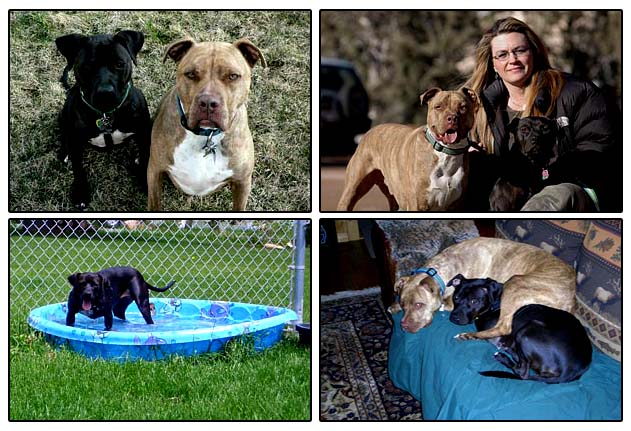
Photos provided courtesy of Traci :
Halle and Tacoma / Tacoma and Halle with Tracy
Summer fun with Halle / Bed buddies
|
• • •
 News
Release
July 24,
2009
News
Release
July 24,
2009
Michael
Vick Released from Federal Custody
ASPCA President Speaks Out
“The question isn't whether he deserves to earn
a livelihood. The question is whether Mr. Vick should be able
to re-join the ranks of elite athletes in the NFL.”—Ed
Sayres, ASPCA
President & CEO
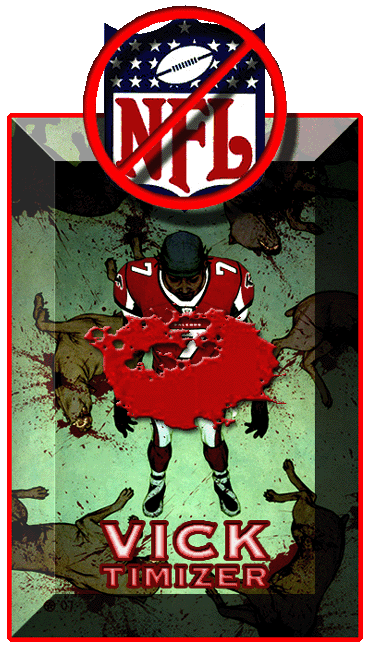
On Monday, July 20, former Atlanta Falcons quarterback Michael
Vick, once the highest-paid player in the National Football
League (NFL), was released from federal custody after serving
a 23-month sentence for dog fighting. The investigation into
the horrific activities that took place at Vick’s Virginia
dog fighting operation, Bad Newz Kennels, and his 2007 federal
conviction not only led to a sullied public image, but to
the star quarterback being let go by his team and indefinitely
suspended from the NFL.
In light of th e ASPCA’s
integral role in the investigation—we collected forensic
evidence for the court case and led a team of behaviorists
in the evaluation of the dozens of dogs rescued from Vick’s
property—Ed Sayres, ASPCA
President & CEO, offers his unique perspective on the
release of Michael Vick and the question on everyone's mind:
what will he do now?
The following are selections from Sayres's
statement, which can be read in its entirety at ASPCA.org.
"…the
facts are clear: Mr. Vick participated in a six-year pattern
of illegal activity. His plea clearly stated that along with
these activities, he savagely electrocuted and beat dogs to
death after they lost their brutal fights[…]. This was
not a one-time transgression or crime of passion—this
was a multi-year pattern of behavior that demonstrates a startling
lack of moral character and judgment.”
"Given the stature of what it means to be a part of the
NFL, it is crucial that Mr. Vick first express remorse for
what he has done—something that he has yet to do throughout
his incarceration.”
Original
illustration, "GUILTY", by Ian Kim
Additional digital enhancement by ARTGRUNGE
• • •
|
ASPCA
Offers
Nation’s First Animal Cruelty CSI Workshop
The ASPCA,
in collaboration with the University of Florida’s William
R. Maples Center for Forensic Medicine, recently offered the
nation’s first Veterinary Forensics Crime Scene Investigations
Workshop to help increase the number of professionals trained
in the forensic investigation of animal cruelty cases and
aid in the prosecution of crimes against animals.
The three-day workshop, which took place from June 17-19,
offered students—many of whom were law enforcement officers,
veterinarians, forensic specialists and emergency responders—a
hands-on training experience. Through fieldwork and classroom
instruction, students learned to detect and properly document
a crime scene, including the collection of evidence, photography,
mapping, sketching and the excavation of remains.
The program reaches beyond a workshop, as well. The University
of Florida will soon be offering undergraduate and postgraduate
courses in veterinary forensic sciences. The program will
receive an initial gift of $150,000 from the ASPCAand
three years of support from our organization.
“The development of veterinary forensics is in a similar
place now that human forensics was a few decades ago,”
says Dr. Melinda Merck, ASPCA
Senior Director of Veterinary Forensics, who was on hand at
the workshop with the ASPCA's
Mobile Animal Crime Scene Investigation Unit. “Now there
are special prosecutors and special courts that focus on violent
crimes—I expect that is where we’ll eventually
get with animal cruelty.”
• • •
|
Legislative
Victory: CT Passes Pet Store-Related Bill
Earlier this month, Connecticut Governor M. Jodi Rell signed
into law Senate Bill 499, legislation
spearheaded by the ASPCA
and Connecticut Votes for Animals (CVA). The new law will
help shoppers make more educated decisions when purchasing
a pet by requiring all retail pet shops in the state of Connecticut
to disclose where the puppies they sell came from. Each dog’s
“certificate of origin” must be posted openly
(no more than 10 feet from his enclosure)—and, when
a puppy is sold, a copy of his certificate must be given to
his purchasers. Pet stores are also responsible for guaranteeing
that their out-of-state animal suppliers are licensed by the
USDA and appropriate state agencies. Violations of these measures
can result in fines and jail time.
“This bill ensures accountability from both pet stores
and the animal breeders that sell to them,” says Debora
Bresch, ASPCA
Legislative Liaison to Connecticut. “Sadly, puppies
sold at pet stores are usually from puppy mills.” A
puppy mill is a commercial breeding enterprise where dogs
are mass-produced for profit without concern for their health
or welfare. With your help, the ASPCA
is working tirelessly to pass legislation in every state to
ensure that all animals bred to be pets are raised in healthy
conditions.
Want
to have a hand in passing pro-animal legislation in your state?
Join the ASPCA
Advocacy
Brigade.
|

BELOVED
CHOWHOUND IN DOG HEAVEN
GOODBYE, TACO BELLE
By Todd Venezia
July
23, 2009
Vaya con tacos, amiga!

The final bell has tolled for a charming Chihuahua who  became
an advertising icon in the 1990s for saying, "Yo quiero
Taco Bell!" in TV ads for the fast-food chain. The little
dog named Gidget was 15 when she died on Tuesday from the
effects of a stroke, according to People magazine. became
an advertising icon in the 1990s for saying, "Yo quiero
Taco Bell!" in TV ads for the fast-food chain. The little
dog named Gidget was 15 when she died on Tuesday from the
effects of a stroke, according to People magazine.
"She made so many people happy," Gidget's trainer,
Sue Chipperton, told People.
Gidget first appeared mouthing her famous catch phrase --
which means "I want Taco Bell" -- in 1997. She played
the part of a male pup, and her voice was performed by "Reno
911!" actor Carlos Alazraqui.
Gidget's slogans would enter the pantheon of legendary ad
lines along with "Where's the Beef" and "I
can't believe I ate the whole thing."
She
was immortalized in toys and was credited with making Chihuahua
sales soar, and some of her other Taco Bell lines became famous,
such as "Drop the chalupa!" and "Viva gorditas!"
She would later appear in a Geico ad in 2002 and the film
"Legally Blonde 2: Red, White & Blonde" in 2003.
But she didn't get much work in her later years because she
was typecast, her trainer said recently.
Nevertheless, she was enjoying a happy retirement in Santa
Clara, Calif., Chipperton told People earlier this year.
"She loves laying out in the sun," said Chipperton.
"It's like looking after a plant." The chalupa-hawking
pooch remained popular after her retirement, and would be
recognized as she went on hikes and trips to the beach with
her trainer. The perro viejo -- who was 76 in human years
-- enjoyed nothing more than to snooze in the sun.
"She was like a little old lady. She'd kind of gotten
smaller," said Karin McElhatton, owner of Studio Animal
Services in Castaic, which owned the dog. McElhatton said
Gidget will be cremated. Her owners had not decided on a final
disposition of her remains yesterday.
Taco Bell Corp. said in a press release that Gidget would
be missed by many. "Our deepest sympathies go out to
her owners and fans," the company said.
|
 Over
90 dogs, many Chihuahuas, found in Michigan home
Over
90 dogs, many Chihuahuas, found in Michigan home
By DAVID RUNK
Associated Press Writer
Thursday,
July 23, 2009
DEARBORN, Mich. A man kept more than 90 dogs - mostly Chihuahuas
- in a small suburban Detroit home  that
from the outside looked generally well kept but inside was filled
with feces and trash, authorities said Thursday. that
from the outside looked generally well kept but inside was filled
with feces and trash, authorities said Thursday.
Neighbors in the past had complained of an odor, but this week
was the first time Dearborn officials got inside. On Wednesday
and Thursday, crews wearing masks to help them breathe carried
dogs from the two-story home.
"There's trash from floor to ceiling," said Nick Siroskey,
director of residential services for the city. "There's
feces and urine throughout the entire house."
City workers, along with Friends for the Dearborn Animal Shelter,
removed 42 ailing and feces-covered dogs from the home Wednesday.
They returned Thursday and found about 50 more dogs.
The 56-year-old man who was living in the house was taken to
a local hospital for observation. His family, which lives in
Florida, was involved in his care and cooperating with officials.
The man's sister told officials that she believed he initially
had two dogs in the home and that they may have reproduced,
Siroskey said. Misdemeanor animal cruelty charges were possible,
but Siroskey said the man appears to have mental health issues
that could be a factor in the case.
Outside, the lawn was neatly cut and the bushes were manicured.
Neighbors and investigators said the smell of urine, noticeable
from the street Thursday, may have been contained previously
because windows were closed and covered.
"There was a little bit of a smell, but it was just like
a ... person that doesn't keep their house up," said Abe
Baydoun. "He didn't take care of himself, personally, but
he took care of the outside of his house." Baydoun, 25,
lives across the street and said he only had seen two of the
man's dogs outside. "It just seemed like there was five
or six," he said.
The dogs, which were being examined at the animal shelter, appear
to have been unattended and were in various stages of health.
Crews pulled bags full of trash from the home to clear pathways
inside. The house was deemed unfit for human habitation and
the city likely will seek to tear it down, Siroskey said. On
Friday, Siroskey said police were called to the home by a neighbor
who spotted some kittens in a hole in the backyard, and the
officer who responded reported that it seemed like there were
many dogs inside. Animal control authorities got the case and,
after obtaining a warrant, investigators went inside Wednesday.
|
 Wire
Services Wire
Services
BARK
TRANSLATOR
Weird
but True
By LUKAS I. ALPERT
July
22, 2009
Dog-o origato, Roboto San.
A Japanese toymaker has created a device that can translate
a dog's barks into human words. The "Bowlingual Voice"
tells a dog's master whether the pooch is sad, happy, frustrated
or just wants to play. |

Bow
ouch! City's Animal Care cuts adoption schedule
'IT'S IRONIC' | City's Animal Care has cut
adoption schedule from 49 hours a week to 17 to accommodate
layoffs
BY FRAN SPIELMAN City Hall Reporter
July
21, 2009
Chicago's 2009 vehicle sticker features a dog with a city
flag stuck in its mouth above the slogan, "Dog 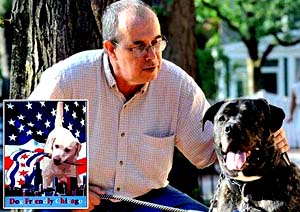 Friendly
Chicago." Friendly
Chicago."
Somebody forgot to tell the Commission on Animal Care and
Control. Animal Care has dramatically reduced its adoption
schedule -- from 49 hours a week to 17 -- to accommodate the
layoffs ordered by Mayor Daley after two holdout unions refused
to make cost-cutting concessions.
Even worse was the fact that the David R. Lee Animal Center,
2741 S. Western, was not open for adoptions Sunday, which
had been one of the busiest days of the week for dog and cat
adoptions.
"The fear among the volunteers is that more animals will
be euthanized because people will not be able to access the
shelter during the hours most convenient to the public,"
said volunteer Katharine Wilson.
But on Monday city officials reversed themselves under pressure
from volunteers and questions from the Sun-Times.
They now vow to keep the shelter open on Sundays, instead
closing on another week day, in addition to the Monday they
had already decided would also be a no-business day.
Monday's reversal came after a confusing day Sunday. Dozens
of people showed up at the shelter Sunday oblivious to the
new hours, according to volunteer Dee Brodlo, who set up a
card table outside to explain the change and urge people to
call their local alderman to protest.
"We're losing out on all those people who were turned
away. It's almost like they're making it impossible for someone
to come and adopt," Brodlo said. She added, "There's
only so much room in the adoption pavilion. If we're not moving
dogs out, and every day we get more surrenders and strays
coming in because of the economic situation, it's got to lead
to more animals" being put to death.
Marvin Feutz, yet another volunteer, said, "It's ironic
that we're doing this to the dogs and cats of Chicago the
year I'm paying $120 for my city decal that has, 'Dog Friendly
Chicago' as the motto."
Sandra Alfred, acting executive director of Animal Care and
Control, said the department was forced to cut back its schedule
after laying off five workers whose union refused to agree
to concessions.
Alfred said she initially decided to close Sunday and Mondays,
but changed her mind on the Sunday closure after volunteers
voiced concerns.
"We plan to change the schedule to remain open on Sundays
and instead close on Tuesday, Wednesday, or Thursday [we will
determine the appropriate day within the next several days],"
Alfred said in an e-mail. "We may also seek some grant
funding that would allow us to restore some of these positions
and again remain open for adoptions and redemptions seven
days a week." Until last week, the center was open for
adoptions from noon to 7 p.m. seven days a week. Until Alfred's
about face, the revised hours were to be 3-to-6 p.m. Tuesday-through-Friday
and Saturday from noon-to-1:45 p.m. and 3-to-6 p.m. It's unclear
what the hours will be now.
Animal Care and Control euthanized 17,159 animals in 2006
and had hoped to hold the number of cats and dogs put to sleep
this year down to 10,000, according to the mayor's budget.
The number of annual adoptions hit a peak of 3,541 in 2005
and has declined every year since. The goal for 2009 is 2,600
adoptions.
Noting that the city receives a $65 adoption fee, Feutz said,
"Adoptions are a revenue source for the shelter. If you
close your doors and cut your hours by two-thirds, you're
cutting revenue and increasing expenses. It's shortsighted."
Meanwhile,
voluntary surrenders of dogs are up at least 20 percent. "Since
the economy went south, there are even more fancy dogs coming
in," Brodlo said.
Feutz said there's a Mastif named Moses at the shelter that
weighs 80 pounds, even though it should weigh as much as 130.
"Here's an underweight dog because the family couldn't
afford to feed it," he said.
Photo:
Volunteer Marvin Feutz, with his adopted dog Dunkin, says
"it's ironic" that the city has promoted dogs on
its sticker. The city's vehicle sticker (inset) says "Dog
Friendly Chicago."
(Keith Hale/Sun-Times)
|
 Wire
Services Wire
Services
Weird
but True
By DAVID K. LI
July
20, 2009
This man is his dog's best friend!
David Grounds, 65, lost two fingers while fighting a 7-foot
alligator that had clamped its powerful jaws on his Wheaten
terrier. The West Palm Beach civil engineer said all that mattered
was that his pooch, Mandy got, away safely: "I'd do it
again." |

Charlotte Woman Saves Five-legged Dog
from Life of Sideshows
Puppy owned by Gastonia, N.C., man was close
to getting shipped to N.Y.
By Ely Portillo
Saturday,
Jul. 18, 2009
CHARLOTTE -- How much would you pay for a dog with five legs?

If you're Allyson Siegel, the answer is $4,000, plus at least
$2,000 more for medical expenses to remove said leg. The 45-year-old
Charlotte woman bought Precious the puppy, whom she has renamed
Lilly, from Gastonia, N.C., resident Calvin Owensby last week
because she couldn't bear to see her sold to a show that features
deformed animals.
Lilly was born about six weeks ago to Owensby's Chihuahua,
Diamond, and is a Chihuahua-terrier mix. One of six puppies,
she seemed healthy, except for the extra appendage. The fifth
leg, white and without feeling, hangs down between her two
back legs.
When John Strong , the owner of a Coney Island sideshow, heard
about Lilly from a friend, he knew he had to have her. Owensby
asked for $3,000, and Strong immediately agreed to the price.
“There are millions of dogs with four legs, and there
are only three with five legs I'm aware of,” said Strong,
who makes it his business to find the deformed animals.
The money couldn't have come at a better time for Owensby,
a 57-year-old electrician who was laid off in December. “I've
been looking for work, can't find work nowhere,” he
said. “It hurts when you go from $500 a week to nothing.”
Strong saw it as a good deal too. Not only had he passed over
the chance to buy a five legged dog just last year, he moved
27 live animals and 250 stuffed, preserved or mummified ones
to Coney Island for the summer season just this spring, setting
up down the street from a well-established rival sideshow.
But when a local paper published Owensby's plans — and
his phone number — he started getting calls from irate
animal lovers, protesting the sale and “cussing me out.”
Allyson Siegel also read the story, and decided she couldn't
let the adorable puppy live the life of a carny. She has donated
to animal charities and helped injured animals, but she felt
she had to do more for this little dog. “I just called
him and I said, ‘How much'?” Owensby still wanted
a $3,000 profit, but he had to pay back a $1,000 deposit that
Strong had given him, so Siegel forked over $4,000.
Siegel says a simple creed motivated her: “Don't do
to animals what you wouldn't do to your kids.”
Surgery to remove the leg, which is tripping Lilly up as she
tries to walk, is scheduled in two weeks. And after all her
trouble, Siegel — who already has six cats — plans
to give Lilly to her sister in Charlotte to raise.
Strong scoffs at the notion that his show constitutes animal
abuse, and said he would have given Lilly a good life. And
although Strong is disappointed that he didn't get the dog,
he said he's counting his blessings. “Sometimes, you
just gotta say, ‘OK, I still have nine live, two-headed
animals,' and move on.”
FOLLOW
UP

Lilly the pup is now free of her extra leg
Coney Island freak show owner vows custody
fight despite leg's removal:
‘We're going to sew it right back
on.'
By Ely Portillo
July
24, 2009
Allyson Siegel says she bought Lily, a five-legged puppy,
to spare her from a New York man's plan to put her in an animal
show. She vowed to fight the man's threatened lawsuit.
The owner of a Coney Island, N.Y., animal show says he's legally
entitled to buy Lily, a five-legged dog.
 
Lilly the five-legged puppy had her fifth leg removed Thursday.
Allyson Siegel (right
>) – the Charlotte woman who paid
$4,000 to rescue the dog from a future in a New York freak
show – had the surgery performed Thursday morning, a
day after the show's operator threatened to sue for custody
of the dog. Siegel said the 90-minute operation went well.
“There were no complications whatsoever,” Siegel
told the Observer. “The vet says he expects her to make
a full recovery. All four legs work great.” Siegel declined
to say exactly where Lilly had the surgery. She had planned
the operation for next week, but decided she needed to act
quickly when the custoday dispute erupted.
On Wednesday, John Strong, the owner of the Coney Island exhibit
of unusual animals, threatened legal action to stop any surgery
until his claim to Lilly could be considered in court. Strong
said he had an implied contract with Lilly's original owner,
Calvin Owensby of Gastonia, complete with $1,000 deposit.
But Owensby broke the deal when he returned Strong's deposit
and sold Lilly to Siegel for the same $3,000 price.
Lilly's plight has played out in local and national media
over the last few weeks.
Siegel said she appreciates all the support she's received,
but the media firestorm had become too intense. She wanted
her seven-week-old Chihuahua-terrier mix to have surgery and
begin a more normal life. The dog's fifth leg, which hung
limp and without feeling between her hind legs, made it difficult
for Lilly to walk. “I just want it to be over,”
Siegel said Thursday. “What I did was for Lilly.”
Siegel also emphasized she has no hard feelings for Strong:
“I have no judgment about him.”
Strong could not be reached Thursday and apparently didn't
deliver on his Wednesday promise to sue. Clerks at the Mecklenburg
and Gaston county courthouses said they hadn't received a
lawsuit Thursday.
In an interview with the (New York) Daily News, however, Strong
said he would continue his custody fight, regardless of Thursday's
operation to remove the extra leg. “We're going to sew
it right back on when we win the civil case,” he told
the Daily News. “What good is a four-legged puppy to
a freak show?”
The Animal League of Gaston County has raised about $1,000
to help defray Siegel's expenses, Siegel said. A benefit for
Lilly is planned for 6 p.m. today at the Dog Bar in Charlotte's
NoDa district. No word yet on whether Charlotte's most famous
four-legged dog will appear.
|

Redefining ‘Government Watchdog’
One Bite at a Time
By JEREMY W. PETERS
July
17, 2009
ALBANY — At six pounds, much of it frizzy white fur, Cheerio
Paterson looks harmless enough.
But
in the nearly year and a half since he became New York’s
First Dog, the little Maltese has earned a  reputation
as a fierce, high-strung guardian of the executive mansion. reputation
as a fierce, high-strung guardian of the executive mansion.
He has sunk his teeth into a state trooper and run in furious
circles around senior legislative staff members, barking at
them scoldingly. This week Cheerio, age 5 (or 35 in dog years),
claimed his latest victim: a carpenter who was working on the
mansion on Thursday.
Cheerio’s miniature fangs left enough of a mark on the
carpenter, Thomas Keyser, that he decided to see a nurse at
the Empire State Plaza concourse, a few blocks from the mansion,
Gov. David A. Paterson’s office said.
Cheerio’s tendency to occasionally chomp on the help so
concerns Mr. Paterson that he said through a spokeswoman on
Friday that he will bring a dog trainer to the executive mansion
next week to put Cheerio through obedience training.
The spokeswoman, Marissa Shorenstein, confirmed that in addition
to attacking the carpenter, Cheerio has bitten a state trooper
and perhaps one other person since moving into the executive
mansion in 2008.
The New York Post, which reported the incident Friday, said
that the dog had also bitten an elevator worker and a painter
at the residence.
Ms. Shorenstein said Cheerio is not a troublemaker. But interviews
with people who have petted or played with him or heard his
piercing bark reveal that Cheerio can be something of a menace.
“It certainly didn’t seem like the kind of dog you’d
want to reach out and pet,” said one Republican staff
member in Albany, who, like most people interviewed about Cheerio’s
disposition, declined to speak on the record out of fear of
further antagonizing the pooch. The Republican staff member
recalled a meeting on a hot August day last year at the executive
mansion with Mr. Paterson; Dean G. Skelos, then the Senate majority
leader; and Sheldon Silver, the Assembly speaker. While members
of Mr. Skelos’s and Mr. Silver’s staff sat on a
couch in the living room waiting for the meeting to end, Cheerio
yelped loudly, ran around in circles and jumped up on the couch,
where he barked some more.
A Paterson associate, who also asked not to be named, said he
was petting Cheerio one evening at the mansion when he remarked
to another guest how docile and friendly the dog seemed. “Yeah,
until he bites you,” the other guest said, and told a
story about the dog lunging at a state trooper on the governor’s
security detail.
Through Ms. Shorenstein, Mr. Paterson on Thursday described
his relationship with the dog as “strained,” though
he admitted to sometimes letting the dog rest on his lap while
he listened to his daily briefings on the telephone. The dog
is more the pet of the governor’s wife, Michelle Paige
Paterson, and Mr. Paterson’s patience with Cheerio has
been known to fray.
After the attack Thursday, the Patersons checked Cheerio’s
vaccination records and made sure all his shots were up to date.
Cheerio splits his time between Manhattan and Albany, and is
said to enjoy staying at the governor’s mansion because
of the sweeping five-acre grounds that surround it. He is also
given the run of the house.
Pets are almost always a plus for a politician, from Franklin
Delano Roosevelt’s Scottish terrier Fala to President
Obama’s new Portuguese water dog, Bo. Dogs tend to humanize
politicians, showing their more playful side. Cheerio’s
behavior, of course, could test that truism. (President George
W. Bush’s beloved dog Barney did last year when he bit
a Reuters reporter on the index finger.)
Still, Cheerio is not the first dog to snap at a visitor to
the New York governor’s mansion. Cara, Gov. Mario M. Cuomo’s
German shepherd, once bit Rudy F. Runko, a deputy budget officer
at the time.  Patrick
Bulgaro, then the budget director and Mr. Runko’s boss,
said he empathized with Cara. Patrick
Bulgaro, then the budget director and Mr. Runko’s boss,
said he empathized with Cara.
“I don’t know what Rudy was doing,” Mr. Bulgaro
joked in a phone interview Friday. “There were days I
felt like biting Rudy, too. So I can’t say I blame the
dog.”
Cheerio and Cara had nothing on Gov. Thomas E. Dewey’s
Great Dane, who was known as a fierce protector of the mansion’s
grounds. Mr. Bulgaro, who grew up in the Albany area, said he
remembered walking past the mansion and seeing the dog barking
at the fence — a successful deterrent that “let
you know you weren’t welcome in the area,” he said.
At least one person who has visited the mansion and seen Cheerio
on his best behavior said the dog should not be blamed. Albany,
he said, can bring out the worst in anyone. “Maybe Albany
has a way of turning friendly pets into rabid animals.”
Photo: Mario Cuomo with Cara in 1994.
James Estrin/The New York Times
|

EVEN
DAVE'S DOG IS 'SIC' OF ALBANY
By FREDRIC U. DICKER State Editor
July
17, 2009
ALBANY -- It was another do-nothing day at the state Capitol
yesterday, but over at the Governor's Mansion, some real action
took place.
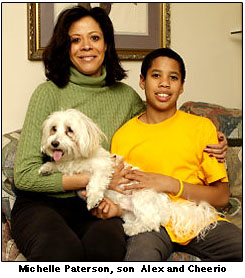
Gov. Paterson's dog attacked a state carpenter -- proving it's
the only living thing with any bite in Albany. Cheerio, a 6-pound
Maltese, bit Thomas Keyser in the leg in what sources said was
at least the third attack by the pooch on a state worker this
year.
A source familiar with the incident said Keyser, who was fixing
a staircase rail, had to "repeatedly shake his leg up in
the air because the goddamn dog wouldn't let go." Paterson
was in New York City at the time.
"The dog came running out of the kitchen and bit me on
my calf," Keyser, 53, of upstate Troy told The Post. "Everyone
over there knows the dog is aggressive. I know plenty of these
guys who got bit, and if they can't put this dog in a cage,
I can't understand it."
Paterson spokesman Peter Kauffmann confirmed the attack.
A source said last night that Cheerio had been caged and brought
to a state Health Department lab for observation and to make
sure he had received required vaccines.
Kauffmann said Cheerio had been up to date with shots. A source
also said other state workers had been bitten by Cheerio. "The
elevator guy got bit, the painter got bit," the source
said.
An Office of Government Services spokesman, Brad Maione, said
he was unaware of any other biting charges.
|

Record-Breaking Dog Fighting Raid Leads to Nearly 500 Rescues
July 17,
2009
Last week’s multi-state dog fighting raid, the largest
federal and state agency crackdown on dog  fighting
in U.S. history, has resulted in the rescue of nearly 500
dogs, most of whom are Pit Bulls. At the Humane Society of
Missouri (HSMO), which is housing more than 400 dogs, 14 puppies
were born last week, adding to the overall number of dogs
seized. fighting
in U.S. history, has resulted in the rescue of nearly 500
dogs, most of whom are Pit Bulls. At the Humane Society of
Missouri (HSMO), which is housing more than 400 dogs, 14 puppies
were born last week, adding to the overall number of dogs
seized.
The operation spanned eight states—Missouri, Illinois,
Iowa, Texas, Oklahoma, Arkansas, Nebraska and Mississippi—and
news reports indicate that a total of 26 arrests have been
made. Because dog fighting is a felony in all 50 states, if
convicted of animal fighting charges, those arrested each
face up to five years in prison.
According to the ASPCA’s Dr. Randall Lockwood, Senior
Vice President of Anti-Cruelty Field Services, who was on-site
in Missouri, not all dogs seized in raids have been used directly
in fights. “Some are breeders—they do not fight,
but produce litters of fresh fighters. Others are bait dogs.
They lack the bloodlust and so serve as punching bags in training
fights. Such dogs often get the worst of it.” Although
the task of evaluating all of the seized dogs will be enormous,
Dr. Lockwood notes, "At the very least, we're honoring
these animals by caring for them.”
The dogs are being sheltered in a secure St. Louis facility
under the direction of HSMO’s Animal Cruelty Task Force.
Each dog has been examined by a veterinarian and has received
an individual medical plan. All have been microchipped and
treated for parasites and continue to receive nutritious food,
fresh water and a safe place to sleep.
Meanwhile, additional aid is desperately needed. HSMO is actively
seeking rescue groups who can take in some of the dogs. During
the next several weeks, a team of pet behavior experts, including
HSMO behavior staff, Dr. Lockwood and other ASPCA experts,
will evaluate each dog to determine suitability for possible
placement with qualified rescue groups or experienced individual
adopters.
A complete veterinary and behavior report for each dog will
be submitted to the U.S. Attorney’s office, which will
provide information to the courts for the final determination
for each animal.
• • •
New
York Dogs Hurt by Leptospirosis
June’s near-constant rains may have helped make some
dogs in New York City critically ill. Local news outlets have
been reporting that several otherwise healthy dogs are believed
to have died in recent weeks from leptospirosis, a bacterial
infection that occurs worldwide and is transmitted in several
ways: through bites, contact with the urine of an infected
animal, or exposure to contaminated soil, food or bedding.
Veterinarians at the ASPCA Bergh Memorial Animal Hospital
(BMAH) confirm that leptospirosis outbreaks do increase during
periods of heavy rainfall because the Leptospira family of
bacteria thrives in stagnant or slow-moving water. City dog
runs with poor drainage and a lack of fresh drinking water
create ideal conditions for the disease to flourish.
Fortunately, there is a leptospirosis vaccine—talk to
your vet about whether vaccinating is a good idea for your
dog. “Like other vaccines, there may be a higher rate
of adverse reactions in small-breed dogs,” says Dr.
Louise Murray, Director of Medicine at BMAH. “The vaccine
should be administered separately from other vaccinations
and in two stages—one shot followed by a booster two
or three weeks later.”
The ASPCA also urges dog owners to be on the lookout for the
following symptoms: fever, vomiting, poor appetite, lethargy,
coughing and labored breathing. Infected dogs may become jaundiced
(yellowing of the eyes and skin) or stop urinating if the
disease is severe. Leptospirosis is treatable with antibiotics,
but prompt medical attention is vital as the disease can be
fatal and can be transmitted to humans.
Furthermore, “when outdoors—whether at the dog
run or by a pond—dog owners must be vigilant about not
letting their pets drink stagnant water,” warns Dr.
Murray. “We recommend the leptospirosis vaccine, but
don’t allow it to make you lax. Because there are many
strains of the disease, vaccination does not guarantee absolute
protection. Always bring fresh drinking water when you take
your dogs on outings.”
What do you think? Tweet on this article. Include @aspca and
#Leptospirosis5. ASPCA Helps Launch Baltimore
• • •
Anti-Cruelty
Task Force
In late May, a two-year-old Pit Bull named Phoenix was doused
with gasoline and set on fire in the streets of Southwest
Baltimore, MD. Although the flames were extinguished by a
heroic police officer, the dog suffered burns to 98 percent
of her body and eventually had to be euthanized. (Two 17-year-old
brothers have since been arrested and charged with the crime.)
The incident received extensive news coverage in Maryland,
including a letter to the editor published in the Baltimore
Sun from ASPCA Anti-Cruelty Group Senior Vice President, Laura
Maloney. Amidst public demands for justice, Governor Martin
O'Malley requested that the state attorney general review
Maryland’s animal cruelty laws to determine if they
are strong enough to both deter and adequately penalize such
horrific abuses.
Baltimore’s proactive response to Phoenix’s tragic
death hasn’t ended there—out of this appalling
act of animal cruelty, something positive has been born. On
July 8, Mayor Sheila Dixon held a press conference to announce
the formation of the Anti-Animal Abuse Task Force, a committee
that includes among its 14 members Dr. Randall Lockwood, ASPCA
Senior Vice President of Anti-Cruelty Initiatives & Training.
“The ASPCA was horrified to learn of what happened to
Phoenix,” says Dr. Lockwood.
“We have long recognized the dangerous potential for
animal cruelty to lead to more serious crimes and look forward
to working with the City of Baltimore to help put a stop to
these violent injustices against animals.”
The Task Force will submit a report to the mayor on ways to
prevent and prosecute animal abuse, including dog fighting,
in the City of Baltimore. The group convenes next week to
begin forming its recommendations regarding issues such as:
* ways to stop animal abuse in the City of Baltimore
* legislation that will protect animals and prosecute abusers
* training/techniques for law enforcement on the humane handling
of animal cruelty cases and evidence collection
* ways of increasing awareness of animal cruelty laws
* whether an ongoing Anti-Animal Abuse Board should be created,
and if so, an outline of its function and mission
“The protection and safety of animals in the City of
Baltimore is an important concern,” says Mayor Dixon.
“This is more than a legal issue. This is a community
issue. If you improve animal welfare in a community, you improve
public safety for everyone.”
Read
more about Baltimore’s Anti-Animal Abuse Task Force
at ASPCA.org.
|
 Editorial
Editorial
When Dogs Fly
July
16, 2009
The only objection we have to Pet Airways, the new airline devoted
just to pets, is the fact that we can’t 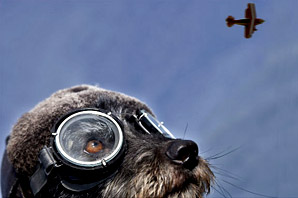 book
space on it ourselves. book
space on it ourselves.
Think of it: separate compartments — dog crates, that
is — with plenty of room to stretch out, flight attendants,
a pet lounge, escort from check-in to the plane and preboarding
walks. We wouldn’t recommend it for business travelers.
The trip from New York to Los Angeles — $250 one way —
does take about 24 hours. But that includes dinner, play time
and a sleepover in Chicago. No security hassles, no in-flight
movies, just the luxury of one’s doggie dreams in one’s
private cabin.
Yes, Pet Airways is yet another stage in the humanizing of our
pets, a process that has resulted in, among other things, Rachael
Ray pet food and animal health care and lifestyles beyond the
means of most of the humans on this planet. 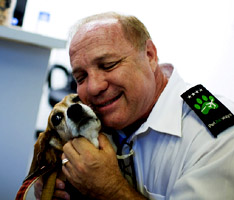
We worry, too, that as the transportation needs of pets increase
— quite separately from our own — it will mean,
of course, a new load of greenhouse gases in the atmosphere.
On the other hand, would business and diplomacy be handled so
much worse if we sent our dogs as proxies to negotiate on our
behalf?
The immediate overbooked success of Pet Airways suggests a growing
intolerance for the sometimes haphazard care of pets on the
national airlines. If Pet Airways succeeds, there may be an
economic lesson as well for the foundering human airlines. If
we had less stress at the airport and dinner on board, we, too,
would feel a lot happier about flying. |
 Op-Ed
Op-Ed
The First Hundred (Dog) Days
Translated from Woofish by BEN GREENMAN
July
16, 2009
BEFORE my arrival in the White House in April, I was not well
known to the American people. Perhaps  understandably,
I was greeted with some suspicion. understandably,
I was greeted with some suspicion.
“Portuguese water dog” has a foreign sound to it.
My hair covers my eyes, which can create the impression that
I am not trustworthy. From the first, I took it upon myself
not only to illustrate my own belief in clear thinking and accountability,
but to give the American people a sense of what their lives
would be like during my time in the White House. As I approach
the milestone of my first 100 days in office, I want to reiterate
some of my basic convictions.
Historically, my breed is used to herd fish in shallows or carry
messages from ships to the nearby shore, and I have tried to
show the American people that I will continue that tradition,
both leading (the fish) and communicating (the messages). I
have succeeded more than I have failed, but there have been
lapses. Remember when I bit that reporter’s microphone?
I had a sudden urge to get that thing. I thought it was a fish.
Even thinking about it now makes me jumpy. Another time the
president almost tripped over my leash, and even though that
wasn’t technically my fault, I take full responsibility.
My time in the White House thus far has had one driving theme:
we all share the same world. There have been those who have
criticized my willingness to sniff in an exploratory manner
around hostile breeds from foreign lands. But remember, we are
all one species, from the tiniest Chihuahua to the mightiest
mastiff. I have tried to practice this openness closer to home
as well, by spending more time with Joe Biden’s German
shepherd puppy, despite our considerable difference in temperament
and bite force.
The press likes to play a game where it compares my record with
that of other presidential pets. I find that premature and unhelpful.
Other presidential pets came to power in different times, and
faced different challenges.
Still, I would like to remark briefly upon the pet to whom I
am most often compared. Fala came to Franklin Delano Roosevelt
in November 1940, and quickly captured the national imagination.
But Fala lived in a time when there was an understanding between
the press and politicians, and many of his peccadilloes (his
habit of eating garbage, his eye for the ladies) were simply
overlooked.
By comparison, consider the way that the news media scrutinized
Buddy, the Clintons’ Labrador. Before his untimely death
by car accident in 2002, Buddy was persistently maligned by
rumors that he did not get along with Socks the cat, as if that
were his fault. (Cats, need I remind you, are jerks.)
In the end, while it is all well and good to compare this dog
with that dog, any honest and forthright White House pet must
acknowledge that we are all standing in the long shadow cast
by Dash, the brilliant, charming, perfect-tailed collie mix
owned by President Benjamin Harrison’s wife, Caroline.
Dash responded to voice commands with great efficiency, never
demonstrated undue unruliness and still found time to pursue
his own interests. I use his example to remind myself that there
is always room for improvement, and that we should never fail
to aspire to perfection, even as we know that we cannot reach
it. Excuse me: I must chase a ball.
O.K., I’m back. As we head into the second hundred days
of my administration, I feel more pride and pleasure than ever
at the prospect of serving the American people and finding ways
to make this nation, and this planet, a better place for our
children and our children’s children. I am speaking metaphorically
here, of course, as I am neutered.
This has been a rewarding but difficult time for our nation,
yet I remain confident of our prospects so long as I spend every
day with at least three feet on the ground — four is a
little optimistic, if you know what I mean.
Thank you. |
 Wire
Services Wire
Services
Weird but True
July
16, 2009
A
2-year-old from Pennsylvania is so talented at hide-and-seek
that her family had to call cops and firefighters to find her.
Natalie Jasmer, of Greenville, was missing for an hour as rescuers
frantically searched the area. But the hero was the family's
dog, Cooper, who found the toddler in a drawer underneath the
washing machine. |

Smokey and BBQ Fork:
Chihuahua OK after freak accident
By Dean Manning
July
13, 2009
LONDON, Ky -- After two days on the run and a day recovering
after a vet removed a meat fork from 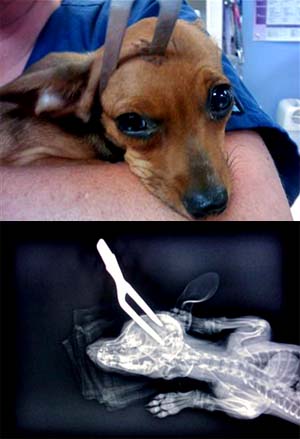 his
head, 12-week-old Smokey the Chihuahua is back home with his
family. his
head, 12-week-old Smokey the Chihuahua is back home with his
family.
According to Dr. Mark Smith at Cumberland Valley Animal Hospital,
Smokey was brought into the office Tuesday with about six inches
of the meat fork’s prongs sticking into his head.
Hughie Wagers, who brought his nephew’s dog to the vet,
told the staff that someone had been using the meat fork to
rake scraps onto the plates for the family’s dogs.
“There was another big dog and they were trying to shoo
it away so Smokey could eat,” Smith said. “The handle
to the fork broke, sending the prongs flying into the dog.”
Smokey ran away and hid after the accident, and his owners were
unable to find him. He returned home two days later, with the
fork still in his head.
“We didn’t know what to do,” Wagers said.
“I had to take it to the vet.”
Smith said when Smokey was brought in, he didn’t appear
to be in pain. “He was acting like nothing was wrong with
him unless you touched the fork,” Smith said. Smith said
it wasn’t technically surgery as he didn’t have
to make any incisions to remove the fork. “All I did was
anesthetize Smokey, disinfect the area around the fork, grab
it and pull it out,” Smith said.
Smokey appears to be recovering, and Smith said the wounds should
heal completely. “The skull will granulate over the holes,”
Smith said.
Smith has ordered six weeks of bed rest for Smokey as a precaution.
“He is confined to a cage,” Smith said. “Maybe
once in a while, he can be let on the couch to watch Oprah.”
Smith said he has never seen anything like this in 25 years
working with animals. “The only place I have seen something
similar is on Discovery Channel when you have seen someone fall
and have rebar sticking through them.”
To
view TODAY
Show interview click √
on logo >
 |
 DOGGY
DEATH FUROR
DOGGY
DEATH FUROR
'OD' LAWSUIT VS. VET
By WILLIAM J. GORTA
July
13, 2009
A well-known Manhattan veterinary clinic poisoned a beloved
family dog with a lethal mixture of too  much
chemotherapy and an unauthorized blood transfusion, according
to a lawsuit. much
chemotherapy and an unauthorized blood transfusion, according
to a lawsuit.
Marshall Allan and Karen LaGatta Allan claim a vet at the Animal
Medical Center on East 62nd Street gave Hans (left
in photo with Mitzi), their 3-year-old miniature
dachshund, an intense dose of chemotherapy -- medicine that
was 10 times more powerful than what the pooch was prescribed.
Hans, severely weakened by the massive dose, died after having
a heart attack during a blood transfusion that the hospital
decided on its own to administer -- using a "young inexperienced
veterinarian," the suit alleges.
"The AMC's fine reputation for pet care is a sham,"
the Allans said in the suit filed in Manhattan Supreme Court.
The heartache began last October when Hans developed a cancerous
growth under his right eye.
The pooch began a course of chemo using two drugs in alternating
visits but needed to be hospitalized for fever after the first
session in December -- after which doctors promised to cut the
dosage, according to court papers. A second round of chemotherapy
with the alternate drug went smoothly, but after Hans returned
on March 9 for his third treatment, he began vomiting the moment
he got home.
He was admitted for emergency care the next day.
On March 11, a doctor, blaming a "math error," confirmed
to the Allans in an e-mail that Hans was given 10 times the
correct dosage, the suit says.
Doctors told Marshall Allan the dog would bounce back, but after
he left the hospital an inexperienced vet gave Hans a transfusion,
sending the dog into cardiac arrest, the suit said. Hans died
after 90 minutes of failed attempts to revive him.
"This has been a heartbreaking and devastating loss,"
said the couple's lawyer, Larry Hutcher.
The Animal Medical Center replied that it has a history of providing
outstanding medical treatment to pets. |
 Wire
Services Wire
Services
Weird but True
Kathianne
Boniello
July
13, 2009
A
British couple is making a stink in their bid to find their
missing Dog.
Jonathan
and Louise Baltesze have been sprinkling their neighborhood
with their own urine in an effort to induce their Black Labrador,
Simon, to return. The couple is trying to mark their territory
as a wy to attract the stray pooch, on the advice of an animal-behaviour
expert.
|
 Presidential
pets, from Washington's to Obama's, examined in 'First Dogs'
Comments
Presidential
pets, from Washington's to Obama's, examined in 'First Dogs'
Comments
July
9, 2009
|
Everything
you've ever wanted to know about presidential dogs
is covered in a new book, First Dogs: American Presidents
and Their Best Friends (Algonquin Books of Chapel
Hill, $9.99).
The doggone little book looks at canine cuties from
the time George Washington took office. Washington
had several "French import" hounds, and
the the nation has been fascinated with presidential
dogs ever since.
The book is full of tidbits such as the suspicion
that Richard Nixon used his cocker spaniel Checkers
to win public sympathy.
Of course, today the most famous top dog is Bo, a
Portuguese water dog owned by President Barack Obama
and family.
Photo:
Yuki,
howling for then President Lyndon Johnson
|
Visit
our Presidential
Pooches page at From-The-DOGHOUSE.com

Click√on
imageΔ
|

Cops
Forced to Kill Attacking Pit Bull on Upper East Side
Eileen Lehpamer
09
July 2009
NEW
YORK -- Several police officers are recovering Thursday
morning after they were forced to shoot an attacking pit bull
inside an Upper East Side housing project.
The shooting occurred as the officers respond to a call of
an assault with a gun at the Isaacs Houses near the intersection
of First Avenue and East 94th Street around 10 p.m. last
night, police said.
As police investigated the disturbance at an apartment on
the 11th floor a raging pit bull was "deliberately"
let loose on them by the woman who opened the door, police
said. Three officers were bitten or scratched by the
dog before it was shot and killed.
Three officers and the woman were struck with bullet fragments
as the bullets richocheted through the narrow hallway. One
officer was struck under the eye, another officer was hit
in the hand, and a third was hit on the side of his nose.
No weapon was found inside the apartment. The woman
was struck in the hand.
There was a brief standoff after the shooting as several people
barricaded themselves inside the apartment, however they all
eventually surrendered.
|
 $5,000 Reward
in Long Island Dog Torture Case
$5,000 Reward
in Long Island Dog Torture Case
06
July 2009
MANORVILLE, N.Y. (AP) -- Animal welfare groups have
increased the reward for information that leads to a conviction
in a Long Island dog torture case.
A bicyclist found four badly decomposed pit bulls a week ago
in the woods in Manorville.
Suffolk County SPCA official Roy Gross says the animals were
mutilated, and one appeared to have a broken neck.
The Suffolk SPCA and the Humane Society of the U.S. are now
offering a $5,000 reward.
Anyone with information is asked to call 631-382-7722. Calls
will be kept confidential. |
 Wire
Services Wire
Services
Weird but True
By LUKAS I. ALPERT, WIRE SERVICES
July
2, 2009
El
perro se comió mi pasaporte ~
That explanation didn't help an Eau Claire, Wis., teen, who
missed a trip to Peru with his Spanish class after his golden
retriever, Sunshine, chowed down on his passport.
Officials at Chicago's O'Hare Airport told 17-year-old Jon Meier
the chewed document was fine, but authorities in Miami wouldn't
let him board the Peru-bound plane because some numbers were
gnawed.
Meier says he can't be angry at anyone, not even Sunshine. "I
love her too much," he said.
• •
•
July
1, 2009
El
perro se comió mi pasaporte ~
A Washington state woman accused of dipping into her ex-husband's
bank account is blaming her dog for eating her checkbook.
Kristin Banfield, 50, said she needed to pay her utility bills
and had no choice but to steal from her ex.
She's been charged with identity theft and forgery.
|

HASIDIC OFFICER IN SUBWAY CANINE FRACAS
By REUVEN FENTON and REUVEN BLAU
July
1, 2009
The city's first Hasidic cop was excoriated in a anti-Semitic
rant by a dog-loving subway passenger who 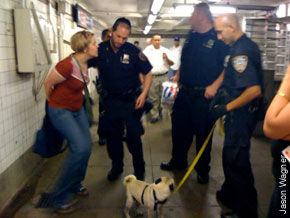 allegedly
refused to place her sick pet in an animal carrier, sources
and a witness said yesterday. allegedly
refused to place her sick pet in an animal carrier, sources
and a witness said yesterday.
Brooklyn blogger Chrissie Brodigan claimed Officer Joel Witriol
went ballistic when he saw her take her pug, Dempsey, out
of her purse in violation of subway regulations at around
5:30 p.m. Monday. She said he cuffed her, insulted her and
roughed her up.
But a witness, Viane Delgado, said Brodigan was the one out
of line. Delgado said Witriol "repeatedly" asked
the woman to place the barking pug in a carrier she had. But
instead, she allegedly insulted him with anti-Semitic slurs
and tried to walk away. "You f---ing Jew, you're not
even human," Delgado quoted Brodigan as saying. She repeatedly
said, "Jewish people think they own everything,"
a source said.
But Brodigan denied that account. "I don't remember saying
anything anti-Semitic," she said. "I do remember
saying, 'Clearly, you have trouble with women.' I probably
called him an a--hole."
According to her account, Witriol "said he needed to
talk to me" as she was ascending a staircase at the L-line
Bedford Avenue station. "He pushed me against the wall
and said, 'I need your name and
ID.' "
Brodigan, 32, said that when she told Witriol she had left
her wallet at work, things turned ugly.
"He pushed me against the wall and said, 'If you're gonna
act like a woman, I'm gonna treat you like a woman,' "
said Brodigan. The blogger denied she had a carrying case
with her and said her dog suffers from a health condition
that causes it to overheat.
She claims that when she started to walk away, "he handcuffed
my wrist, pushed me against the wall, punched me in the back
and kicked me in the shin." She also claimed Witriol
at one point put his hands on her breasts.
Melissa Randazzo, 29, another witness, backed up Brodigan's
story. "His tone was really alarming," Randazzo
said of Witriol. "The girl looked scared. She didn't
look like someone who would get into trouble. Something didn't
seem right about this situation."
Witriol's family would not comment on the case last night.
The NYPD said that there's no record of any impropriety on
the part of Witriol and that Brodigan was given a summons
for failing to identify herself and for not having a dog in
a proper container. A police source said Brodigan was belligerent
and argumentative.
Brodigan claimed the cop took away her pug and threatened
he'd have it "put down."
|
|





